Sony Group PCG9D1R Notebook Personal Computer with built in WLAN card User Manual Kingfisher UG
Sony Corporation Notebook Personal Computer with built in WLAN card Kingfisher UG
Contents
- 1. Users manual 1
- 2. Users Manual 2
Users Manual 2

1
Contents
Welcome.......................................................9
Using Your VAIO Computer .....................11
Using the Keyboard...................................................12
Combinations and functions with the Windows key .........14
Indicators ...........................................................................15
Indicator lights...................................................................15
Combinations and functions with the Fn key ....................16
Using the Touchpad ..................................................18
VAIO Action Setup...................................................20
Using the Center Jog Dial Control ............................21
Using the center Jog Dial Control......................................21
Launcher mode ..................................................................22
Guide mode........................................................................23
Center Jog Dial back button...............................................23
Using the center Jog Dial Control with Sony software .....24
Using the center Jog Dial Control with other software .....24
Using the Optical Disc Drive ....................................25
To insert a disc...................................................................25
To eject a disc ....................................................................26
To play a DVD...................................................................27
To play an audio CD..........................................................28
Notes on CD and DVD discs .............................................28
To write data to a CD-RW or CD-R disc...........................29
Kingfisher Draft 2

Change text in this variable definition to document title.
2
Using PC Cards.........................................................30
To insert a PC Card........................................................... 30
To remove a PC Card........................................................ 31
Using Memory Stick Media ....................................32
Types of Memory Stick media.......................................... 32
Write-protecting Memory Stick media ............................. 34
Formatting Memory Stick media ...................................... 34
Notes on using Memory Stick media................................ 35
Using the Multipurpose Bay.....................................37
To install a device into the multipurpose bay ................... 37
To remove the device from the multipurpose bay ............ 38
Notes on using a device in the multipurpose bay.............. 38
Using the Floppy Disk Drive....................................39
To insert a floppy disk into the floppy disk drive............. 39
To remove a floppy disk from the floppy disk drive ........ 40
Notes on handling floppy disks......................................... 40
Using Power Saving Modes......................................41
Normal mode..................................................................... 41
Standby mode.................................................................... 41
Hibernate mode................................................................. 41
Notes on power saving modes .......................................... 42
Using a Telephone Cable..........................................43
Using a Local Area Network ....................................44
Setting up your Ethernet connection................................. 44
Kingfisher Draft 2

3
Using Wireless LAN .................................................45
Turning On Wireless LAN ................................................45
The Wireless LAN Access Point .......................................46
Communicating with an Access Point (infrastructure)......47
Communicating without an access point (ad-hoc).............48
Checking your connection status .......................................50
Turning Off Wireless LAN................................................50
Notes on using Wireless LAN ...........................................51
Connecting Peripheral Devices ...............53
Connecting a USB Device.........................................54
To connect a USB device...................................................54
Connecting a USB Printer.........................................55
To connect a USB printer ..................................................55
Connecting a Parallel Port Printer.............................56
To connect to a parallel port printer...................................56
Connecting an Audio Device ....................................57
To connect an audio device ...............................................57
Connecting an Audio-Video Device .........................58
To connect an AV device...................................................58
To change the display ........................................................59
Connecting an i.LINK Audio-Video Device.............60
To connect a digital video camera recorder.......................60
Notes on connecting an i.LINK device..............................61
Connecting an External Display................................62
To connect a computer display ..........................................62
To connect a multimedia computer display.......................62
To connect a projector .......................................................63
Changing the display when connecting an external computer
display or projector ............................................................64
Kingfisher Draft 2

Change text in this variable definition to document title.
4
Connecting with another VAIO computer................65
To connect two VAIO computers ..................................... 65
Connecting External Speakers..................................67
To connect external speakers............................................ 67
Notes on connecting external speakers ............................. 67
Connecting an External Microphone ........................68
To connect an external microphone.................................. 68
To record from a microphone or audio device.................. 68
Adjusting the volume........................................................ 69
Expanding Your Computer Capabilities...................71
Personal Digital Assistant ................................................. 71
Wireless LAN Access Point.............................................. 71
Wireless LAN PC Card..................................................... 72
Customizing Your VAIO Computer..........73
Displaying the Sony Notebook Setup Screen...........74
To display the Sony Notebook Setup screen: ................... 74
Sony Notebook Setup tabs ................................................ 75
Controlling Power Management...............................76
Viewing the Power Management status icons .................. 76
Power Management profiles ............................................. 77
Power Management commands ........................................ 79
Conserving battery power ................................................. 79
Displaying Battery Information................................81
Battery icon descriptions................................................... 82
Displaying detailed battery information ........................... 82
Selecting the Display Mode......................................84
Changing the window design of Sony software................ 86
Display Properties Notes................................................... 86
Kingfisher Draft 2

5
Adding Memory .........................................87
Precautions and Procedures.......................................88
Typical Expansion Memory Configuration...............89
Models with 256 MB Memory ..........................................89
Removing a Memory Module ...................................90
Installing a Memory Module.....................................92
Confirming Added Memory Capacity.......................93
About the Software on Your Notebook ...95
Software Overview....................................................96
Software Support Information.................................102
Sony Service Center.........................................................103
Using the Recovery CDs.........................105
Application, Driver, and System Recovery CDs.....106
Using Your Recovery CDs......................................107
To use the Application Recovery CD(s)..........................107
To use the Driver Recovery CD(s) ..................................108
To use the System Recovery CD(s).................................109
Troubleshooting......................................113
Troubleshooting Your Computer ............................114
My computer does not start. ............................................114
My computer starts but a BIOS error appears. ................114
My computer starts, but the message “Operating system not
Kingfisher Draft 2

Change text in this variable definition to document title.
6
found” appears, and Windows does not start.................. 115
My computer stops responding or does not shut down... 116
The power management does not respond...................... 117
The sound of my computer’s fan is too loud. ................. 117
Why does the System Properties dialog box display a slower
CPU speed than advertised?............................................ 117
Troubleshooting the LCD Screen ...........................118
My LCD screen is blank. ................................................ 118
My LCD screen continues to show the previous screen. 118
The image on my connected external display is not centered
or sized properly.............................................................. 118
I want to change the video resolution of my display. ..... 118
I want to change the display resolution for AV Out. ...... 118
I cannot switch the LCD display to TV and vice versa. . 119
Troubleshooting the Mouse and Touchpad ............120
My mouse does not work................................................ 120
My touchpad does not work properly. ............................ 120
The pointer does not move when I use the Touchpad or
Mouse.............................................................................. 121
Troubleshooting Drives, PC Cards, and Peripheral
Devices....................................................................122
My floppy disk drive icon doesn’t appear even though it is
connected. ....................................................................... 122
My floppy disk drive cannot write to a floppy disk........ 122
My optical drive is not playing my CD or DVD properly....
122
Why does it take longer for the optical disc drive to read
some types of CDs?......................................................... 123
My optical drive tray does not open................................ 123
I cannot use Digital Video (DV) devices. The message “DV
equipment seems to be disconnected or turned off” appears.
Kingfisher Draft 2

7
123
My PC Card does not work..............................................124
Troubleshooting the Software .................................125
My software program stops responding or crashes. ........125
When I click an application icon, the message “You must
insert the Application CD into your optical drive” appears,
and the software does not start.........................................125
The application cannot find a file while a PC Card is
inserted.............................................................................125
What software do I use for CD-R/CD-RW software
functions?.........................................................................125
I cannot use the DVgate software....................................126
Troubleshooting i.LINK Devices............................127
I cannot establish a connection between two VAIO
computers when using an i.LINK cable...........................127
Troubleshooting the Modem ...................................128
My modem does not work. ..............................................128
My modem connection is slow. .......................................128
Troubleshooting Audio ...........................................129
My speakers have no sound.............................................129
There is noise distortion while listening to music with USB
speakers or USB headphones...........................................130
My microphone does not work. .......................................131
Troubleshooting Memory Stick Media ...................132
I cannot open image files.................................................132
Memory Stick media does not work. I cannot access the
removable drive. ..............................................................132
Troubleshooting Wireless LAN Functions .............133
The computer cannot connect to a Wireless LAN Access
Kingfisher Draft 2

Change text in this variable definition to document title.
8
Point. ............................................................................... 133
I cannot access the Internet. ............................................ 133
The data transfer speed is slow. ...................................... 134
The communication speed is interrupted or slowed down
when MPEG2 data is transferred.................................... 134
Data transfers are interrupted.......................................... 134
Troubleshooting the Printer ....................................135
I cannot print................................................................... 135
Getting Help.............................................137
Support Options......................................................137
Kingfisher Draft 2

9
Welcome
Congratulations on your purchase of this Sony VAIO® computer, and
welcome to the VAIO User Guide.
This User Guide provides detailed information on all aspects of using
your new VAIO computer, from keyboard functions to preinstalled
software applications.
In the left navigation window, click the topics you want to learn more
about, and that information will be displayed in this main window.
✍Click here to find the latest updates and supplemental information about your
computer.
Kingfisher Draft 2

Change text in this variable definition to document title.
10
Kingfisher Draft 2

11
Using Your VAIO Computer
This section describes the following aspects of your new computer:
❑Using the Keyboard
❑Using the Touchpad
❑Using the Center Jog Dial Control
❑Using the Optical Disc Drive
❑Using PC Cards
❑Using Memory Stick Media
❑Using the Multipurpose Bay
❑Using Power Saving Modes
❑Using a Telephone Cable
❑Using a Local Area Network
❑Using Wireless LAN
Kingfisher Draft 2
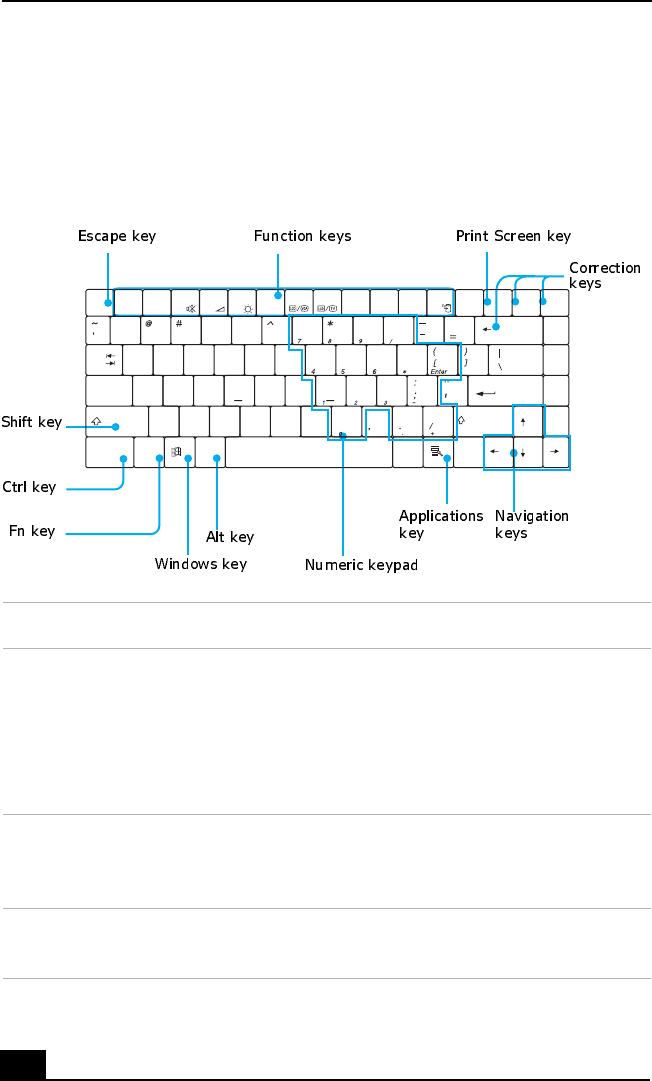
Change text in this variable definition to document title.
12
Using the Keyboard
Your computer’s keyboard is very similar to that of a typewriter, but the keyboard
has additional keys that perform specific computer-related tasks.
Keyboard
Key Description
Numeric keypad Contains the keys found on a typical calculator. Use the
numeric keypad area to type numbers or to perform
mathematical calculations such as addition and subtraction.
Note that you must press the Num Lock key to activate the
numeric keypad. (When you do so, the Num Lock light will
be on.) Press the Num Lock key again to deactivate it.
Navigation keys The Left/Right/Up/Down arrow keys are devoted to move the
cursor on the screen, and also function as the Home, End,
Page Up, and Page Down keys, respectively.
Correction keys The Insert, Back Space, and Delete keys enable you to make
corrections in your documents.
Esc F1 F2 F3 F4 F5 F6 F7 F8 F9 F10 F11 F12 NumLk
Scr Lk Prt Sc
SysRq Insert
Pause Delete
Break
Tab
Caps Lock
Shift
Shift
Ctrl Ctrl
Home
Page
Up
Page
Down
End
Fn Alt Alt
Z
A
Q
X
S
W
C
D
E
V
F
R
B
G
T
N
H
Y
M
J
U
<
K
I
>
L
O
?
P
2134567890
!$% & ( )
Enter
+
Backspace
Kingfisher Draft 2

Using the Keyboard
13
Function keys The 12 function keys along the top of the keyboard are used
to perform designated tasks. For example, in many
applications, F1 is the Help key. The task associated with
each function key may vary from one application to the next.
Escape key The Esc (Escape) key is used to cancel commands.
Print Screen key The Print Screen key takes an electronic snapshot of the
screen and places it in the Windows® Clipboard. You can
then paste the screen shot into a document and print it.
Operator keys
(Shift, Ctrl, Alt
keys)
Several keys are always used with at least one other key: Ctrl,
Alt, and Shift. When held down with another key, the Ctrl
(Control) and Alt (Alternate) keys offer another way to give
commands. For example, in many applications, instead of
choosing the Save command from a menu, you can hold
down Ctrl and press S (referred to as Ctrl+S). The Shift key
operates the same way as on a typewriter; it is used to
produce capital letters or special symbols such as @ and $.
Windows key The key with the Windows logo displays the Windows Start
menu; it is the equivalent of clicking the Start button on the
taskbar. See “Combinations and functions with the Windows
key” for more information.
Fn key The Fn key is used in combination with other keys to issue
commands. See “Combinations and functions with the Fn
key” for more information.
Applications key The Applications key displays a shortcut menu of context-
sensitive choices. Pressing this key is the equivalent of
clicking the right mouse button.
Key Description
Kingfisher Draft 2

Change text in this variable definition to document title.
14
Combinations and functions with the Windows key
Combination Function
+ F1 Displays the VAIO Help and Support Center window.
+ Tab Switches the selected button on the taskbar.
+ D Displays the desktop.
+ E Displays the My Computer window.
+ F Displays the Search window to find a file or folder. This is
the equivalent of selecting Search from the Start menu.
+ Ctrl + F Displays the Search Results: Computers window where you
can locate other computers. This is the equivalent of selecting
Search and then Computers from the Start menu.
+ M Minimizes all displayed windows.
Shift + + M Returns all minimized windows to their previous size.
+ R Displays the Run window. This is the equivalent of selecting
Run from the Start menu.
Fn + + Insert Displays the Properties window. This is the equivalent of
selecting Control Panel and then System from the Start menu.
Kingfisher Draft 2

Using the Keyboard
15
Indicators
Indicator lights
Indicator Function
Power Light is green when the power to the computer is turned on,
flashes amber in Standby mode, and turns off when the
computer is in Hibernate mode or powered off.
Battery Indicates the status of the battery inserted in the battery bay.
Memory Stick Indicates that the Memory Stick® slot is in use.
Hard disk This indicator will light when data is being read from or
written to the hard disk. Do not enter Standby mode or turn
off the computer when this indicator is on.
Light On Off
Num Lock The number keys in the numeric
keypad are active.
The alphanumeric character keys
in the keypad area are active.
Caps Lock The letters appear in uppercase as
you type. The Shift key lowers the
case of typed letters when Caps
Lock is on.
Letters appear in lower case as
you type (unless you hold down
the Shift key).
Scroll LockThe screen scrolls differently.
(Exactly how it scrolls depends on
the specific application. It has no
effect in many applications.)
Information moves across the
display normally.
Kingfisher Draft 2
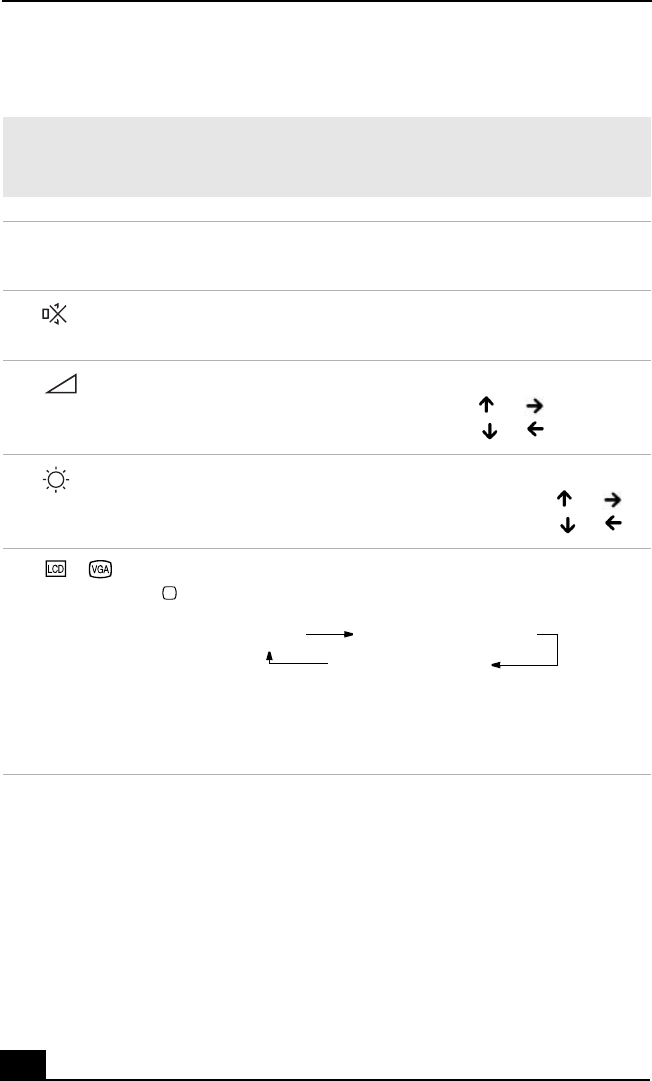
Change text in this variable definition to document title.
16
Combinations and functions with the Fn key
✍If you switch user identities during a computing session, the Fn+F7 and Fn+F8 key
functionality (if available on your computer) will be interrupted. To switch to an
external display or monitor, see “Selecting the Display Mode” for more information.
Combinations/
Feature Function
Fn+ (F3)
Mute On/Off
Toggles the built-in speaker off and on.
Fn+ (F4)
Speaker volume
Adjusts the built-in speaker volume.
To increase volume, press Fn+F4, then or .
To decrease volume, press Fn+F4, then or .
Fn+ (F5)
Brightness control
Adjusts the brightness of the LCD.
To increase light intensity, press Fn+F5 and then or .
To decrease light intensity, press Fn+F5 and then or .
Fn+ /
(F7)
Switch to the
external
monitor/LCD
Toggles through the LCD, external display (connected to the
Monitor port) and both LCD and external display.
Select one display at a time to playback DVDs. Connect the
cable before you turn on the notebook, otherwise Fn + F7
will not work.
Only LCD LCD and external display
Only external display
Kingfisher Draft 2
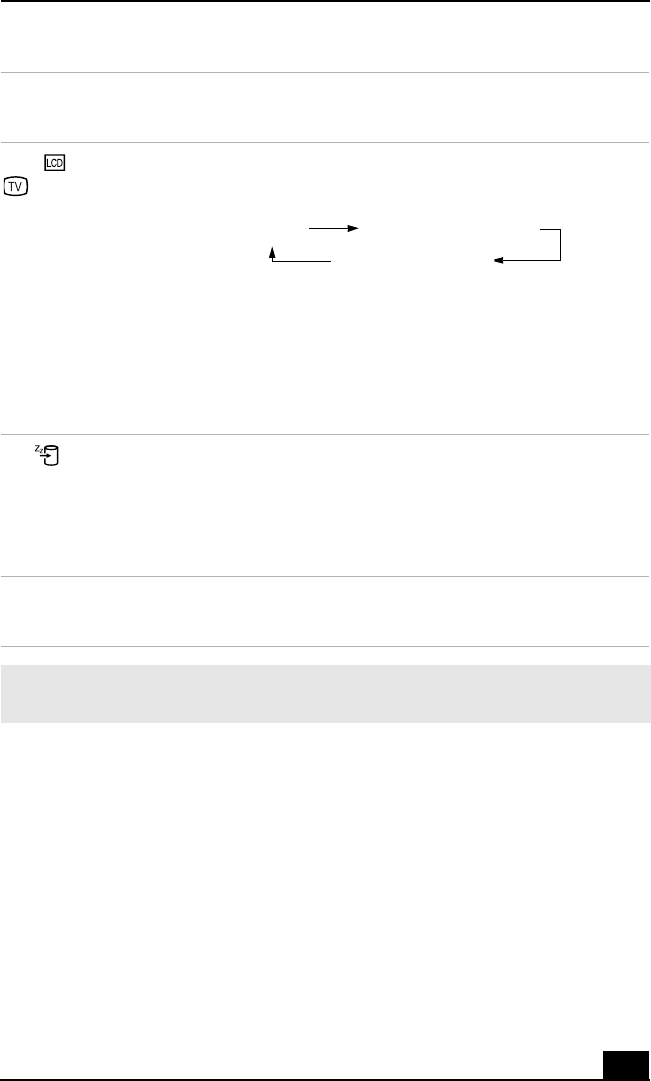
Using the Keyboard
17
Fn+ only/
(F8)
Control AV Out
Toggles between LCD-only and dual LCD/TV display
modes.
Select one display at a time to playback DVDs. Connect the
cable before you turn on the notebook, otherwise Fn + F8
will not work. You cannot use the Fn + F8 function to switch
between LCD and TV once a DVD is inserted into the optical
disc drive.
Fn+ (F12)
Hibernate
Provides for the lowest level of power consumption.
When you run this command, the state of the system and state
of the peripheral devices are written to the hard disk and the
system power is turned off. To return the system to its
original state, use the power button to turn on power.
Fn+Esc
Standby
Puts the system into Standby mode, a power management
state. To return the system to the active state, press any key.
✍You can also carry out these functions using the center Jog Dial™ Control. Some
functions are not available until Windows® launches.
Combinations/
Feature Function
Only LCD LCD and external display
Only external display
Kingfisher Draft 2
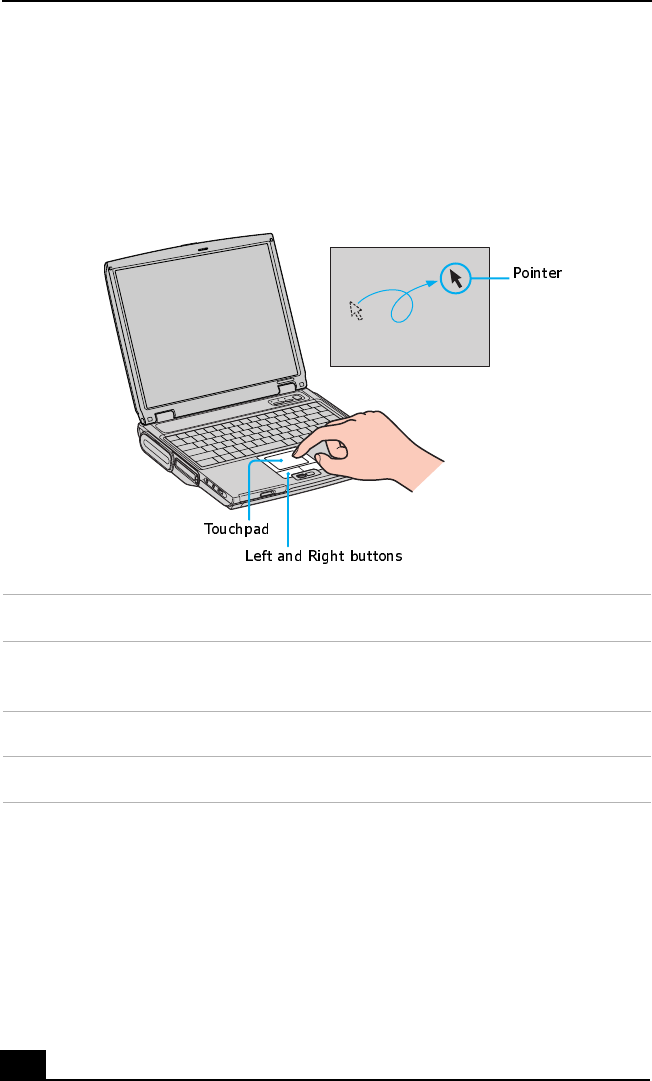
Change text in this variable definition to document title.
18
Using the Touchpad
The keyboard contains a cursor-pointing device called a touchpad. You can point
to, select, drag, and scroll objects on the screen using the built-in touchpad.
Touchpad
Action Description
Point Slide one finger on the touchpad to place the pointer on an
item or object.
Click Press the left button once.
Double-click Press the left button twice.
Kingfisher Draft 2

Using the Touchpad
19
The Mouse Properties dialog box lets you customize your mouse and touchpad
features, such as touch sensitivity, motion, and buttons.
To open the Mouse Properties dialog box
1Click Start on the Windows® taskbar, and then Control Panel.
2Click Printers and Other Hardware, and then Mouse. The Mouse Properties
dialog box opens.
Right-click Press the right button once. In many applications, this action
displays a shortcut menu of context-sensitive choices.
Drag Slide one finger while pressing the left button.
Scroll Move your finger along the right edge of the touchpad to
scroll vertically. Move your finger along the bottom to scroll
horizontally. (The scroll function is available only with
applications that support a touchpad scroll feature.)
Action Description
Kingfisher Draft 2

Change text in this variable definition to document title.
20
VAIO Action Setup
VAIO Action Setup manages the settings for your notebook’s center Jog Dial™
Control, Memory Stick® media, and i.LINK®* interface. An overview of some
of the functions controlled by VAIO Action Setup is provided in this section. For
more information on changing the settings using VAIO Action Setup, right-click
the Jog Dial Utility icon or in the taskbar and click Help Topics.
* i.LINK is a trademark of Sony used to designate that a product contains an IEEE 1394 con-
nection. The i.LINK connection may vary, depending on the software applications, operating
system, and compatible i.LINK devices. All products with an i.LINK connector may not
communicate with each other. Refer to the documentation that came with your compatible
i.LINK device for information on operating conditions and proper connection. Before con-
necting compatible i.LINK PC peripherals to your system, such as a CD-RW or hard disk
drive, confirm their operating system compatibility and required operating conditions.
Kingfisher Draft 2
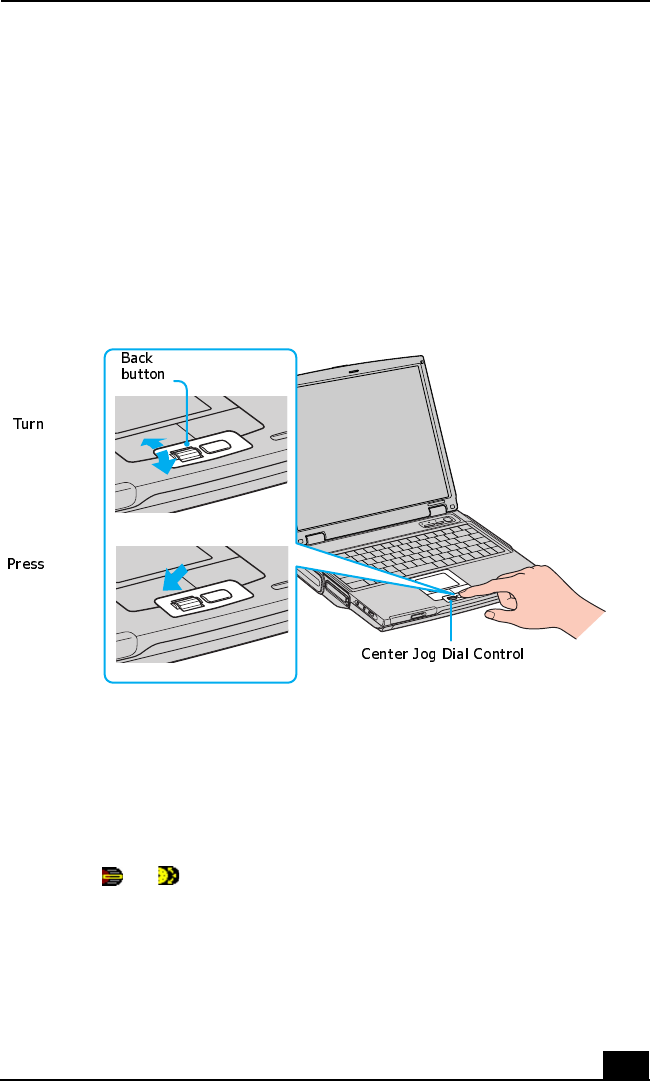
Using the Center Jog Dial Control
21
Using the Center Jog Dial Control
Your notebook is equipped with a center Jog Dial™ Control located below the
left and right buttons. The center Jog Dial Control enables you to open an
application, folder, or document from a predefined list by rotating and pressing
the center Jog Dial Control. In addition, when you press the center Jog Dial
Control, you can turn on your notebook automatically and start the selected
application or document.
The center Jog Dial Control window always appears in the display. It is either in
the launcher mode or in the guide mode.
Using the center Jog Dial Control
This section explains how to use the center Jog Dial Control. For information on
how to change the settings of the center Jog Dial Control, right-click the Jog Dial
Utility icon or in the taskbar and click Help Topics.
Center Jog Dial Control
Kingfisher Draft 2
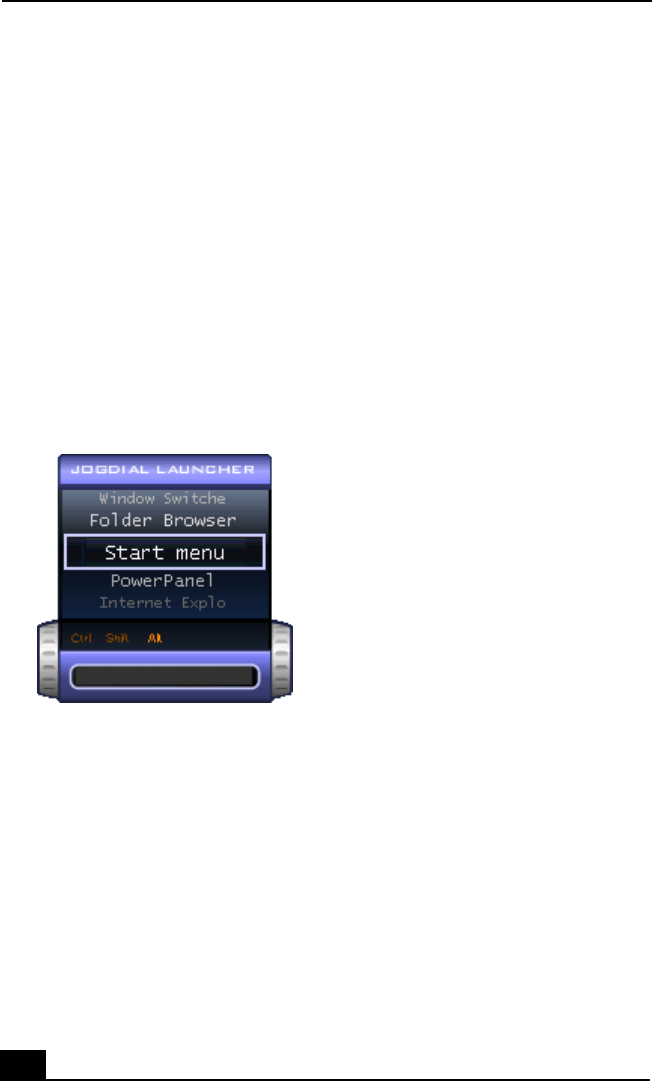
Change text in this variable definition to document title.
22
Launcher mode
The center Jog Dial Control window is in launcher mode until a software
application is launched or the Jog Dial Control window becomes active. When
you select an item in the Jog Dial Control window and it is displayed between
orange bars, you can press the center Jog Dial Control to view a submenu of that
item.
Using Launcher mode
To use the center Jog Dial Control, click the Jog Dial Control window or the Jog
Dial Utility icon in the taskbar. Alternatively, you can press the Ctrl key and the
center Jog Dial Control while the Jog Dial Control window is active to switch to
launcher mode.
To select a desired item, proceed as follows:
Jog Dial Launcher
Kingfisher Draft 2
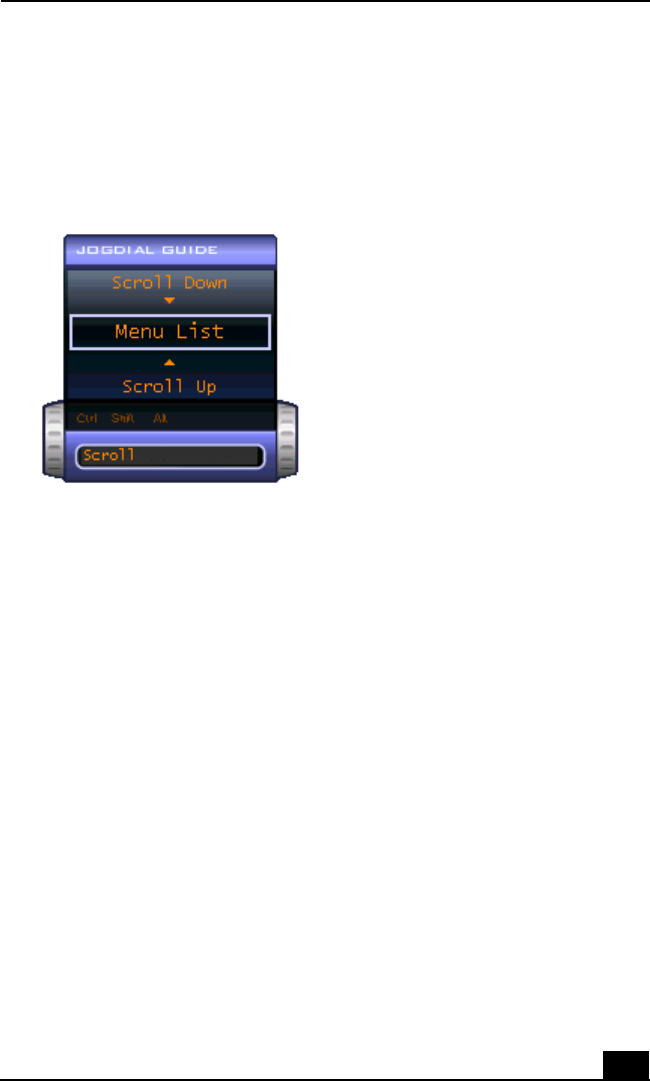
Using the Center Jog Dial Control
23
1Rotate the center Jog Dial Control to select the item you want, and then press
the center Jog Dial Control. The Jog Dial Launcher window switches to
guide mode and shows the function of the center Jog Dial Control.
2Rotate or press the center Jog Dial Control to use the desired function.
3To select another item, repeat steps 1 through 3 above.
Guide mode
The Jog Dial Control window is in the guide mode when software is in use and
the software window is active. Depending on the software you are using, you can
select items from the displayed list using the center Jog Dial Control. You can
switch between guide mode and launcher mode by pressing the Ctrl key and the
center Jog Dial Control.
Using Guide mode
The Jog Dial Control window displays the function of the center Jog Dial
Control.
Center Jog Dial back button
The center Jog Dial Control includes a back button located to the right of the
control. Pressing this button brings you back to the previous screen.
Jog Dial Guide
Kingfisher Draft 2
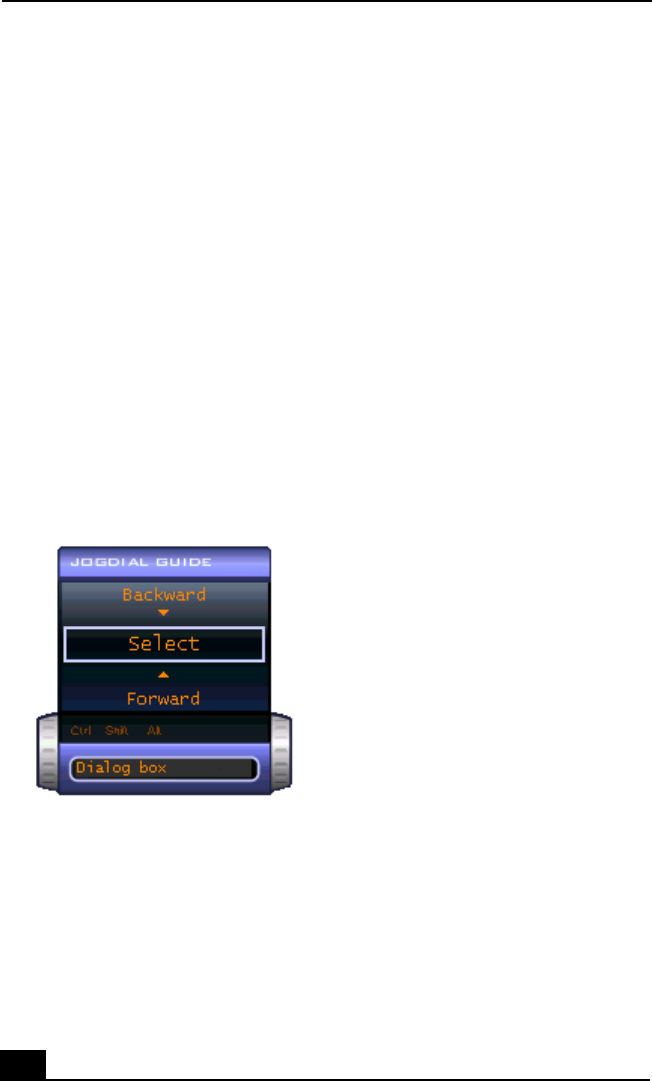
Change text in this variable definition to document title.
24
Using the center Jog Dial Control with Sony software
If Sony software that supports the center Jog Dial Control is active, you can use
the functions of the center Jog Dial Control that are allocated to that software.
For more information on functions allocated to software, see the software
application’s Help.
Using the center Jog Dial Control with other software
If the software you are using supports the center Jog Dial Control, you can still
use the center Jog Dial Control to scroll the window or adjust the window size.
Using a Dialog box
When a window such as Screen Properties is active, the Dialog box is displayed
in the Jog Dial window. You can select an item in the window by rotating the
center Jog Dial Control. Pressing the center Jog Dial Control is the equivalent of
pressing Enter or Select.
Jog Dial Guide Dialog Box
Kingfisher Draft 2
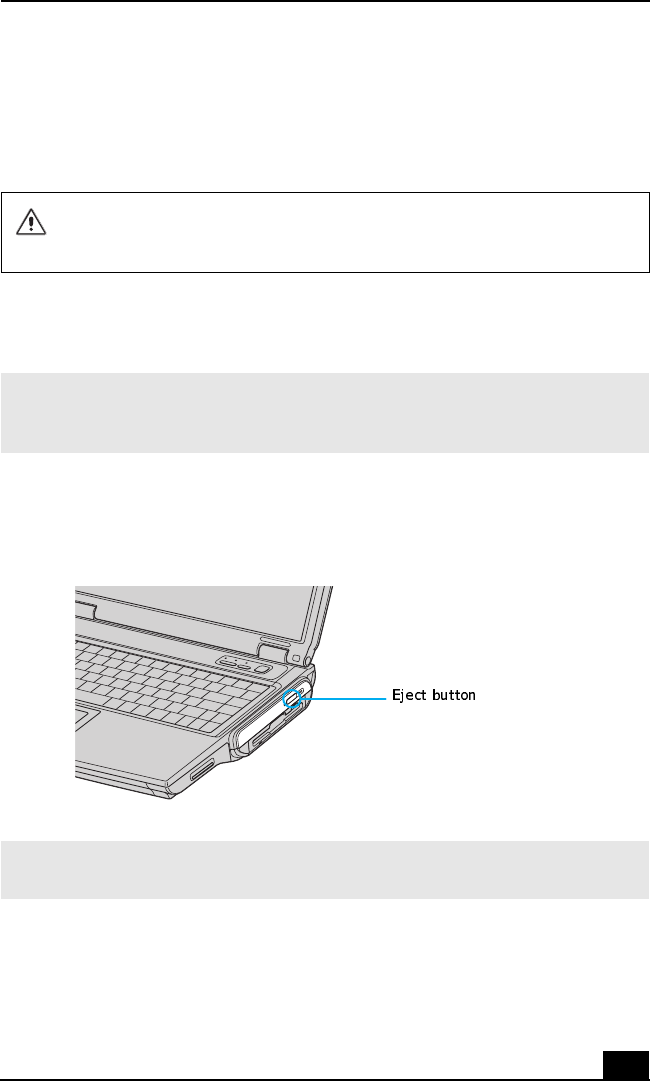
Using the Optical Disc Drive
25
Using the Optical Disc Drive
Your notebook comes with a removable optical disc drive located in the
multipurpose bay. See the Specifications sheet for the particular drive installed
on your computer.
To insert a disc
1Turn on the notebook.
2Press the Eject button to open the optical disc drive. The tray slides out.
3Place an optical disc on the tray with the label side facing up. For DVDs that
can played on both sides, the side of the disc facing up is the side that plays.
4Press the disc onto the hub until the disc clicks securely into place.
The optical disc drive is removable when the power is on, but do not
remove the drive when your notebook is in a power saving mode. Any
attempt to do so may result in malfunction and/or data loss.
✍When the notebook is in Standby or Hibernate mode, you cannot insert a disc. See
“Controlling Power Management” for more information on Standby and Hibernate
modes.
Ejecting the Tray
✍Avoid using adhesive labels to identify your discs. Adhesive labels may come off
while the disc is in use in your optical disc drive, and may cause damage to the unit.
Kingfisher Draft 2
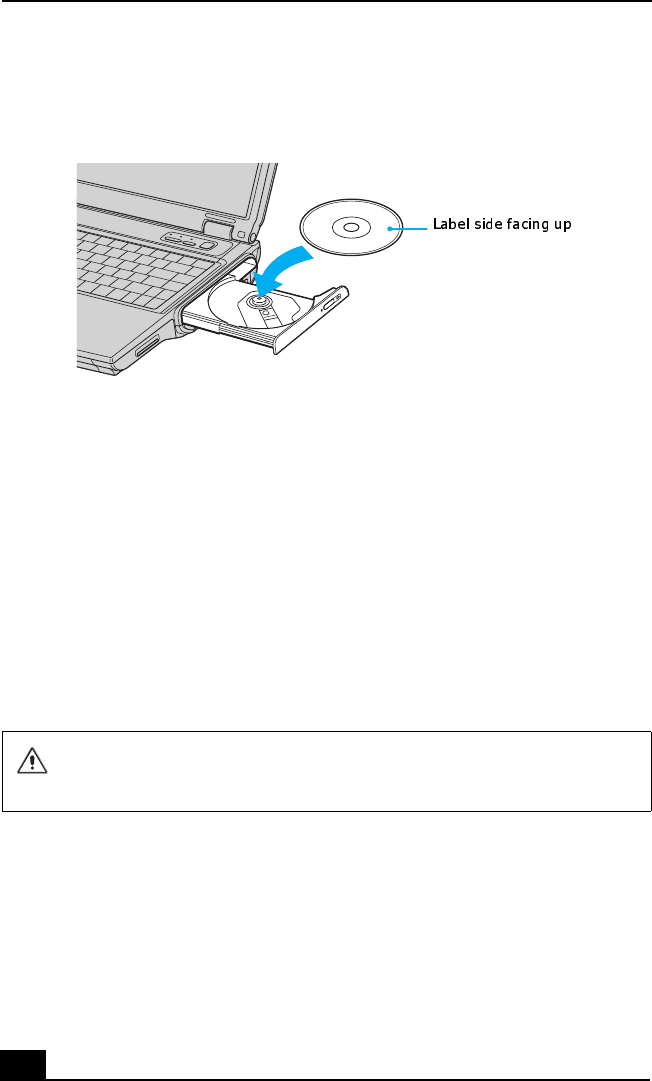
Change text in this variable definition to document title.
26
5Close the tray by pushing it gently.
To eject a disc
When you finish using a disc, wait until the LED indicator turns off, and then
press the Eject button to remove the disc.
When the notebook is in a power saving mode, you cannot remove an optical
disc. See “Controlling Power Management” for more information about power
saving modes.
If the optical disc does not slide out when you press the Eject button, turn off the
notebook and insert a thin, pointed object (such as a paper clip) into the manual
eject hole.
Inserting an Optical Disc
Make sure to seat the disc firmly over the hub fingers. If you do not seat
the disc firmly, you could damage your optical disc drive and you may not
be able to open the tray.
Kingfisher Draft 2
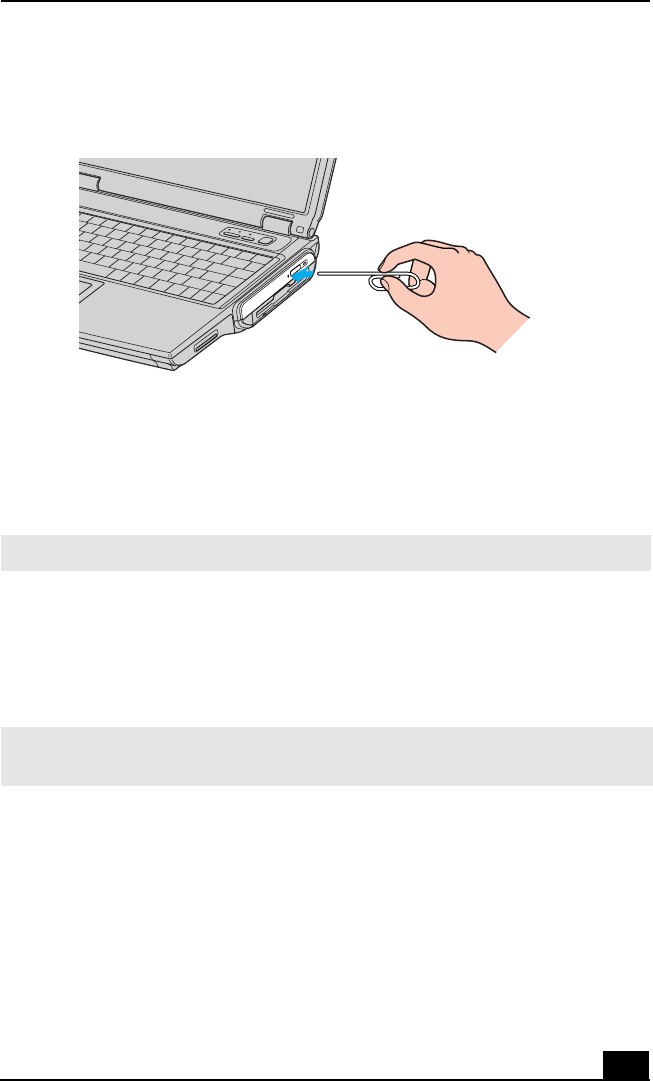
Using the Optical Disc Drive
27
To play a DVD
To play a DVD, you may use the optical disc drive and the preinstalled
WinDVD® application. For more information, see the Help menu in the
WinDVD application.
Your optical disc drive can read most DVD-R media. When you are ready to play
a DVD, read the suggestions below to maximize your video viewing experience.
❑When playing a DVD on battery power, set the power management profile to
DVD. You can also set the power management profile to Automatic Profile
Selection if the display is not clear when using other profiles.
❑If you connect your notebook to a TV display, you may need to adjust the
display resolution. Read the suggestions below to set the display resolution
to the proper dimensions. Also see “Selecting the Display Mode” for more
information.
❑If the notebook is set to the default display setting, part of the video screen
will not appear. To view the entire screen, adjust the display resolution to
640 x 480.
Manual Eject Hole
✍ Before you use the optical disc drive to play a DVD, quit any open applications.
✍ Automatic Profile Selection sets the power management profile to DVD whenever a
DVD is inserted. See “Controlling Power Management” for more information.
Kingfisher Draft 2

Change text in this variable definition to document title.
28
To play an audio CD
To play an audio CD, make sure the audio function is turned on. To do this,
complete the following procedure.
1Click Start, and click Control Panel, and Performance and Maintenance, and
System. The System Properties window appears.
2Select the Hardware tab, and click Device Manager. The Device Manager
window appears.
3Double-click DVD/CD-ROM drives to open a list of the optical disc drive
devices installed on your computer.
4Right-click the particular optical disc drive device installed on your
computer, and select Properties from the drop-down list. A properties
window appears.
5Select the Properties tab, and check the “Enable digital CD audio for this
CD-ROM device” box, if it is not already checked.
6Click OK.
Notes on CD and DVD discs
❑Do not drop or bend the disc.
Some discs recorded at 20 or 24 bits may produce noise while playing. If
you have audio devices connected, this may cause damage to your hearing
and the speakers. Reduce the volume before playing a DVD.
You cannot use the Fn + F8 function to switch between LCD and TV once a
DVD is inserted into the optical disc drive.
Do not switch between LCD and the external display while the DVD is
playing. This may cause a malfunction, and you may need to restart the
DVD software.
Do not switch the power saving modes while you are playing the DVD.
Change the settings to disable the screen saver and the virus checker.
Do not use memory-resident utility software to speed up disc access. This
may cause the notebook to malfunction.
Kingfisher Draft 2

Using the Optical Disc Drive
29
❑Do not touch the surface of the disc. Fingerprints and dust on the surface of a
disc may cause reading errors. Proper care of the disc is essential to maintain
its reliability. Do not use solvents such as benzine, thinner, commercially
available cleaners or anti-static spray, as they may cause damage to the disc.
❑For normal cleaning, hold the disc by its edge and use a soft cloth to wipe the
surface from the center out.
❑If the disc is badly soiled, moisten a soft cloth with water, wring it out well,
and use it to wipe the surface of the disc from the center out. Wipe off any
remaining moisture with a dry, soft cloth.
To write data to a CD-RW or CD-R disc*
You can use Sony SonicStage and Microsoft® Windows® XP to write data to a
CD-R or CD-RW disc. To create a CD-R disc that is readable in a CD-ROM
drive, make sure that you finish the writing process before ejecting the disc. For
more information, see the instructions included with Windows® XP.
Notes on writing data to a CD-RW or CD-R disc
❑For optimal writing speed, deactivate the screen saver and exit anti-virus
software before writing data to a disc.
❑For best results, use CD-Rs that are compatible with 16x speed.
❑Your notebook does not support 1x or 2x writing speed.
❑Memory-resident disc utilities may cause unstable operation or data loss.
Deactivate these utilities before writing data to a disc.
❑If your notebook computer has preinstalled Microsoft® Office applications,
such as Excel, Word, and Outlook, turn off the FindFast application.
* For notebook models equipped with a CD-RW/DVD Combo Drive.
Do not strike or shake the notebook while writing data to a disc.
Always use the AC adapter as the power source for your notebook if you are
writing data to a CD-RW or CD-R disc. Using battery power may result in
data transfer failure.
To avoid writing errors, remove the compact woofer or do not play music
while writing data to a CD-RW or CD-R disc.
Kingfisher Draft 2
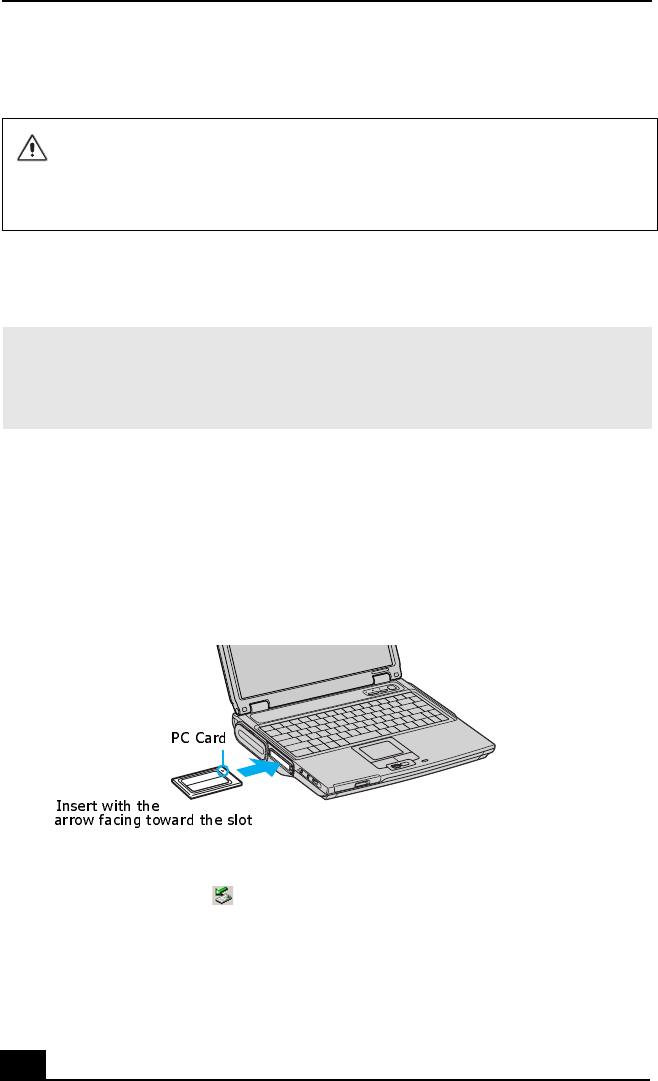
Change text in this variable definition to document title.
30
Using PC Cards
Your notebook includes two PC Card slots. PC Cards enable you to connect
portable external devices such as another hard disk drive, or a PC Network
Interface Card (NIC) to connect to a network.
To insert a PC Card
1Insert the PC Card into the PC Card slot. Make sure the front label of the PC
Card is facing up.
2Push the PC Card gently into the slot. The PC Card is automatically detected
by your system. The Unplug or Eject Hardware icon appears in the
taskbar.
Do not strike or shake the notebook while writing data to a disc.
Always use the AC adapter as the power source for your notebook if you are
writing data to a CD-RW or CD-R disc. Using battery power may result in
data transfer failure.
✍The PC Card slots can accommodate two Type I/II PC Cards, or one Type III PC
Card. These slots are compatible with CardBus. Use the lower slot for Type III PC
Cards. You do not need to shut down your notebook before inserting or removing a
PC Card.
Inserting a PC Card
Kingfisher Draft 2

Using PC Cards
31
To remove a PC Card
If your notebook is turned on, follow these instructions. If your notebook is
turned off, skip to step number 5.
1Close all applications that use the PC Card; otherwise, data may be lost.
2Double-click the green arrow icon in the taskbar.
3Select an option in the Hardware devices box, and click Stop. The Stop a
Hardware device window opens.
4Click OK to confirm your selection, and then Close.
5Press the PC Card Release button. The Release button pops out.
6Press the PC Card Release button a second time (in some cases). Remove the
card.
Notes on using PC Cards
❑For some PC Cards, if you alternate between normal power operation and
the Standby or Hibernate power management modes while the card is
inserted, you may find that a device connected to your system is not
recognized. Restart your system to correct the problem.
❑Some PC Cards may require that you disable idle devices when using the PC
Card. You can use Sony Notebook Setup to disable devices. See “Displaying
the Sony Notebook Setup Screen” for more information.
❑Be sure to use the most recent software driver provided by the PC Card
manufacturer.
❑If an exclamation mark (!) appears on the Device Manager tab in the System
Properties dialog box, remove the software driver and then reinstall it.
❑You may not be able to use some PC Cards or some functions of the PC Card
with this notebook. If you have difficulty inserting a card, check that you are
orienting the card correctly. See the manual that came with your PC Card for
more information on its use.
Do not force a PC Card into the slot as this may damage the connector
pins.
Do not carry your notebook while touching the head of a PC Card, as
pressure or shock may damage the connector pins.
Kingfisher Draft 2

Change text in this variable definition to document title.
32
Using Memory Stick Media
This compact, portable, and versatile recording medium has a data capacity
exceeding that of a floppy disk. The medium is specially designed for
exchanging and sharing digital data with compatible products. Because it is
removable, the media can be used for external data storage.
Types of Memory Stick media
The following two types of Memory Stick media can be used with your
notebook:
❑MagicGate™* Memory Stick media (hereafter called MG Memory
Stick media), which is provided with copyright protection
❑Memory Stick† media, which does not have the same copyright
protection as MagicGate Memory Stick media
Some music files with secure copyright protection may be stored on MG
Memory Stick media but not on regular Memory Stick media.You can also use
MagicGate media-compatible devices to record and playback music when they
are connected to your notebook.
You can store mixed data on the Memory Stick media. For example, you can
copy an ordinary file onto a MG Memory Stick media that already contains
music files.
What is MagicGate Memory Stick media?
MagicGate Memory Stick media provides copyright protection that consists of
authentication and encryption technology. Authentication technology ensures
that protected content is only transferred between compliant devices and media.
Protected content is recorded and transferred in an encrypted format to prevent
unauthorized duplication or playback.
* MagicGate Memory Stick and are trademarks of Sony Corporation.
† Memory Stick and are trademarks of Sony Corporation.
✍MG Memory Stick media has the MG mark .
Kingfisher Draft 2
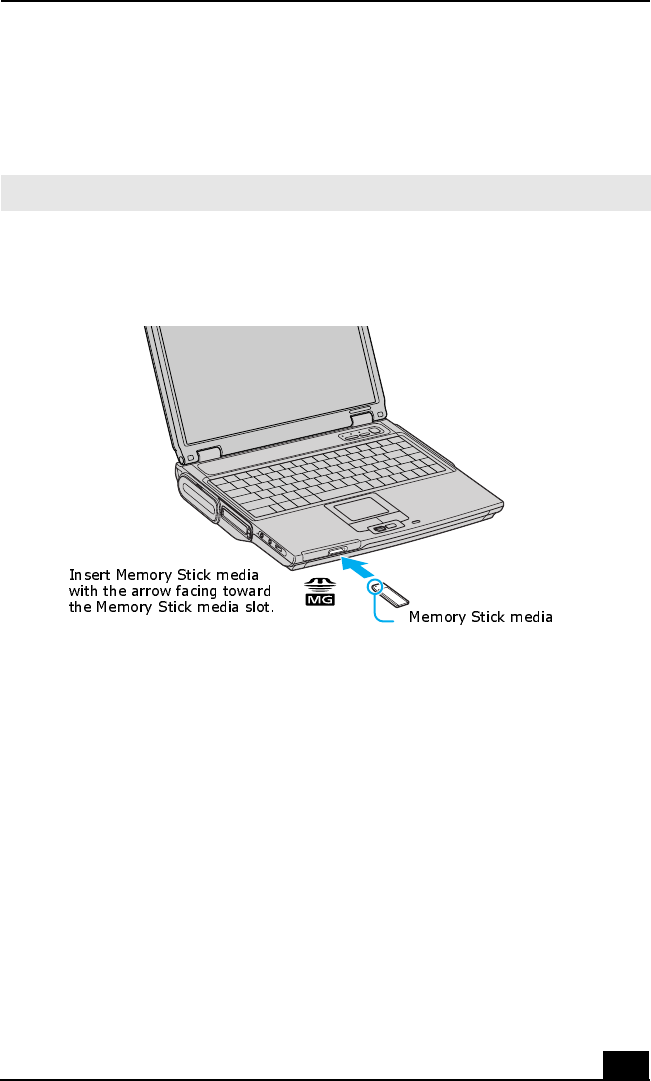
Using Memory Stick Media
33
To insert Memory Stick media
1Insert the Memory Stick media with the arrow facing up and toward the
Memory Stick media slot.
2Carefully slide the Memory Stick media into the slot until it clicks in place.
To view the contents of Memory Stick media
1Click Start in the Windows taskbar and then click My Computer
2Double-click Sony Memory Stick under the Devices with Removable
Storage box. The Sony Memory Stick window opens.
To remove Memory Stick media
1Make sure the Memory Stick media indicator light on the right of the
notebook is off.
2Push the Memory Stick media in toward the notebook.
3When the Memory Stick media ejects, pull it out.
✍Inserting the media in the wrong direction may damage the connector pins.
Inserting Memory Stick Media
Kingfisher Draft 2
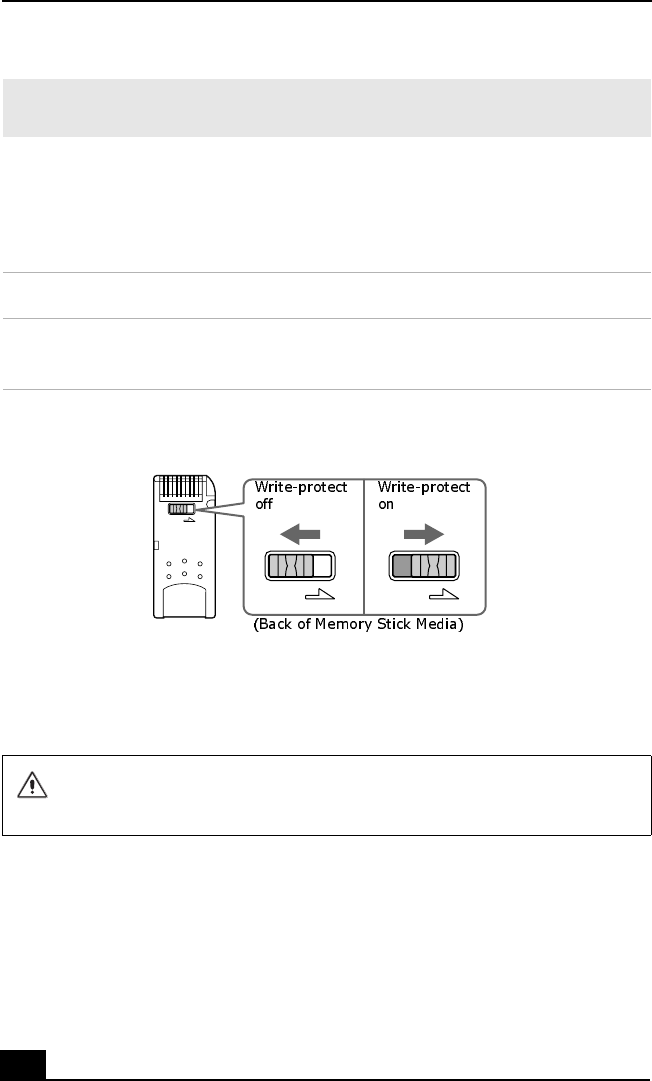
Change text in this variable definition to document title.
34
Write-protecting Memory Stick media
Memory Stick media is designed with a write-protect tab to protect valuable data
from accidental erasure or overwriting. Move the tab to the right or left to set or
release write-protection.
Formatting Memory Stick media
Memory Stick media is formatted for immediate use when you purchase it. If you
need to reformat Memory Stick media, follow the procedures below.
1Insert the Memory Stick media into the notebook. See “To insert Memory
Stick media” for more information.
2Click Start in the Windows taskbar, and click My Computer.
✍Be careful when removing the Memory Stick media, as it may eject completely from
the slot.
Write-protect off Data can be saved on the Memory Stick media.
Write-protect on Data can be read from but not saved on the Memory Stick
media.
Using the Write-protect Tab
Reformatting erases all current data that is stored on Memory Stick
media. Before you reformat, confirm that the media does not contain files
you want to keep.
LOCK
LOCK LOCK
Kingfisher Draft 2

Using Memory Stick Media
35
3Under Devices with Removable Storage, right-click Sony Memory Stick -
MG, and select Format. The Format Sony Memory Stick - MG dialog box
appears.
4Select the appropriate options, and click Start.
Notes on using Memory Stick media
❑When the write-protect tab of the Memory Stick media is set to LOCK, data
cannot be recorded or erased.
❑Before using Memory Stick media, back up important data.
❑Wait a minimum of 10 seconds after the Memory Stick media finishes
reading or writing data before removing the media.
❑If the media is removed prematurely, a blue screen with an error message
appears, prompting you to continue or exit. Reinsert the media into the slot
and press Enter to continue. This enables the media to finish reading or
writing data.
❑You can view video clips that you have recorded with Memory Stick media-
compatible video camera recorders.
❑The media slot can accommodate one Memory Stick media at a time.
❑You may copy images from a digital video camera using Memory Stick
media.
❑Only MagicGate Memory Stick media can be used with copyright protected
data such as music.
❑Copyright protected music cannot be checked-out to any Memory Stick
media other than MG Memory Stick media.
❑Recorded music is limited to private use only. Using recorded music for any
other purpose requires permission of the copyright holders.
❑Sony is not responsible for music files that cannot be recorded from a CD or
downloaded from other sources.
❑Formatting Memory Stick media erases all data (including music data)
previously saved to it. Before you format Memory Stick media, confirm that
the media does not contain files you want to keep.
❑Do not use the media in locations that are subject to static electricity or
electrical noise.
❑Do not touch the media connector with your finger or metallic objects.
Kingfisher Draft 2

Change text in this variable definition to document title.
36
❑Do not attach labels other than the supplied label to a media.
❑Do not bend, drop, or apply strong shock to the media.
❑Do not disassemble or modify the media.
❑Do not allow the media to get wet.
❑Do not use or store the media in a location that is subject to:
❑Extremely high temperatures, such as in a car parked in the sun
❑Direct sunlight
❑High humidity or places with corrosive substances
❑To prolong the life of the media, use the supplied storage case. See the
instructions that came with your media for more information on its use.
Kingfisher Draft 2
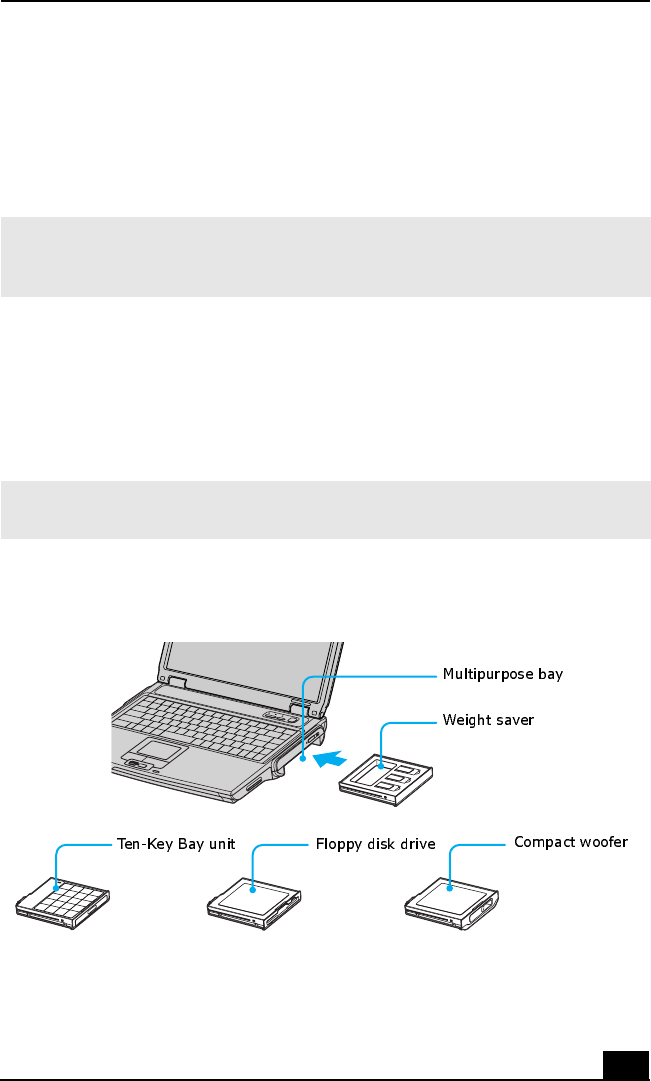
Using the Multipurpose Bay
37
Using the Multipurpose Bay
You may install a variety of devices into the multipurpose bay to expand your
computer’s functionality. The multipurpose bay supports the removable weight
saver, floppy disk drive, compact woofer, and the internal numeric keypad (Ten-
Key Bay unit) supplied with your computer.
To install a device into the multipurpose bay
1Remove any device that is already installed in the bay. See “To remove the
device from the multipurpose bay” for more information.
2Slide the device, such as the weight saver, into the multipurpose bay until it
clicks into place. The computer automatically detects the installed device.
✍You can install a device into and remove a device from the multipurpose bay while
the computer is powered completely on or turned off. Installing and removing a
device while the computer is in a power saving mode is not supported.
✍Before you install a compact woofer, prop up the rear stands on the bottom of the
computer to maximize woofer performance.
Inserting the Device
Kingfisher Draft 2
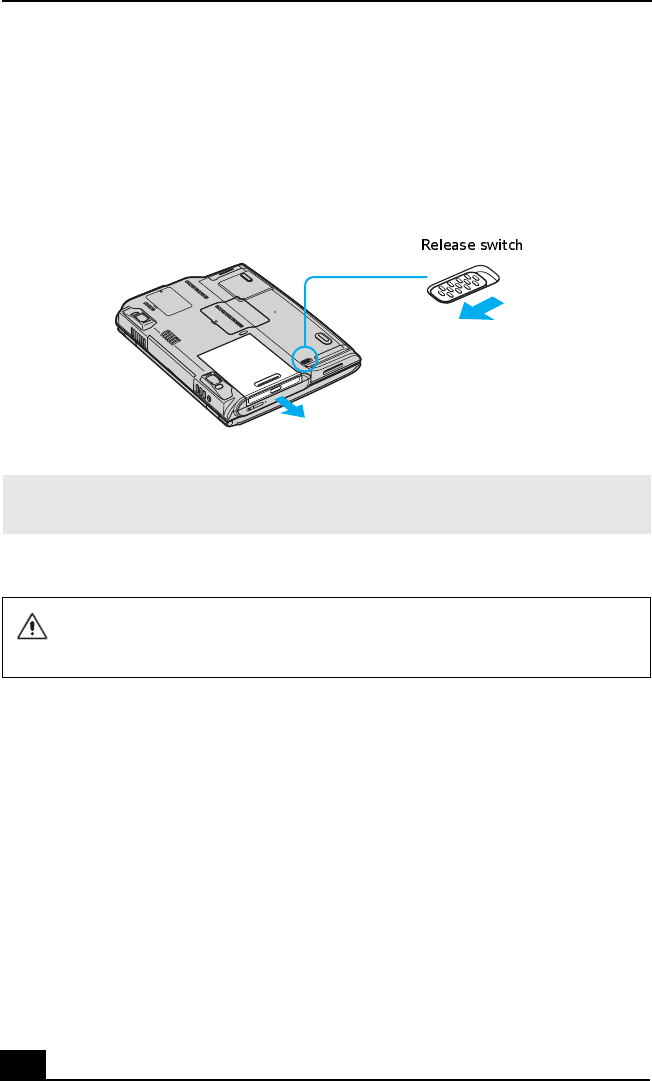
Change text in this variable definition to document title.
38
To remove the device from the multipurpose bay
1Slide and hold the multipurpose bay Release switch in the release position
while you gently pull the device from the bay.
Notes on using a device in the multipurpose bay
❑Do not use the external speakers and the compact woofer at the same time.
Using both devices at the same time does not enhance sound quality.
Multipurpose Bay Release Switch
✍If you do not plan to install another device into the multipurpose bay, insert the
supplied weigh saver to protect the bay.
Do not place the compact woofer near any magnetic recording media, such
as a hard disk, floppy disk, or mini disk. The woofer’s magnetic field may
damage the data stored on this type of media.
Kingfisher Draft 2
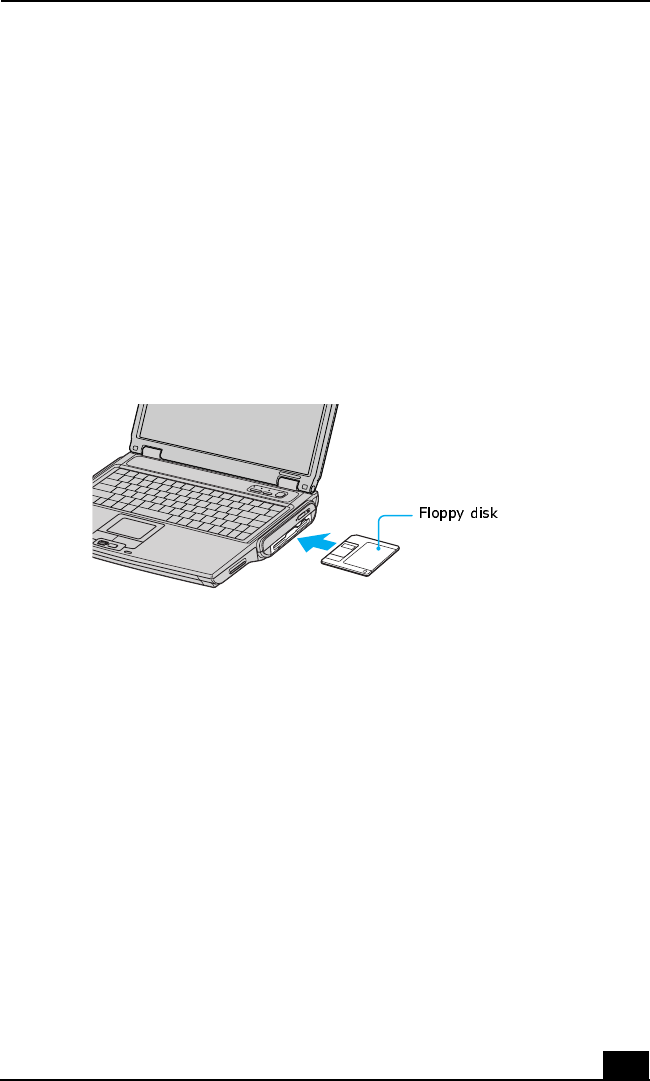
Using the Floppy Disk Drive
39
Using the Floppy Disk Drive
Whether you installed the supplied floppy disk drive into the multipurpose bay or
connected an external floppy disk drive to the computer, you’ll notice that both
floppy disk drives are similar and easy to use.
To insert a floppy disk into the floppy disk drive
1Hold the floppy disk with the label facing up.
2Gently push the floppy disk into the drive until it clicks into place.
Inserting a Floppy Disk into the Multipurpose Bay Floppy Disk Drive
Kingfisher Draft 2
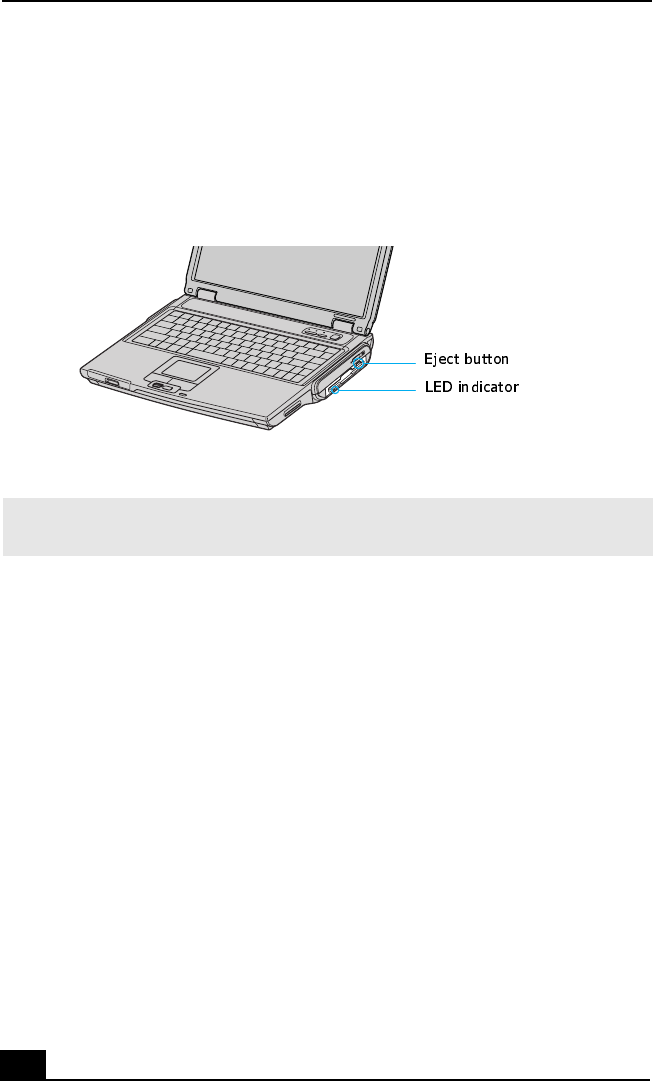
Change text in this variable definition to document title.
40
To remove a floppy disk from the floppy disk drive
1Close all applications that were opened from the disk and wait for the LED
indicator to turn off.
2Push the Eject button, and remove the disk.
Notes on handling floppy disks
❑Do not open the shutter manually and touch the surface of the floppy disk.
❑Keep floppy disks away from magnets.
❑Keep floppy disk away from direct sunlight and other heat sources.
Removing a Floppy Disk from the Multipurpose Bay Floppy Disk Drive
✍Do not push the Eject button when the LED indicator is turned on; otherwise, you
may lose data.
Kingfisher Draft 2

Using Power Saving Modes
41
Using Power Saving Modes
When you use a battery as the source of power for your notebook, you can take
advantage of power management settings to conserve battery life. In addition to
the normal operating mode, which allows you to turn off specific devices, your
notebook has two distinct power saving modes: Standby and Hibernate. When
using battery power, be aware that the notebook automatically enters Hibernate
mode when the remaining battery charge drops below 5 percent, regardless of the
power management setting you select.
Normal mode
Normal mode is the normal state of your notebook when it is in use. The power
indicator displays green when your notebook is in this mode. To save power, you
can turn off a specific device such as the LCD or the hard disk drive.
Standby mode
In Standby Mode the notebook saves the current state of the system in RAM and
switches off power to the CPU. The amber power indicator flashes in this mode.
To activate Standby mode
Press the key combination Fn + Esc.
To return to Normal mode
Press any key to return to Normal mode.
Hibernate mode
In the Hibernate mode, the state of the system is saved on the hard disk drive and
power is turned off. The power indicator is off in this mode.
✍If the battery level falls below 10 percent, you should either attach the AC adapter to
recharge the battery or shut down your notebook and insert a fully charged battery.
Kingfisher Draft 2

Change text in this variable definition to document title.
42
To activate Hibernate mode
1Press the key combination Fn + F12, or press the power button and release it
immediately. The “Save to Disk Manager” window appears and the
notebook enters Hibernate mode.
2Press the power button to return to normal mode.
Notes on power saving modes
❑When returning from Hibernate mode, the system status stored on the hard
disk is erased and the notebook starts normally if you press the power button
and hold it for more than four (4) seconds.
❑Standby uses more power than Hibernate.
❑Standby requires less time than Hibernate to return to normal mode.
✍Do not move the notebook until its power indicator turns off.
Kingfisher Draft 2
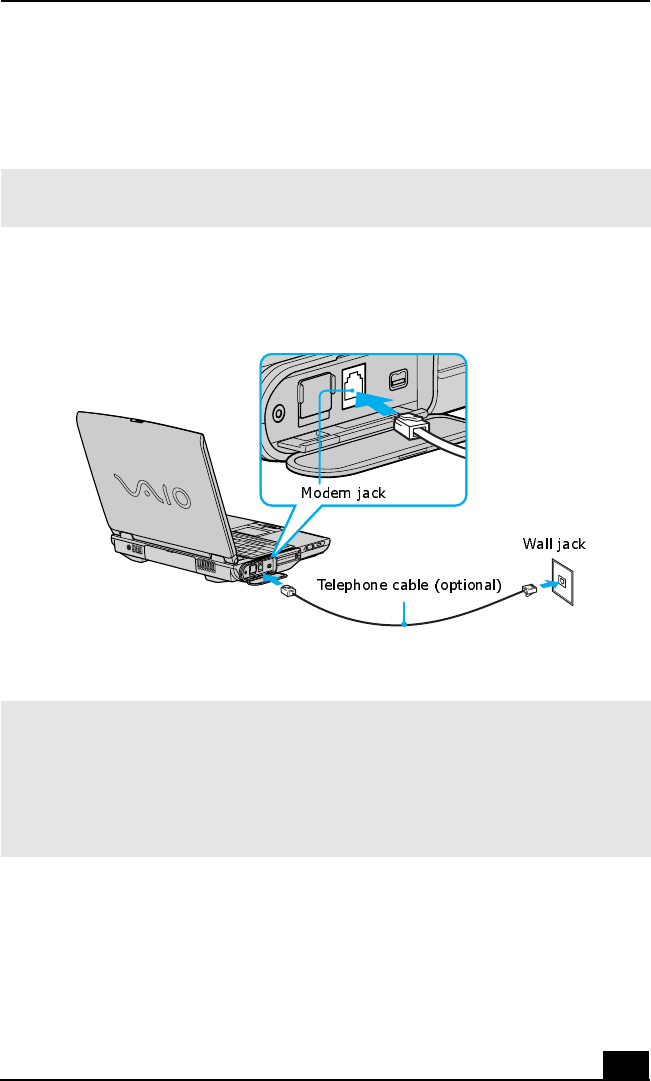
Using a Telephone Cable
43
Using a Telephone Cable
You need to connect a telephone cable to take advantage of online services and
the Internet.
1Plug one end of the telephone cable into the Modem jack on the notebook.
2Plug the other end of the telephone cable into the wall jack.
✍In order to register your Sony VAIO notebook, register your software online, and use
Sony Customer Support, you must connect to a telephone cable.
Connecting a Telephone Cable
✍Your notebook does not work with party lines, cannot be connected to a coin-
operated telephone, and may not work with multiple telephone lines or a private
branch exchange (PBX). Some of these connections may result in excess electrical
current and could cause a malfunction in the internal modem.
If you connect a telephone cable coming through a splitter, the modem or connected
device may not work properly.
Kingfisher Draft 2
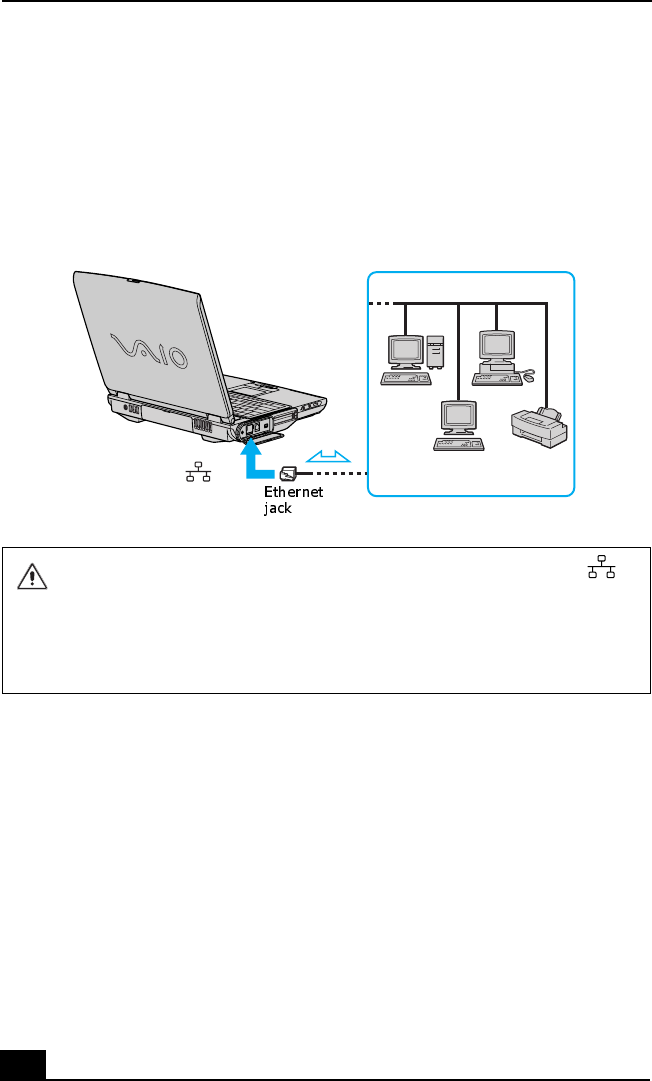
Change text in this variable definition to document title.
44
Using a Local Area Network
You can connect your notebook to 10BASE-T and 100BASE-TX-type Local
Area Networks (LANs). For the detailed settings and devices needed to connect
to the network, ask your network administrator.
Setting up your Ethernet connection
To connect to the network
1Click Start on the Windows® taskbar, and select My Computer.
2In the Other Places box on the left, click My Network Places.
3In the Network Tasks box, click Add a network place or click Set up a home
or small office network, depending on your configuration. Depending on
your choice, either the Add Network Place Wizard or Network Setup Wizard
window appears.
4Follow the on-screen instructions.
Connecting to LAN
Warning: Only connect 10BASE-T and 100BASE-TX cables to the
Ethernet jack. Do not connect any other type of network cable or phone
cable. Connecting cables other than those listed above may result in an
electric current overload and could cause a malfunction, excessive heat, or
fire in the port. To connect the unit to the network, contact your network
administrator.
Kingfisher Draft 2
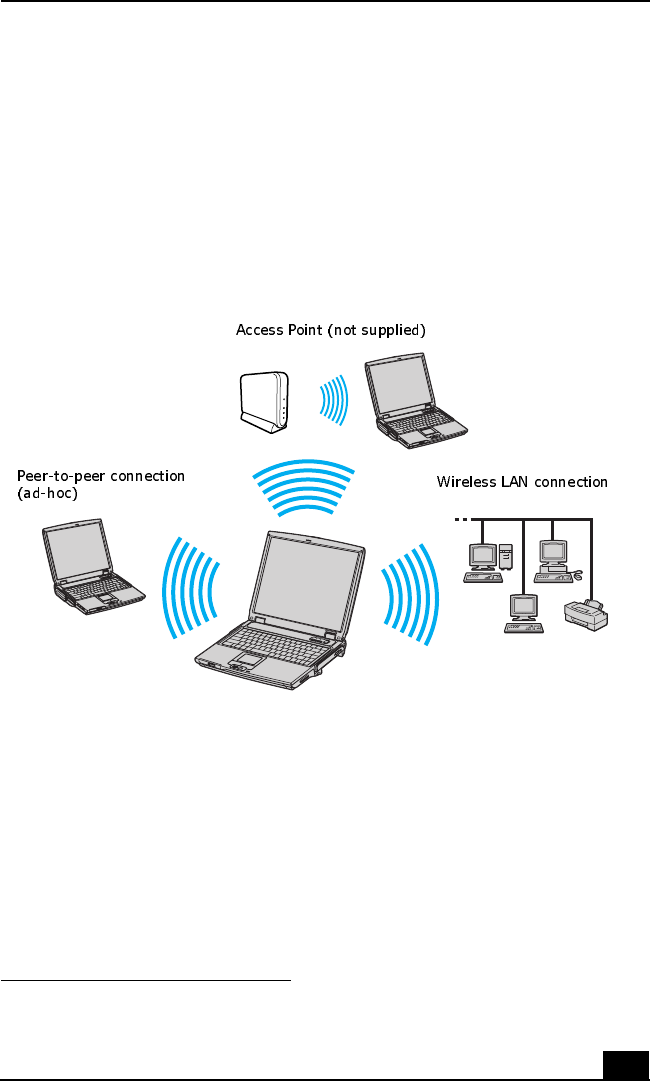
Using Wireless LAN
45
Using Wireless LAN*
Your computer is equipped with a built-in mini PCI card that allows for wireless
connections. With Sony’s Wireless Local Area Network (LAN) functionality, all
compatible digital devices can communicate freely without cable connections. A
Wireless LAN is a network in which a mobile user can connect to a LAN through
a wireless (radio) connection. You can opt to purchase a Wireless LAN Access
Point to set up a LAN.
Turning On Wireless LAN
To enable Wireless LAN functionality, first locate the Wireless LAN switch on
the top, right corner of the computer. Move the switch to the ON position. The
Wireless LAN indicator lights up.
* Wireless LAN functionality is available on selected models only.
Communicating via Wireless LAN
Kingfisher Draft 2
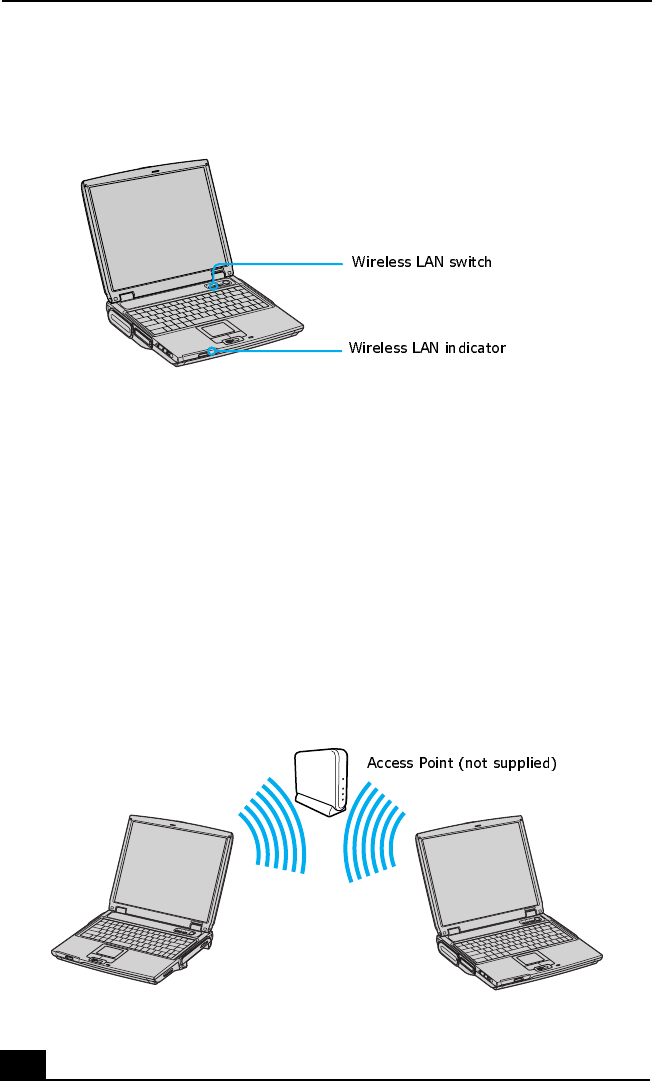
Change text in this variable definition to document title.
46
The Wireless LAN Access Point
The Wireless LAN Access Point, also called the access point, is designed for
building a Wireless LAN environment. If you purchase an access point, you can
easily build a wireless LAN environment by plugging the access point into an
AC power outlet and using the provided software with compatible devices.
Because a wireless LAN configuration requires no wiring, you can operate
multiple computers more freely than ever before.
You can also connect an access point to a telephone line, Integrated Services
Digital Network (ISDN) router, cable modem, or Digital Subscriber Line (xDSL)
modem to share access to the Internet among multiple computers.
Connecting to a wireless LAN
Communicating via Wireless LAN Access Point
Kingfisher Draft 2
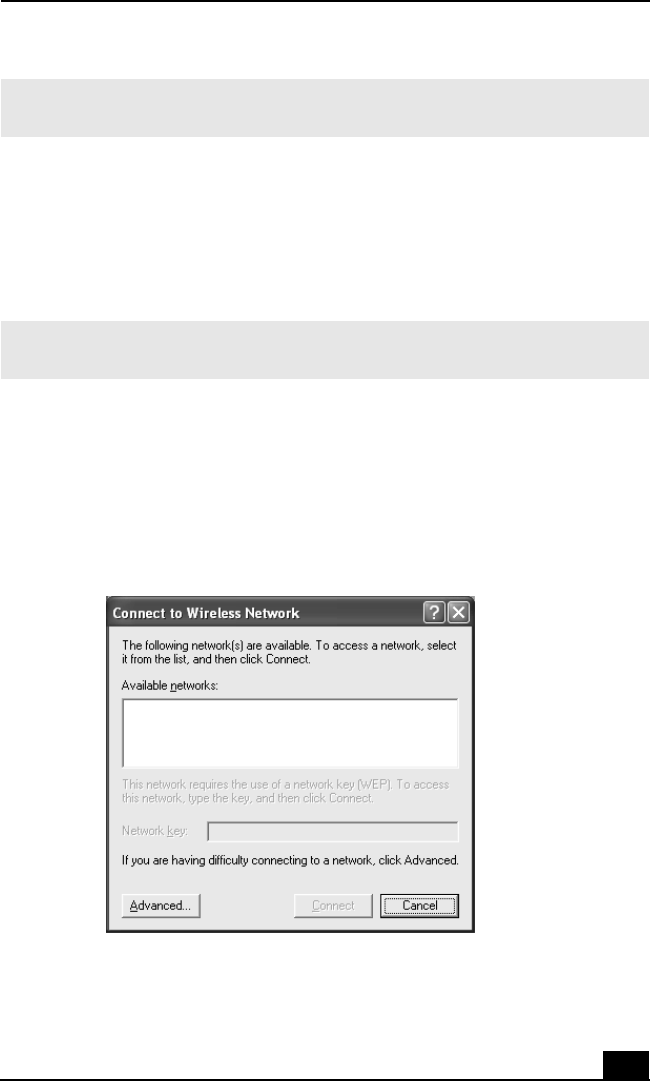
Using Wireless LAN
47
Communicating with an Access Point (infrastructure)
An infrastructure network is one that extends an existing wired local network to
wireless devices by providing an access point. The access point bridges the
wireless and wired LAN and acts as a central controller for the Wireless LAN.
The access point coordinates transmission and reception from multiple wireless
devices within a specific range.
To set up and connect with an access point
1Locate the Wireless LAN switch, and move the switch to the ON position.
2From the Start menu, and point to Connect To, and click Wireless Network
Connection. The Connect to a Wireless Network window appears.
3Select a network from the Available Networks list box.
✍For information on available Sony products, go to:
http://www.sonystyle.com/wirelesslan.
✍If you create a network using a network (or encryption) key, you will need that key
to access the network.
Connecting to a wireless LAN
Kingfisher Draft 2

Change text in this variable definition to document title.
48
4Type a key in the Network key box. This is necessary if the network was
created with an encryption key; otherwise, you cannot connect to the
network.
5Click Connect.
Communicating without an access point (ad-hoc)
An ad-hoc network is one in which a local network is created only by the
wireless devices themselves, with no other central controller or access point.
Each device communicates directly with other devices in the network. You can
set up an ad-hoc network easily at home, either with an network key for added
security or without a key.
To set up and connect without a network key
1Locate the Wireless LAN switch, and move the switch to the ON position.
2Click Start on the taskbar, point to Connect To, and click Wireless Network
Connection. The Connect to Wireless Network window appears.
3Click Advanced. The Wireless Network Connection Properties window
appears.
✍The network key is data used to protect signals passing through a wireless LAN that
conforms with IEEE 802.11b standard. It is also called an “encryption key.”
Wireless LAN communication can only occur between an access point and computer
that are using the same key information.
When you enter the network key and the connection is made, the access point is
registered, and you do not have to enter the network key when you connect
thereafter.
✍If you create a network using a network (or encryption) key, you will need that key
to access the network.
Kingfisher Draft 2
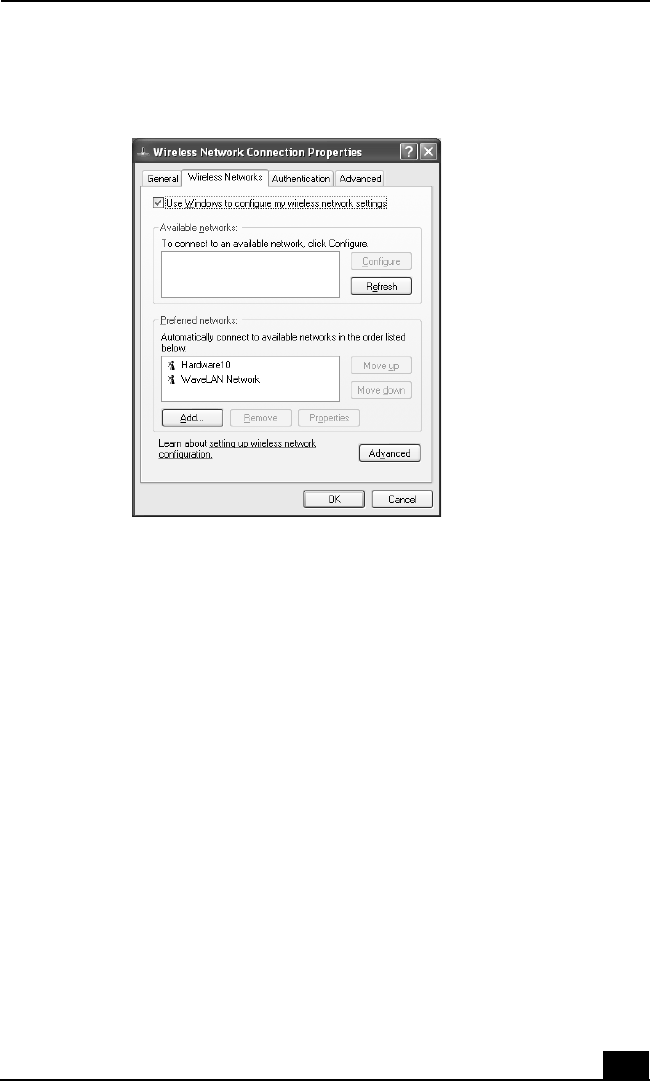
Using Wireless LAN
49
4Make sure the Wireless Networks tab is selected, and click Add. The
Wireless Network Properties window appears.
5Type in a Network name (SSID), and check the “This is a computer-to-
computer (ad hoc) network; wireless access points are not used.” box.
6Click OK.
7Select a network from the Preferred networks list, and click OK.
To set up and connect with a network key
1Follow steps 1 to 4 in “To set up and connect without a network key”.
2Type in a Network name (SSID), and check the “Data encryption (WEP
enabled)” box, and the Network Authentication (Shared mode)” box.
3Deselect the “This key is provided for me automatically” box.
4Type in a Network key name. You will need this key to access the network.
5Click OK.
6Click Advanced. The Advanced dialog box appears.
Setting Wireless Network Connection Properties
Kingfisher Draft 2

Change text in this variable definition to document title.
50
7Select “Computer-to-computer (ad hoc) networks only.”, and click Close.
8Select a network from the Preferred networks list, and click OK.
To connect to an existing network
1Locate the Wireless LAN switch, and move the switch to the ON position.
2Click Start on the taskbar, point to Connect To, and click Wireless Network
Connection. The Connect to Wireless Network window appears.
3Click Advanced. The Wireless Network Connection Properties window
appears.
4Select the Wireless Networks tab, if it is not already selected, and select a
network from the Preferred networks list.
5Click OK.
Checking your connection status
To confirm your connection status with an access point
1Right-click the Wireless Network Connection icon on the Windows taskbar.
2Click Status in the pop-up menu. The Wireless Network Connection Status
window appears.
Turning Off Wireless LAN
To turn off Wireless LAN functionality
1Close all files that you are accessing through the network connection.
2Locate the Wireless LAN switch, and move the switch to the OFF position.
The Wireless LAN indicator switches off. It may take a few moments for the
computer to disconnect.
Turning off the Wireless LAN functionality while accessing remote
documents, files, or resources may result in data loss.
Kingfisher Draft 2

Using Wireless LAN
51
Notes on using Wireless LAN
❑Sony Wireless LAN devices support the IEEE 802.11b standard. Devices
connecting to a Wireless LAN using the IEEE 802.11a standard cannot
connect to devices using the IEEE 802.11b standard.
❑Wireless LAN communication occurs on divided frequency bands known as
channels. Third-party Wireless LAN Access Point channels may be preset to
different channels from Sony devices.
❑If using a Wireless LAN Access Point, refer to connectivity information
contained in those instructions.
Kingfisher Draft 2

Change text in this variable definition to document title.
52
Kingfisher Draft 2

53
Connecting Peripheral Devices
You can add functionality to your notebook by connecting a variety of
peripherals, as discussed in the following sections:
❑Connecting a USB Device
❑Connecting a USB Printer
❑Connecting a Parallel Port Printer
❑Connecting an Audio Device
❑Connecting an Audio-Video Device
❑Connecting an i.LINK Audio-Video Device
❑Connecting an External Display
❑Connecting with another VAIO computer
❑Connecting External Speakers
❑Connecting an External Microphone
❑Expanding Your Computer Capabilities
Kingfisher Draft 2
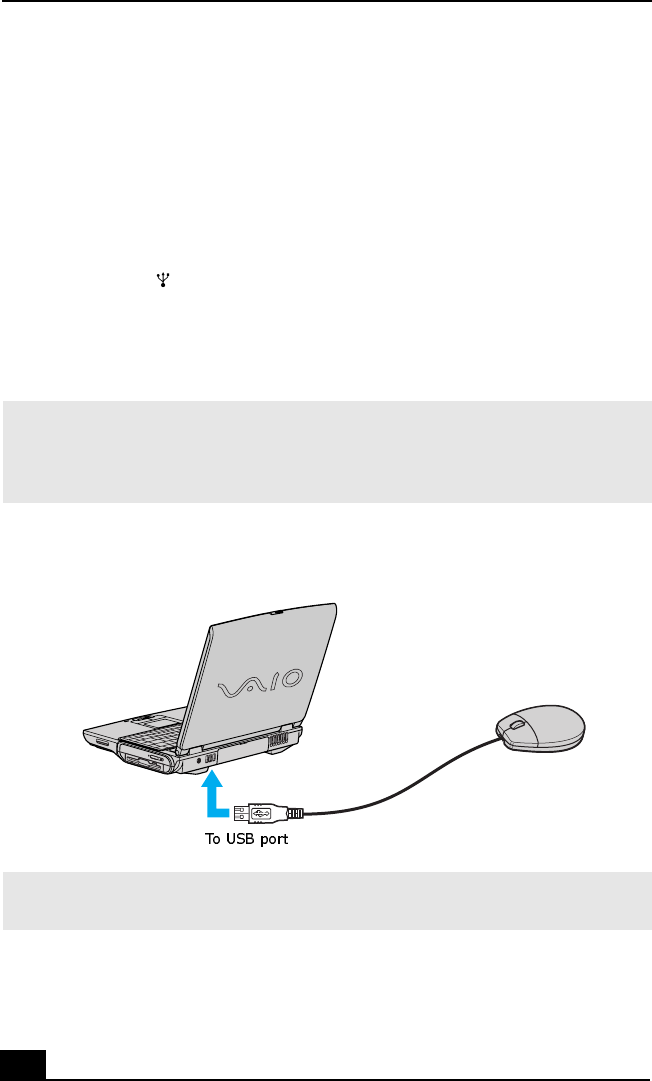
Change text in this variable definition to document title.
54
Connecting a USB Device
You can connect a universal serial bus (USB) device, such as a external mouse,
keyboard, speaker, and microphone to your computer. However, make sure the
USB device you want to connect is compatible with the Windows® operating
system installed on your computer.
To connect a USB device
1Locate a USB port on the rear panel of your computer.
2Plug one end of the USB cable (not supplied) into one of these ports, and
plug the opposite end of the cable into the USB device, if it is not already
connected.
✍You can use a Sony USB mouse (not supplied) with this computer. The USB mouse
software driver is preinstalled, however, the first time you connect a mouse, on-
screen installation instructions may appear. Press Enter to complete the on-screen
instructions.
Connecting a USB Device to a USB Port
✍See the manual that came with your USB device for more information on its
installation and use.
Kingfisher Draft 2
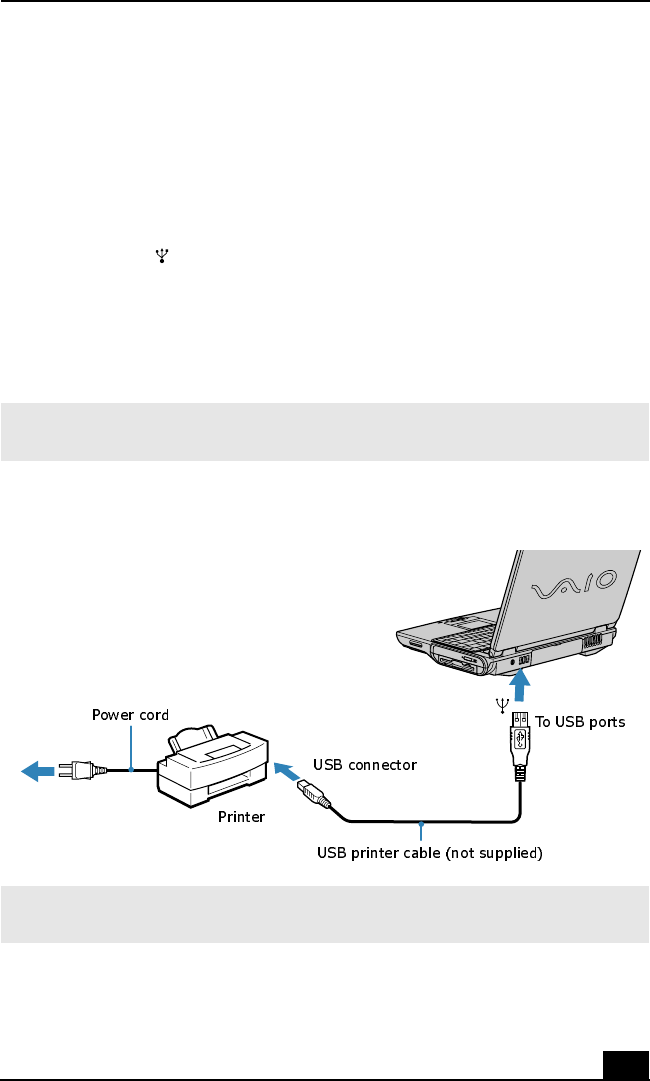
Connecting a USB Printer
55
Connecting a USB Printer
You can connect a universal serial bus (USB) printer to your computer. However,
make sure the USB device you want to connect is compatible with the
Windows® operating system installed on your computer.
To connect a USB printer
1Locate a USB port on the rear panel of the computer.
2Plug one end of the USB printer cable (not supplied) into one of these ports,
and plug the opposite end of the cable into the USB port on your printer.
3Make sure your computer’s printer settings are properly set. See “Displaying
the Sony Notebook Setup Screen” for more information.
✍To use a printer, you may need to install the driver software that came with your
printer.
Connecting a USB Printer
✍See the manual that came with your printer for more information on its installation
and use.
Kingfisher Draft 2
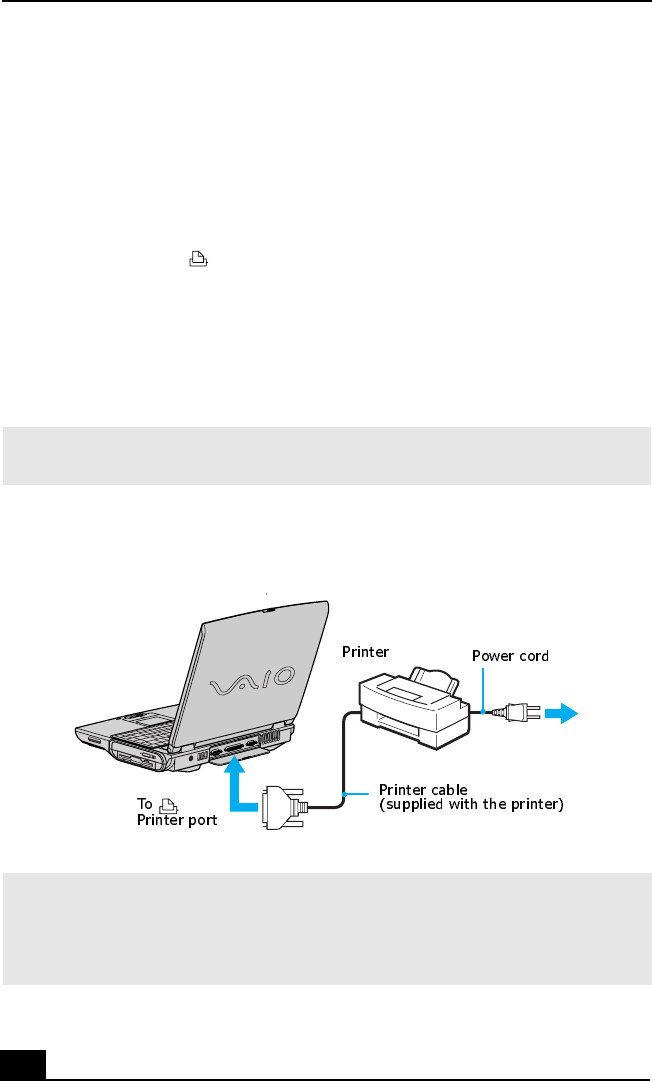
Change text in this variable definition to document title.
56
Connecting a Parallel Port Printer
You can connect a parallel port printer to your computer. However, make sure the
parallel port printer you want to connect is compatible with the Windows®
operating system installed on your computer.
To connect to a parallel port printer
1Locate the Printer port on the rear panel of the computer.
2Plug one end of the printer cable (not supplied) into this port, and plug the
opposite end of the cable into the parallel port on your printer.
3Make sure your computer’s printer settings are properly set. See “Displaying
the Sony Notebook Setup Screen” for more information.
✍To use a printer, you may need to install the driver software that came with your
printer.
Connecting a Parallel Port Printer
✍See the manual that came with your printer for more information on its installation
and use.
If your printer stops functioning after resuming from a power saving mode, see
“Troubleshooting the Printer” for more information.
Kingfisher Draft 2
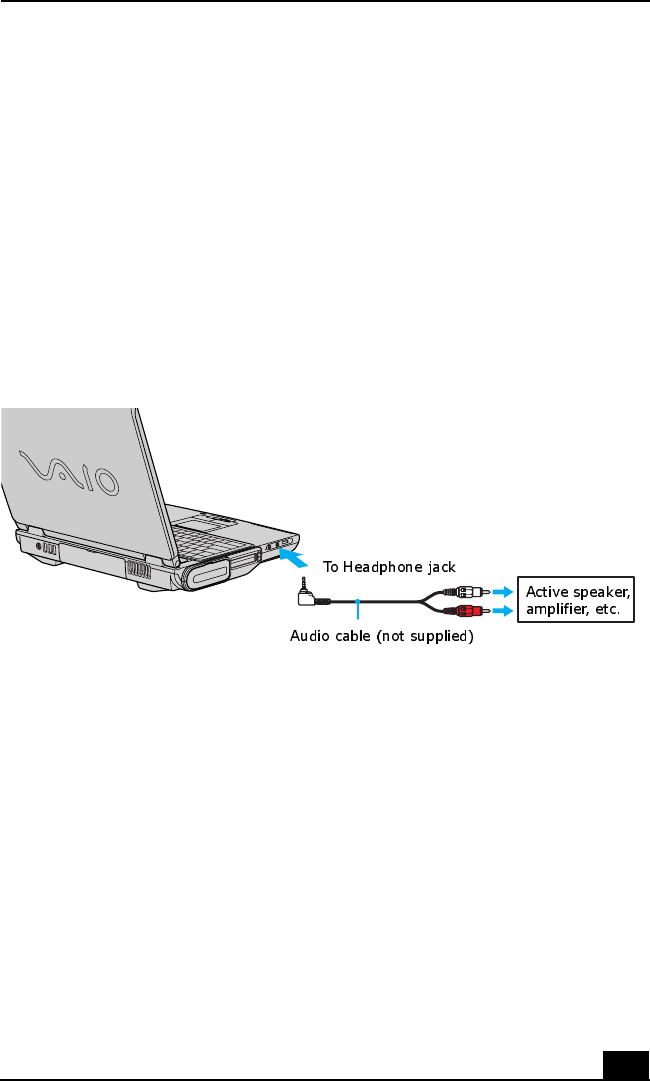
Connecting an Audio Device
57
Connecting an Audio Device
You can connect an audio device to your computer using mini-plug cables shorter
than 2 meters with no resistance.
To connect an audio device
1Plug one end of an audio cable (not supplied) into the Headphone jack on the
computer.
2Plug the opposite end of the audio cable into an audio output device, such as
a CD player, active speaker, or amplifier.
Connecting an Audio Device
Kingfisher Draft 2
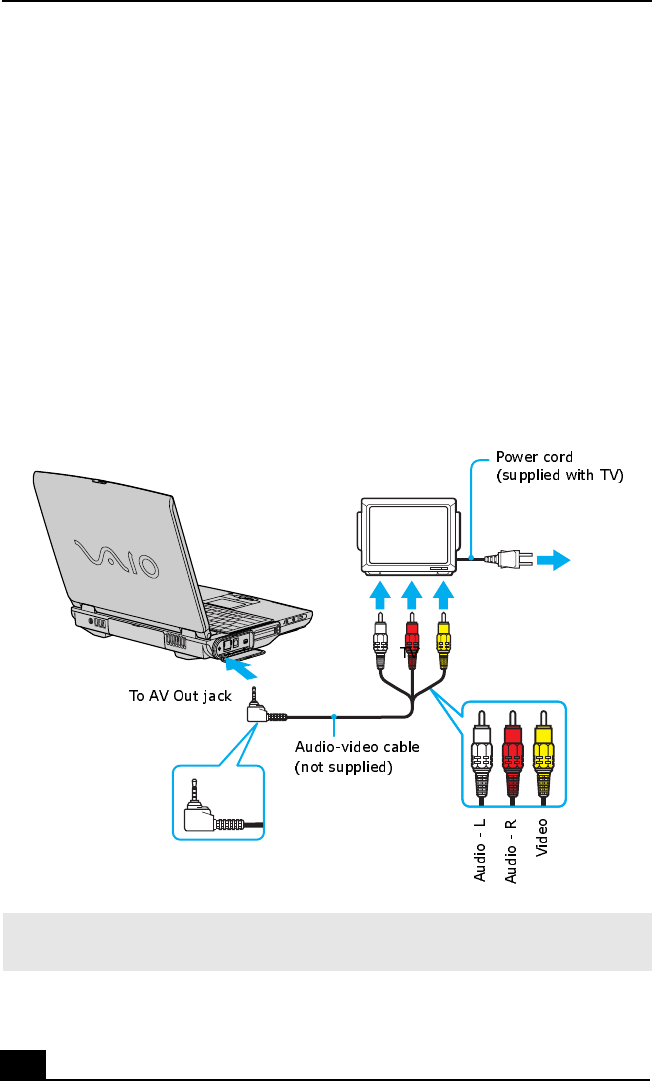
Change text in this variable definition to document title.
58
Connecting an Audio-Video Device
You can connect an audio-video (AV) device, such as a TV or a VCR, to your
computer.
To connect an AV device
1Locate the AV Out jack on the left panel of the computer.
2Plug one end of an audio-video cable (not supplied) into this jack, and plug
the opposite end of the cable into the audio-video device.
3Make sure you switch the TV input channel to external input and set up the
TV configuration system. See “To change the display” for more information.
Connecting a TV to the Computer
✍See the manual that came with your peripheral device for more information on its
installation and use.
Kingfisher Draft 2

Connecting an Audio-Video Device
59
To change the display
If you insert a DVD in your optical disc drive to watch on your TV, the Fn+F8
key combination might not activate the function to toggle between your LCD and
TV. Follow these steps.
1Connect the TV to the computer.
2Restart the computer and wait until it finishes rebooting.
3Press the Fn+F8 key combination to toggle between the LCD and TV
display. The DVD will play on only one display at a time, so select either
LCD or TV as the primary display. See “Selecting the Display Mode” for
more information.
4Re-insert your DVD to launch your DVD software.
✍A part of the image cannot be displayed on your TV display if the resolution of your
notebook is more than 1024 x 768 dots.
Kingfisher Draft 2
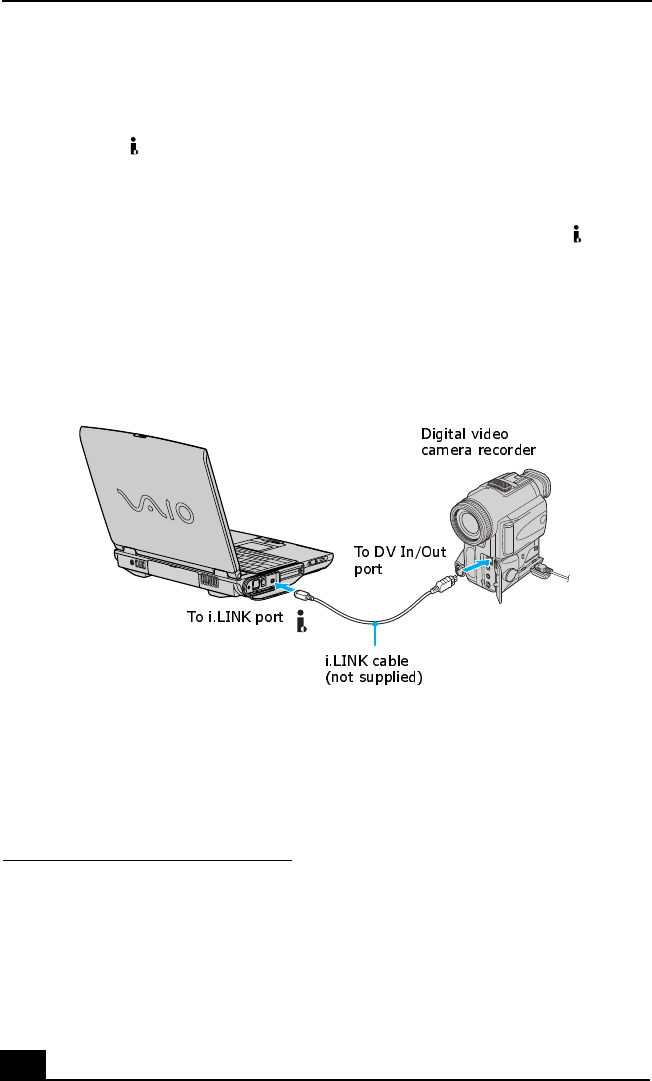
Change text in this variable definition to document title.
60
Connecting an i.LINK Audio-Video Device
You can connect an i.LINK®* enabled digital video camera recorder to the
i.LINK® S400 (IEEE 1394) port on your computer.
To connect a digital video camera recorder
1Plug one end of the i.LINK® cable (not supplied) into the i.LINK port on
the left panel of the computer.
2Plug the opposite end of the i.LINK cable into the DV IN/OUT port on the
digital video camera recorder.
* i.LINK is a trademark of Sony used to designate that a product contains an IEEE 1394 con-
nector. The i.LINK connection may vary, depending on the software application, operating
system, and compatible i.LINK devices. All products with an i.LINK connection may not
communicate with each other. Refer to the documentation that came with your compatible
i.LINK device for more information on operating conditions and proper connection. Before
connecting compatible i.LINK PC peripherals to your system, such as a CD-RW or hard disk
drive, confirm their operating system compatibility and required operating conditions.
Connecting Digital Video Camera Recorder to i.LINK Port*
* In this illustration, a Sony digital video camera recorder is connected to the computer.
Instructions for connecting a different type of digital video camera recorder may differ.
Kingfisher Draft 2

Connecting an i.LINK Audio-Video Device
61
Notes on connecting an i.LINK device
❑Only the Sony digital video camera port labeled DV IN/OUT or i.LINK are
i.LINK-compatible.
❑Do not connect more than one digital video camera at a time. The software
supplied with your computer will not recognize multiple cameras.
❑The i.LINK port does not supply power to external devices. If the external
device requires power from the i.LINK port, you cannot use the device with
the computer.
❑The computer supports transfer rates up to 400 Mbps; however, the actual
transfer rate is the lowest transfer rate of the external device.
❑The i.LINK features available may vary depending on the software
applications you use. See the documentation that accompanied your software
for more information.
❑See the manual that came with your digital video camera recorder for more
information on its installation and use.
Kingfisher Draft 2
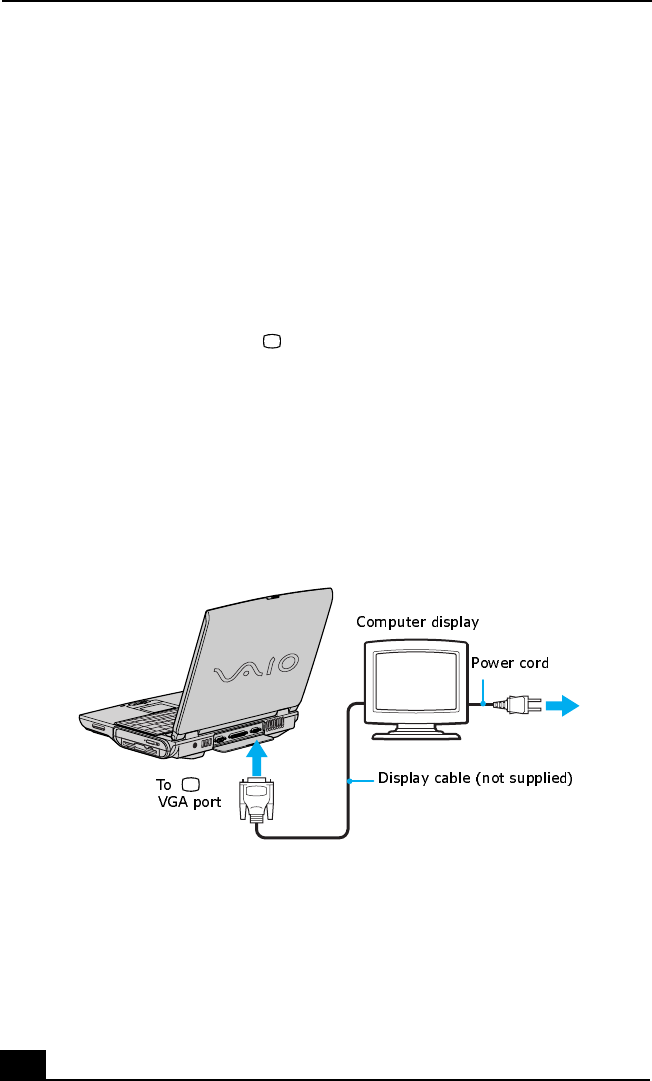
Change text in this variable definition to document title.
62
Connecting an External Display
You can connect any of the following external displays to your computer.
❑Computer display (monitor)
❑Multimedia computer display
❑Projector
To connect a computer display
1Turn off the computer before you connect the computer display.
2Locate the VGA (Monitor) port.
3Plug the display cable (not supplied) into the VGA (Monitor) port.
4Verify that the power cord is plugged into the computer display and an AC
outlet.
5Turn on all external devices before turning on the computer.
To connect a multimedia computer display
1Turn off the computer before you connect the multimedia computer display.
2Locate the AV Out jack on the left panel of the computer.
Connecting an External Computer Display
Kingfisher Draft 2
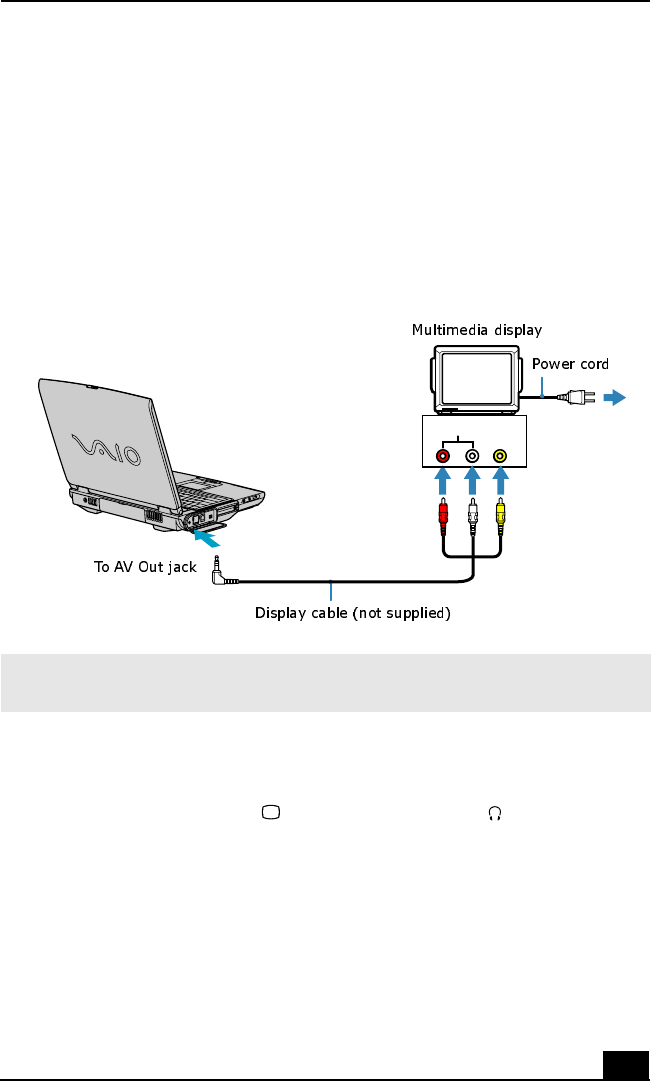
Connecting an External Display
63
3Plug one end of the display cable (not supplied) into the AV Out jack, and
plug the opposite end of the display cable into the multimedia computer
display.
4Verify that the power cord is plugged into the multimedia computer display
and an AC outlet.
5Turn on all external devices before you turn on the computer.
To connect a projector
1Turn off the computer before you connect the projector.
2Locate the VGA (Monitor) port and the Headphone jack on the
computer.
3Plug one end of the display cable (not supplied) into the VGA port, and plug
the opposite end into the appropriate port on the projector.
4Plug one end of the audio cable (not supplied) into the Headphone jack, and
plug the opposite end into the appropriate port on the projector.
5Verify that the power cord is plugged into the projector and an AC outlet.
Connecting a Multimedia Computer Display
✍See the manual that came with your multimedia computer display for more
information on its installation and use.
R
Audio In
L
Video In
Kingfisher Draft 2
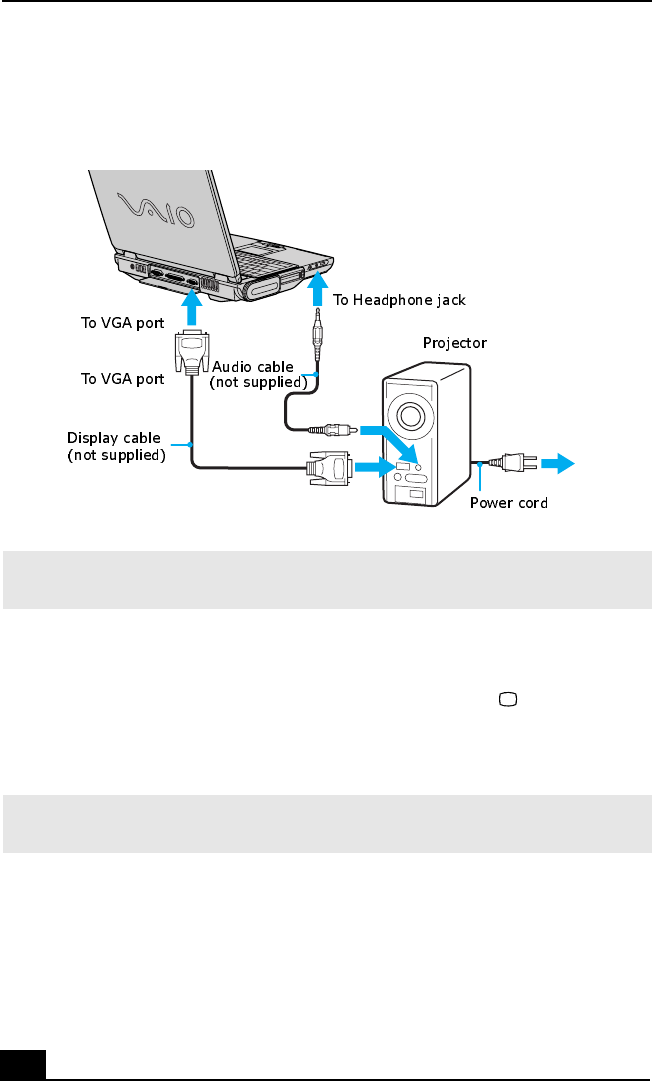
Change text in this variable definition to document title.
64
6Turn on all external devices before you turn on the computer.
Changing the display when connecting an external computer
display or projector
When you connect an external display to the VGA (Monitor) port, you can
toggle the output between the Liquid Crystal Display (LCD), the external
monitor, or both devices. Press the Fn+F7 key combination to select a display. See
“Selecting the Display Mode” for more information.
Connecting a Projector
✍See the manual that came with your projector for more information on its installation
and use.
✍Connect the external display to the computer before you turn it on, otherwise the
Fn+F7 key combination will not work.
Kingfisher Draft 2
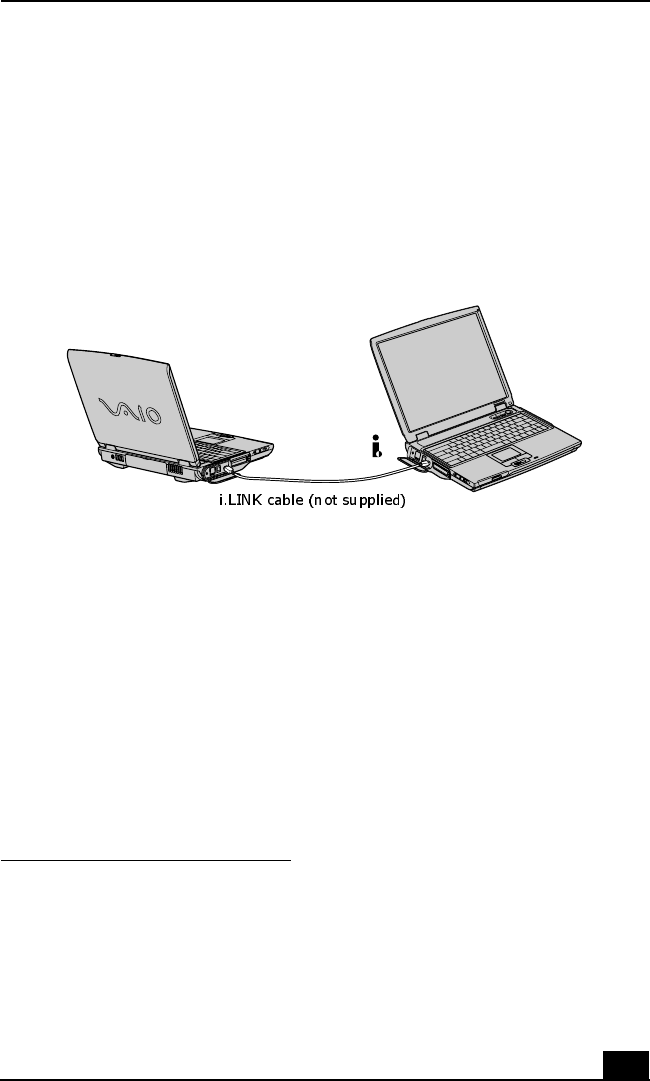
Connecting with another VAIO computer
65
Connecting with another VAIO computer
The preinstalled Microsoft® Windows® XP operating system enables you to use
a compatible i.LINK®* cable (not supplied) to connect your VAIO computer to
another compatible computer. You can use one computer to edit, copy, or delete
files on the other computer. You can also print from a printer attached to either
computer.
To connect two VAIO computers
1Right-click My Computer, and select Properties.
2Select the Computer Name tab, and type in a unique name for the computer.
You will use this unique name to differentiate the two computers once they
are networked together.
3Click Apply, and then click OK.
4Repeat steps 1 to 3 on the second computer.
5Reboot both computers to install these settings.
6Connect one end of the i.LINK cable to the i.LINK port on each computer.
* i.LINK is a trademark of Sony used to designate that a product contains an IEEE 1394 con-
nection. The i.LINK connection may vary, depending on the software applications, operating
system, and compatible i.LINK devices. All products with an i.LINK connector may not
communicate with each other. Refer to the documentation that came with your compatible
i.LINK device for information on operating conditions and proper connection. Before con-
necting compatible i.LINK PC peripherals to your system, such as a CD-RW or hard disk
drive, confirm their operating system compatibility and required operating conditions.
Connecting with an i.LINK Cable
Kingfisher Draft 2

Change text in this variable definition to document title.
66
✍To connect VAIO computers that do not have the latest Windows® operating system,
Smart Connect software may be necessary. Consult the Sony Web site for support
options (http://www.sony.com/pcsupport).
Kingfisher Draft 2
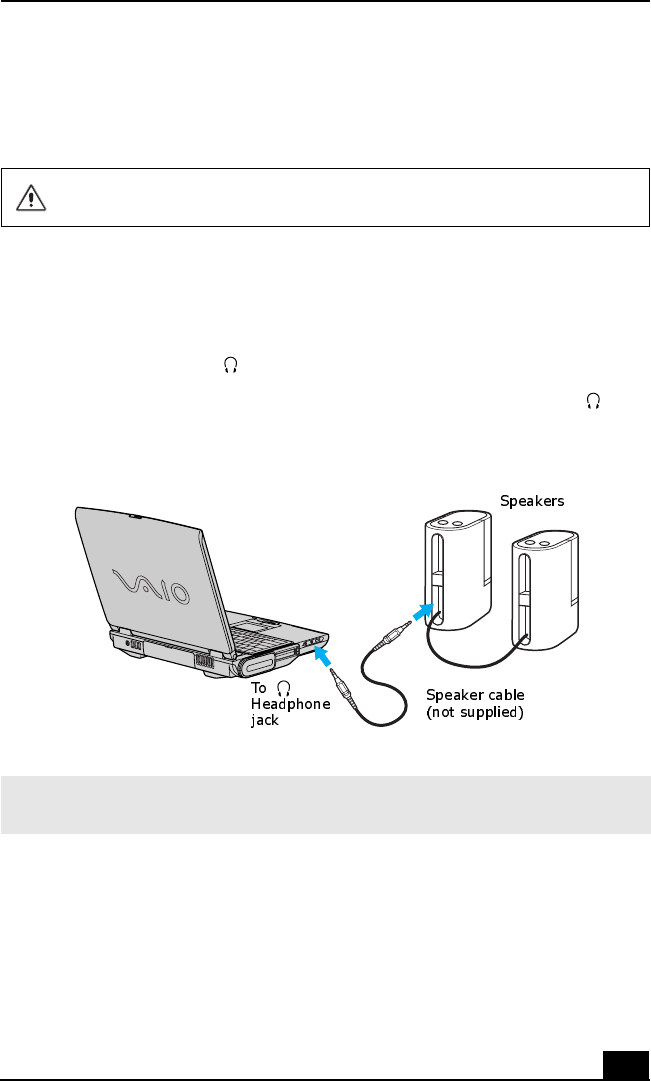
Connecting External Speakers
67
Connecting External Speakers
You can enhance the sound quality of your computer by connecting external
speakers (not supplied).
To connect external speakers
1Make sure that your speakers are designed for computer use.
2Turn down the volume of the speakers.
3Locate the Headphone jack on the left panel of the computer.
4Plug one end of the speaker cable (not supplied) into the Headphone jack.
Notes on connecting external speakers
❑Do not connect external speakers to the AV Out jack. Connecting speakers to
this jack will not damage the speakers, but only one speaker will function.
❑Do not use the external speakers and the compact woofer at the same time.
Using both devices at the same time does not enhance sound quality.
Do not place floppy disks on the speakers. The speakers’ magnetic field
may damage the data on the floppy disks.
Connecting External Speakers to the Headphone Jack
✍See the manual that came with your speakers for more information on its installation
and use.
Kingfisher Draft 2
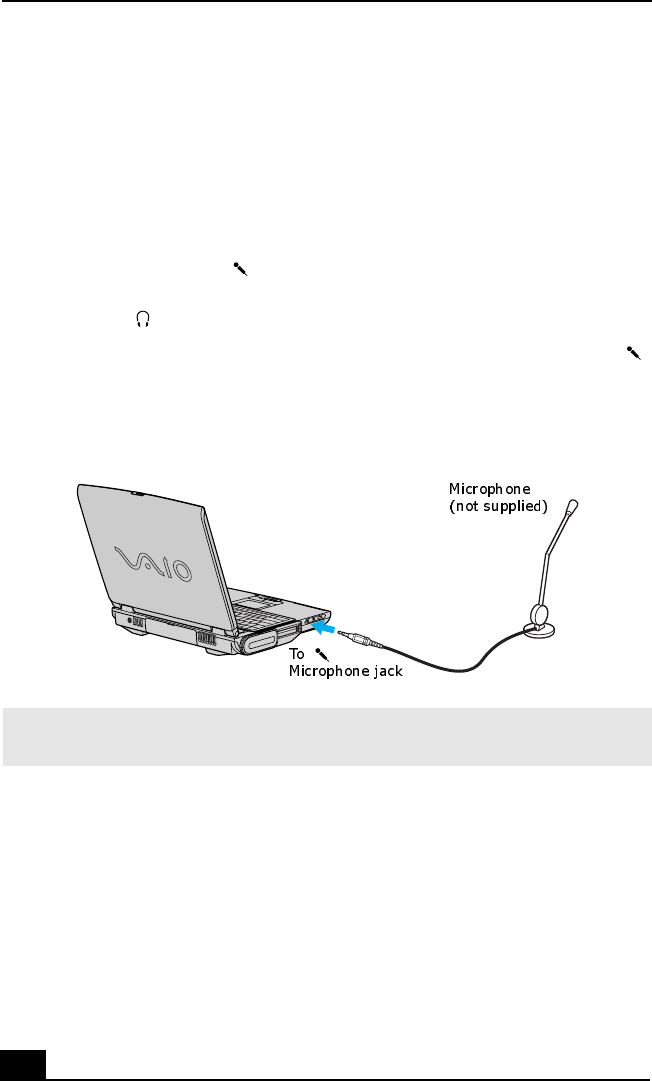
Change text in this variable definition to document title.
68
Connecting an External Microphone
You can enhance the quality of sound input by using an external microphone (not
supplied).
To connect an external microphone
1Make sure that your microphone is designed for computer use.
2Locate the Microphone jack on the left panel of the computer. A
protruding dot above the Microphone jack distinguishes this jack from the
Headphone jack.
3Plug one end of the microphone cable (not supplied) into the Microphone
jack.
To record from a microphone or audio device
You can record messages, memos, or other recordings in analog by connecting a
microphone or other audio device to the Microphone jack of your computer and
switching the jack’s functionality. The Microphone jack is for MIC IN
(monaural).
Connecting External Microphone to a Microphone Jack
✍See the manual that came with your microphone for more information on its
installation and use.
Kingfisher Draft 2

Connecting an External Microphone
69
1Double-click the Volume icon on the taskbar. The Volume Control
window appears.
2From the Options menu, click Properties. The Properties window appears.
3In the Adjust volume for box, click the Recording option button to select it,
and then click OK. The Recording Control window appears.
4If it is not already turned on, click the Select check box at the bottom of the
Microphone column. Close the Recording Control window.
5Click Start on the taskbar, and select All Programs, Accessories,
Entertainment, and then Sound Recorder. The Sound - Sound Recorder
window appears.
Adjusting the volume
You can adjust the volume for playing or recording, but you can only adjust the
recording volume in the Recording Control window. If you adjust the volume, the
adjustment is only effective for playing sound. It does not adjust the volume for
recording sound.
To adjust the volume when playing
1Double-click Volume icon in the taskbar. The Volume Control window
appears.
2In the Volume Control column, move the slider up for increased volume and
down for decreased volume.
✍You are ready to begin recording. For help using Sound Recorder, click Help in the
Sound Recorder window.
Sound device Function
Volume Control Adjusts the sound level from the speakers or
headphones.
Wave Adjusts the wavfile sound or the system sound of
Windows.
SW Synth Adjusts the internal or external synthesizer volume.
Kingfisher Draft 2

Change text in this variable definition to document title.
70
CD Audio Adjusts the volume of the CD in the optical disc
drive.
Microphone Adjusts the internal or external microphone
volume.
Telephony Adjusts the modem or telephone line volume.
PC Beep Adjusts the beep sound when inserting or removing
the PC Card and other devices.
Line Adjusts the sensitivity of volume input.
Sound device Function
Kingfisher Draft 2

Expanding Your Computer Capabilities
71
Expanding Your Computer Capabilities
You can connect the following peripheral devices to your computer to expand its
capabilities and enhance its versatility to meet your needs:
❑A Personal Digital Assistant (PDA)
❑A Wireless LAN Access Point
❑A Wireless LAN PC Card
Personal Digital Assistant
A handheld PDA is the quintessential personal planner and entertainment center
that fits in your pocket. With a PDA, you can easily perform the following
functions:
❑Enter your schedule details in the calendar and view them by the day, week,
or month, and even set an alarm to remind you of important events.
❑Keep your contact names, addresses, phone numbers, and other details in the
address book and find them when you need them.
❑Add tasks to the To Do List, prioritize them, and assign them due dates.
❑Synchronize your data with the software on your computer to back up your
data.
❑Track expenses when you are out of the office and transfer the data to your
notebook.
❑Exchange data with your computer.
Wireless LAN Access Point
The Wireless LAN Access Point is designed for building a wireless Local Area
Network (LAN) environment. The Access Point comes with the Wireless LAN
PC Card and required software. You can easily build a wireless LAN
environment by plugging the Access Point into an AC power outlet, installing the
Wireless LAN PC Card in your computer, and using the provided software.
Because a wireless LAN configuration requires no wiring, you can operate
multiple computers more freely than ever before.
You can also connect your Access Point to a telephone line, Integrated Services
Digital Network (ISDN) router, cable modem, or Digital Subscriber Line (xDSL)
modem to share access to the Internet among multiple computers.
Kingfisher Draft 2

Change text in this variable definition to document title.
72
Wireless LAN PC Card
The Wireless LAN PC Card, which comes with the Wireless LAN Access Point,
can be purchased separately and is designed for building a wireless LAN
environment. You can use the Wireless LAN PC Card with or without the access
point. With the access point, you can build a wireless LAN between computers
that are equipped with the Wireless LAN PC Card and gain access to the Internet.
Without the Access Point, you can achieve direct communication (Peer-to-Peer
mode) between computers.
✍For more information on Sony Wireless LAN, go to
http://www.sonystyle.com/vaio/wirelesslan.shtml
Kingfisher Draft 2
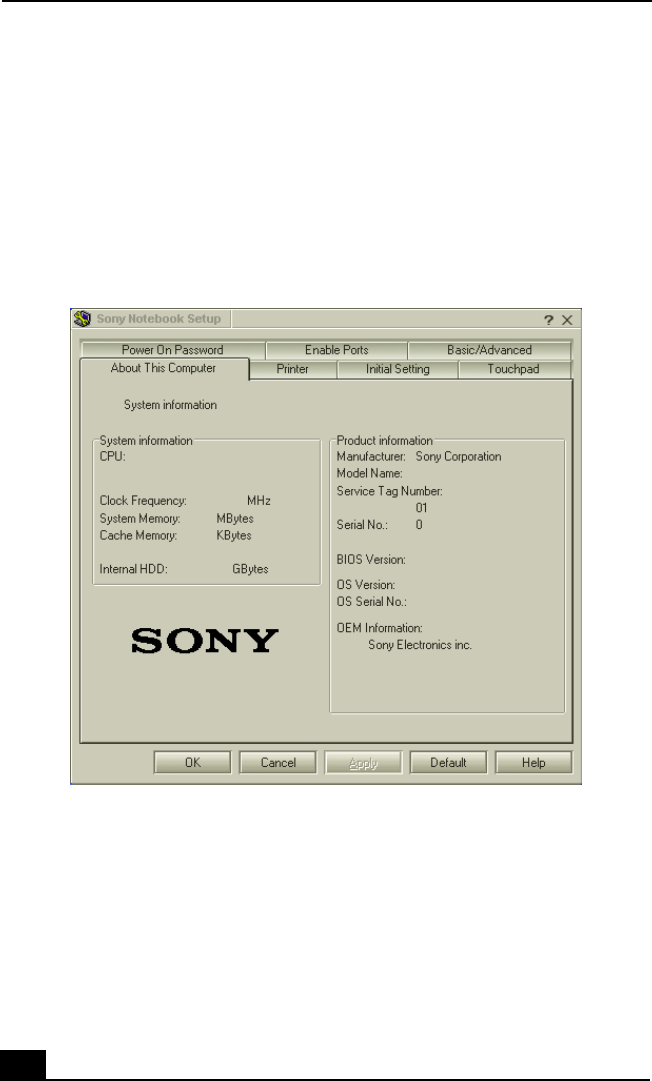
Change text in this variable definition to document title.
74
Displaying the Sony Notebook Setup Screen
To display the Sony Notebook Setup screen:
1Click Start on the Windows® taskbar, and then Control Panel.
2Click Performance and Maintenance, and then Sony Notebook Setup.
3Select the tab for the item you want to change. See “Sony Notebook Setup
tabs” for more information.
4After you finish making your changes, click OK.
Sony Notebook Setup Screen
Kingfisher Draft 2

Displaying the Sony Notebook Setup Screen
75
Sony Notebook Setup tabs
Tab Description
About This Computer Display system information, including memory
capacity, serial number, and BIOS version.
Printer Select printer port mode settings.
Initial Setting Change the volume of the sounds that play while the
operating system is loading. Select the order of drives
and devices from which you want to load the operating
system. You can specify the hard drive as well as other
drives inserted into your computer.
Touchpad When you connect an optional mouse to your
notebook, you can make your touchpad inactive. You
can also customize the settings of your mouse using the
mouse utility.
Power On Password Set the password to secure your computer.
Enable Ports Enable or disable ports. Disabling ports releases
resources to the system. To change the serial settings,
click Advanced on the Basic/Advanced tab.
Basic/Advanced Switch between Advanced mode (additional screens
with advanced settings) and Basic mode of display.
✍For more information about each option, click Help on the Sony Notebook Setup
screen to display the Help file.
Kingfisher Draft 2

Change text in this variable definition to document title.
76
Controlling Power Management
The PowerPanel™ utility allows you to control the power management of your
notebook and provides key information about system activity and battery life.
The following sections briefly describe how to conserve your computer’s battery
power. You can also refer to PowerPanel Help for more detailed information. To
activate a profile or command, see “Displaying Battery Information” for more
information.
Viewing the Power Management status icons
The Power Management status icons are displayed in the taskbar at the lower-
right corner of your screen. Move the pointer over the Battery icon to see the tool
tip that displays information about the active profile. Double-click the icon for
additional information.
To change the Power Management profile
1Right-click the CPU: Performance Profile: AC Power icon on the
Windows taskbar.
2Select Profiles from the menu.
3Select a new profile from the pop-up list. See “Power Management profiles”
for a description of available options.
To customize Power Management settings
You can customize the power management settings, such as the system timer and
the brightness of the screen.
✍When you use the battery pack to power your notebook, your system selects the
Maximum Battery Life power management profile by default. If you select a
different power management profile while using battery power, that profile is
selected automatically the next time you use the battery pack to power your
notebook.
Refer to the PowerPanel Help for information on customizing the Power
Management toolbars.
Kingfisher Draft 2

Controlling Power Management
77
1Right-click the CPU: Performance Profile: AC Power icon on the
Windows taskbar.
2Select Edit/Create Profiles from the menu.
3In the left panel, click a profile in which you want to change the settings.
4In the right panel, double-click an item in which you want to change the
settings.
5Select an option from the drop-down list.
6Click the File menu, then click Save.
7Click the File menu, then click Exit.
Power Management profiles
The PowerPanel™ utility provides several predefined power management
profiles. Each profile consists of a group of power management settings that are
designed to meet specific power management goals — ranging from maximum
power management to no power management. You can change the settings for
any of the predefined profiles (except for the Disable Power Management
profile), or you can create your own profile to suit your portable computing
needs. The predefined profiles are:
Icon Description
Maximum Performance
Provides the best system performance while still conserving power.
Maximum Battery Life
Provides power saving features to give you maximum battery life and
good performance. It slows the notebook and puts it into Standby mode
after a specified time period.
Power Management Off
Disables all power management settings, such as Standby and
Hibernate modes. You can not change the settings of this profile.
Kingfisher Draft 2
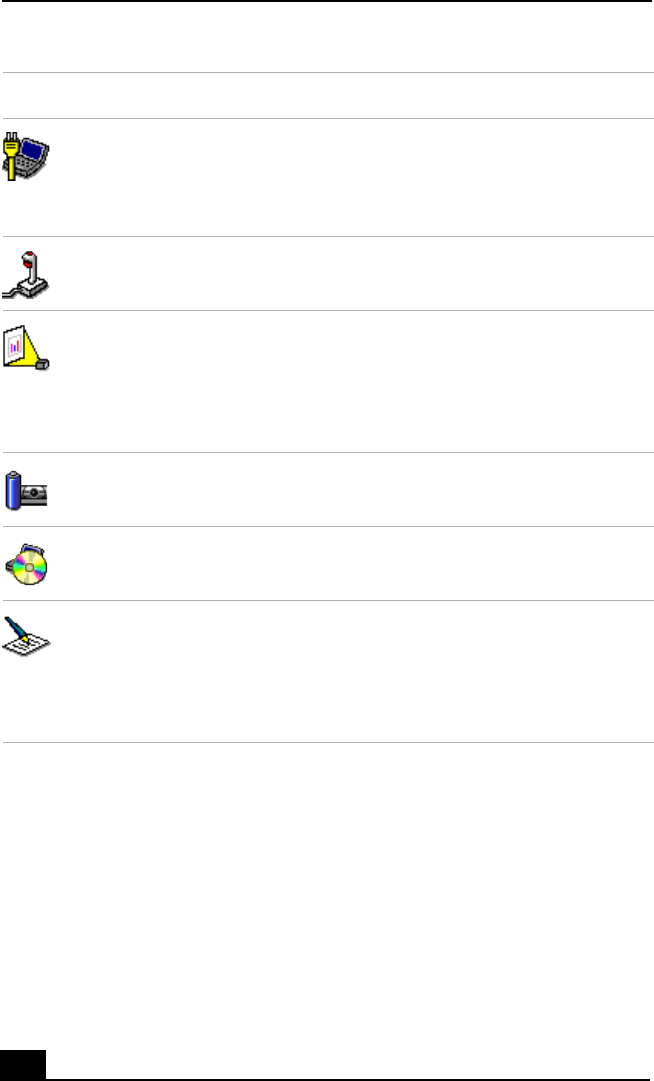
Change text in this variable definition to document title.
78
AC Power
The power management state when AC power is in use. Similar to the
Power Management Off setting. Power Management automatically
loads the AC profile unless you disable this feature.
Games
Disables the display and the Hard Disk Standby timer.
Presentation
Keeps the display on at all times while it conserves power. This option
is ideal for slide show presentations. You can establish settings for
LCD (Video) Standby, Hard Disk Standby, and Standby mode to
optimize power management for your system.
Camera
Optimizes performance and power requirements for camera usage.
DVD
Optimizes performance and power requirements for DVD usage.
Word Processing
Optimizes power management with longer timeouts on the hard disk
and display screen. You can also establish settings for LCD (Video)
Standby, Hard Disk Standby, and Standby mode to optimize power
management for your system.
Icon Description
Kingfisher Draft 2

Controlling Power Management
79
Power Management commands
PowerPanel™ also provides power management commands that you can use to
activate specific power management functions and to control power for a specific
device. You can use these commands to override a profile setting or initiate an
immediate action.
❑Standby — Puts the system into Standby mode, a power management state
that saves the state of the system and peripheral devices in memory (RAM).
Power consumption reduces to a minimum, and the system remains on. To
return the system to the active state, press any key on your computer. Your
notebook is preset to enter Standby mode after 25 minutes.
❑Hibernate — Provides for the lowest level of power consumption. The
system writes the state of the system and peripheral devices to the hard disk
and turns off the system power. To return the system to the original state, use
the power button to turn on power. The system saves the data in the Save to
Disk Partition on the hard drive.
Conserving battery power
When using your notebook with a battery, the LCD display and the hard drive
can be set to switch off automatically to conserve battery power.
Spreadsheet
Optimizes performance and power requirements for spreadsheet
applications.
Communications
Extends battery life by initiating a quick display timeout. The Internal
modem remains powered. You can also establish settings for LCD
(Video) Standby, Hard Disk Standby, and Standby mode to optimize
power management for your system.
Automatic Profile Selection
Automatically switches to a profile suitable for active applications.
✍Do not choose the Automatic Profile Selection when connected to AC power.
Icon Description
Kingfisher Draft 2
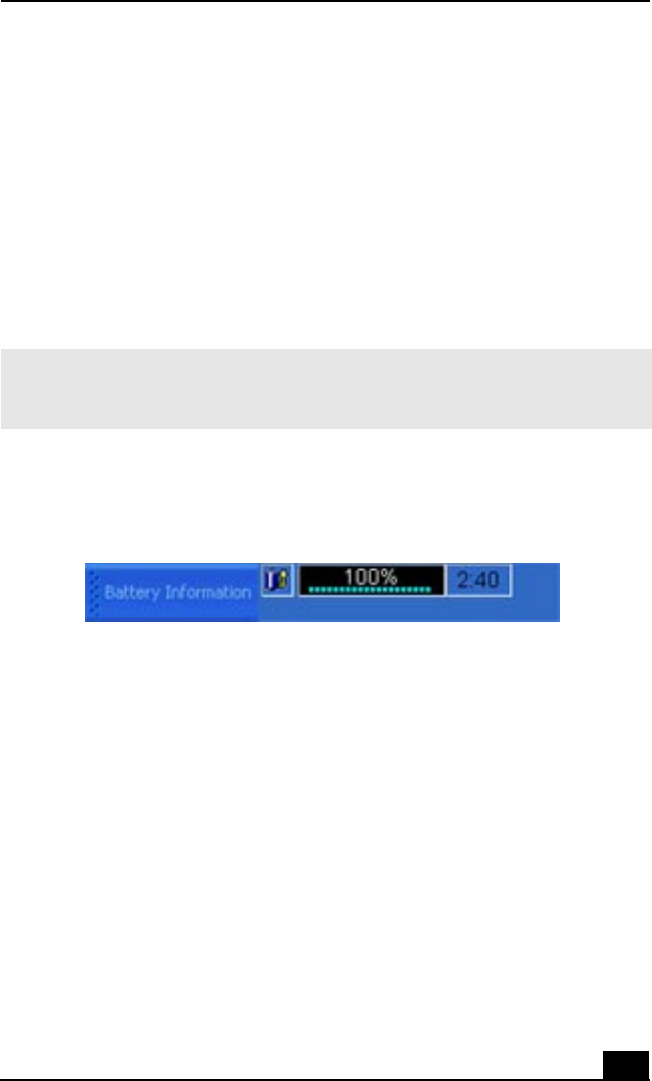
Displaying Battery Information
81
Displaying Battery Information
You can display information for each of the batteries in your notebook. The
following sections briefly describe how to display your notebook’s general
battery information. Refer to PowerPanel Help for more detailed information.
To activate the Battery Information toolbar
1Right-click on the Windows taskbar at the bottom of the screen.
2Select Toolbars from the pop-up menu, and then click Battery Information.
The Battery Information toolbar appears on the taskbar.
To view the total charge remaining in the battery, place the pointer over the
battery status icon in the taskbar on the lower-right corner of the screen.
❑Time indicator — Displays estimated time (hours : minutes) remaining
before the battery fully discharges, also known as the time-to-empty.
✍If the Battery Information toolbar is hidden behind the taskbar icons, right-click the
taskbar and deselect Lock the Taskbar, then click and drag the edge of the Battery
Information toolbar to the left.
Battery Information Toolbar
Kingfisher Draft 2

Change text in this variable definition to document title.
82
Battery icon descriptions
Displaying detailed battery information
Double-click the battery icon on the taskbar to display the Battery Information
window. The Battery tab contains information such as battery charging time and
duration of the battery charge.
Battery icon Battery status
Charging
Fully charged
Discharging
No battery
Kingfisher Draft 2
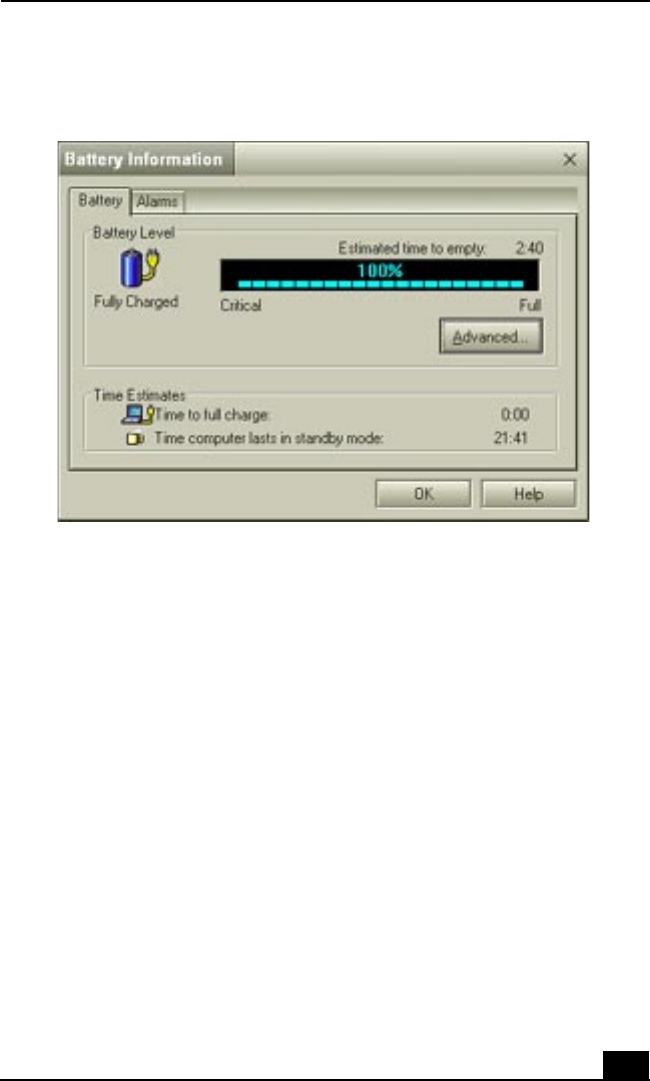
Displaying Battery Information
83
Customizing the Battery Information toolbar and alarm system
You can customize the Battery Information toolbar and modify the alarm
settings, to suit your portable computing needs. Refer to PowerPanel™ Help for
more information.
Battery Information Window
Kingfisher Draft 2

Change text in this variable definition to document title.
84
Selecting the Display Mode
This notebook uses the ATI video controller. You can select which display is used
when the notebook is connected to an external monitor. When you connect an
external display, you can switch the display mode between your notebook’s LCD
display and the external monitor.
1Click Start, point to Control Panel, and click Appearance and Themes.
2Click Display to access the Display Properties window.
3Click the Settings tab, and then click the Advanced button. The “(Multiple
Monitors) and Mobility Radeon Properties” dialog box appears.
Kingfisher Draft 2
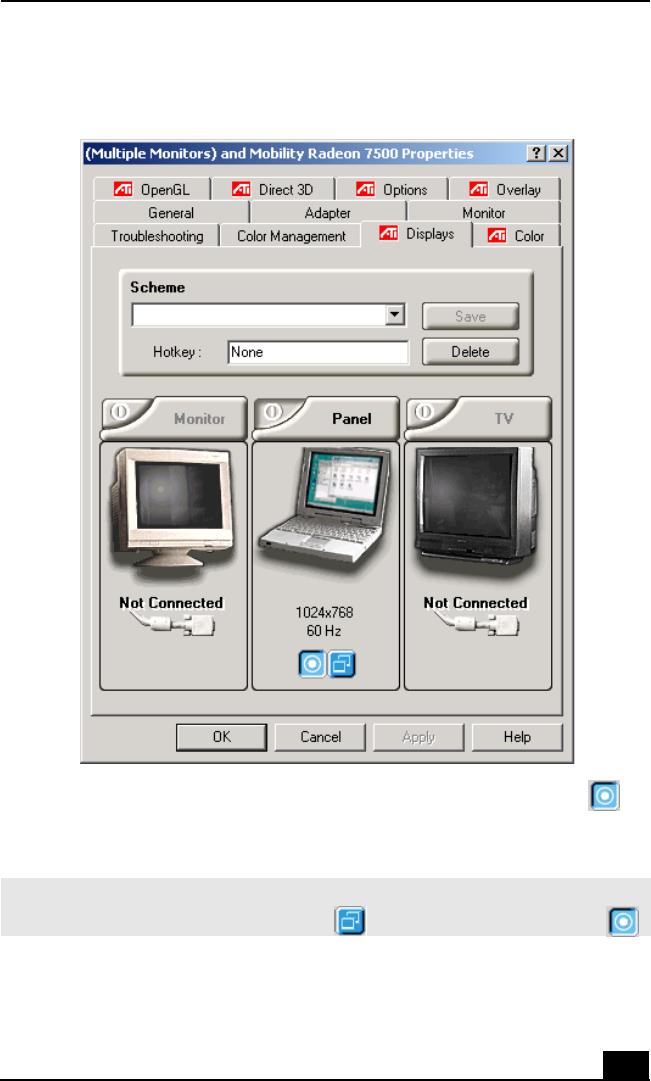
Selecting the Display Mode
85
4Click the Displays tab and select the display settings by clicking the
icon on the panel of your display choice. For more information, click the
Help button.
(Multiple Monitors) and Mobility Radeon Properties screen
✍If you cannot see your movie or DVD on the external display, change the monitor or
TV setting by clicking on the Secondary icon and changing it to Primary .
Kingfisher Draft 2

Change text in this variable definition to document title.
86
Changing the window design of Sony software
To change the window design
1Click the Start button, and then click Control Panel.
2In the left window pane of Control panel, click “Switch to Classic View.”
3Double-click UI Design Selector.
4Click or and select the desired design.
5Click Apply. The “UI Design Selector” window design changes. The
window design for your Sony software will match the “UI Design Selector”
window.
6To try another selection, click or and then click OK to close
the UI Design Selector.
Display Properties Notes
If you change the factory display screen settings to 1600 x 1200 pixels, you can
increase the display font size as well.
To increase the display font size
1Click Start, point to Control Panel, and click Appearance and Themes.
2Click Display. The Display Properties window appears.
3Click the Appearance tab, and select a larger display font size from the drop-
down list.
4Click OK.
✍You may not be able to display the notebook LCD screen and an external display or
projector at the same time, depending on the types of computer displays and
projectors you are using.
Turn on the notebook after you connect the external display.
✍This feature is available with UI Design Selector-compatible software only.
Kingfisher Draft 2

87
Adding Memory
In the future you may want to install memory modules to expand the
functionality of your computer. See the Specifications sheet supplied with
your computer for the amount of preinstalled memory. Expansion memory
modules are available as options. For memory upgrades and information
on which memory modules to use, refer to the Specifications sheet. This
section provides you with information on removing and replacing a
memory module.
❑Precautions and Procedures
❑Typical Expansion Memory Configuration
❑Removing a Memory Module
❑Installing a Memory Module
❑Confirming Added Memory Capacity
Kingfisher Draft 2

Change text in this variable definition to document title.
88
Precautions and Procedures
The procedures described below assume that you are familiar with the general
terminology associated with personal notebooks and with common safety
practices required for using and modifying electronic equipment. Personal injury
or equipment damage may result from failure to take these precautions.
❑Disconnect your system from its power source and from any
telecommunications links, networks, or modems before you open the system
or follow any of the procedures described below. Personal injury or
equipment damage may result from failure to take these precautions.
❑Electrostatic discharge (ESD) can damage memory modules and other
components. Perform the procedures described below only at an ESD
workstation. If such a station is not available, do not work in a carpeted area,
and do not handle materials that produce or hold static electricity
(cellophane wrappers, for example). Ground yourself by maintaining contact
with an unpainted metal portion of the chassis while performing the
procedure.
❑Do not open the memory module package until you are ready to install the
module. The package protects the module from ESD.
❑Use the special bag for preventing ESD or use aluminum foil when you store
the memory module.
Make sure you observe the proper safety precautions when you install
memory modules in your notebook. See the bulleted list below. Be careful
when adding memory. Mistakes made when installing or removing a
memory module may cause a malfunction.
Kingfisher Draft 2

Typical Expansion Memory Configuration
89
Typical Expansion Memory Configuration
Models with 256 MB Memory
Total System Memory (MB) Slot 1 (MB) Slot 2 (MB)
256 256
384 256 128
512 256 256
Kingfisher Draft 2
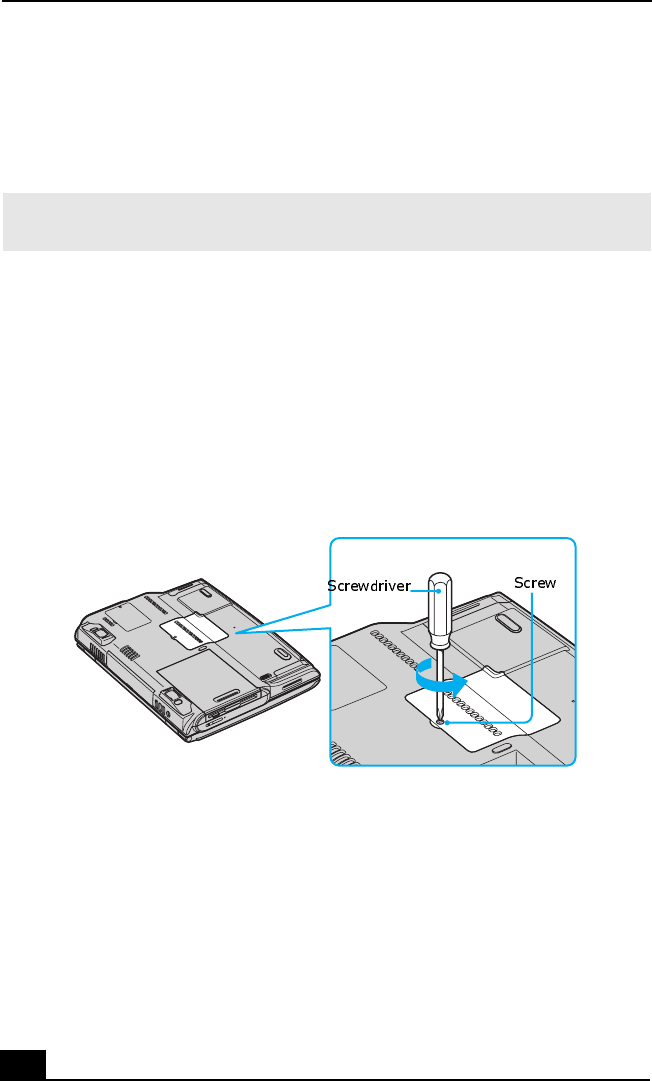
Change text in this variable definition to document title.
90
Removing a Memory Module
Your computer may come with two memory modules already installed in the
memory bay. To upgrade your memory, you may need to remove a module before
you can install an upgrade memory module(s).
1Turn off the computer and disconnect all peripheral devices, such as your
printer.
2Unplug the computer, and remove the battery pack.
3Wait at least one hour for the computer to cool down.
4Use an appropriate screwdriver to loosen and remove the screw that secures
the cover of the memory bay on the bottom of the computer.
5Touch a metal object, such as the connector panel on the back of your
computer, to discharge any static electricity.
✍To install an upgrade memory module into an empty slot, see “Installing a Memory
Module” for instructions.
Removing the Memory Module Cover
Kingfisher Draft 2
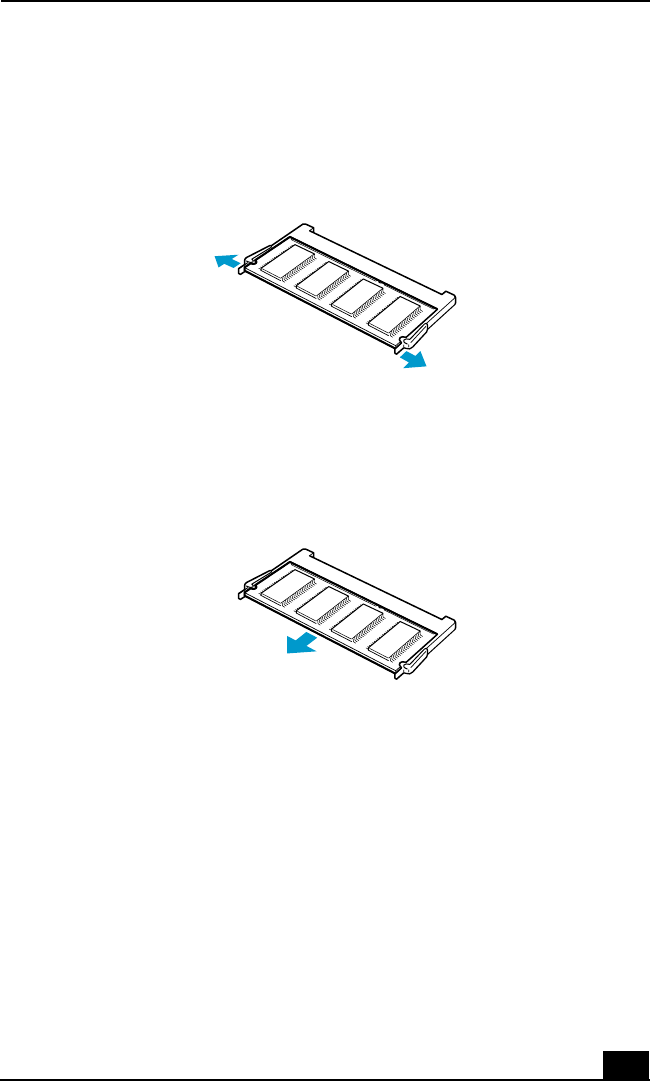
Removing a Memory Module
91
6Pull the metal tabs that hold the memory module in place away from the
module. The memory module pops up and is released from the bay.
7Pull the memory module gently from the memory bay.
8Replace the memory module cover and the screw. Make sure the screw is
tight enough to secure the cover.
Pulling Memory Module Tabs
Pulling Memory Module from Memory Bay
Kingfisher Draft 2
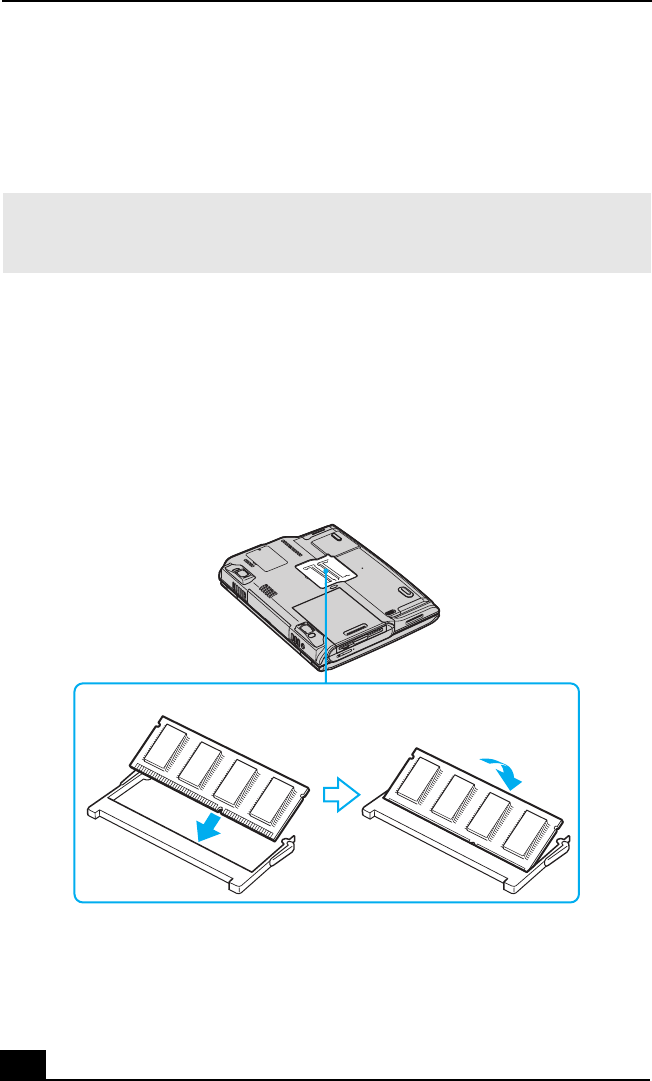
Change text in this variable definition to document title.
92
Installing a Memory Module
Your computer may come with one memory module installed. To upgrade your
computer’s overall memory capacity, you can install a second memory module
into the empty slot.
1Follow steps 1 to 5 of “Removing a Memory Module”.
2Remove the new memory module from its packaging.
3Align the new memory module with the grooves in the memory bay.
4Slide the memory module into the vacant slot, and push it down until it
clicks into place.
5Replace the memory module cover and the screw. Make sure the screw is
tight enough to secure the cover.
✍If two memory modules are already installed in the memory bay and you want to
install an upgrade memory module(s), see “Removing a Memory Module” for
instructions.
Installing a Memory Module
Kingfisher Draft 2

Confirming Added Memory Capacity
93
Confirming Added Memory Capacity
1Restart the computer.
2Click Start on the Windows® taskbar, select All Programs, and click “Sony
Notebook Setup.” The Sony Notebook Setup window appears.
3Click the “About This Computer” tab to view the amount of system memory.
If the additional memory is not shown, remove and reinstall the memory
module.
✍The amount of memory displayed in the Sony Notebook Setup window is not always
correct. The video adapter uses some system memory, and that amount of memory
does not appear as part of the total memory shown in the Sony Notebook Setup
window.
Kingfisher Draft 2

Change text in this variable definition to document title.
94
Kingfisher Draft 2

95
About the Software on Your
Notebook
Your VAIO® computer is ready to help you work, play, learn, and
communicate as soon as you turn it on. This section provides you with
information on the wide variety of software applications installed on your
computer:
❑Software Overview
❑Software Support Information
Kingfisher Draft 2

Change text in this variable definition to document title.
96
Software Overview
Your computer may not be supplied with all of the software listed below,
depending on the configuration you purchased. Preinstalled software may not be
identical to retail versions, or include supporting documentation.
Adobe® Acrobat® Reader®
Adobe Systems Inc.
Acrobat Reader software allows you to view, navigate, and print electronic
documents in Adobe’s Portable Document Format (PDF), an open file format
that is intended to preserve the fidelity of documents created on all major
computer platforms.
Adobe® Photoshop® Elements (On selected models)
Adobe Systems Inc.
Using state-of-the-art image editing tools, you can unleash your artistic ability
and create digital images for print, e-mail and posting to the Web. The versatile
image capturing options allow you to start working with digital and traditional
photos immediately. Explore endless creative possibilities for your personal
images with Adobe Photoshop Elements software.
Adobe® Photoshop® Elements Trial Version (On selected models)
Adobe Systems Inc.
Using state-of-the-art image editing tools, you can unleash your artistic ability
and create digital images for print, e-mail, and posting to the Web. The versatile
image capturing options enable you to start working with digital and traditional
photos immediately. Explore extensive creative possibilities for your personal
images with Adobe Photoshop Elements software. This trial version allows you
to evaluate the software for 30 days, after which you can purchase it for a special
price.
Adobe® Premiere® LE (On selected models)
Adobe Systems Inc.
Adobe Premiere LE software offers interface and editing tools for producing
movies for video, multimedia, or the Web. View source clips and edited footage
simultaneously on-screen. You can create your own personal video clips that are
up to three hours in length, with complete audio-video synchronization.
Kingfisher Draft 2

Software Overview
97
America Online®
America Online, Inc.
America Online is a popular Internet online service. Stay in touch with family
and friends with easy-to-use e-mail. Manage your personal finances, get the latest
news and sports scores, and chat with thousands of others who share your
interests.
AT&T WorldNet® Service
AT&T Corp.
AT&T WorldNet Service offers fast, reliable Internet access. Customer benefits
include Web-based e-mail, video e-mail, multiple e-mail accounts, free Web
pages, online and live agent technical support, instant messaging, and parental
controls.
DigitalPrint
Sony Electronics Inc.
This image management software makes it fun and easy to edit, import, and
organize your digital pictures in a photo album for rich digital printing to any
standard color laser or ink-jet printer. DigitalPrint can also be used to make
custom CD labels for your audio CDs.
DVgate™
Sony Electronics Inc.
Connect a digital video camera recorder to the i.LINK® port and capture your
own video clips and still images. You can edit clips from your video, add new
clips, and combine clips into new movie segments. You can also save your
images in a variety of popular file formats.
EarthLink Network Total Access®
EarthLink, Inc.
An Internet Service Provider that supplies access, information, and assistance to
its customers, introducing them to the Internet. Member benefits include e-mail,
newsgroups, a Personal Start Page, free storage space for your personal Web site,
a member magazine, and 24-hour technical support.
Kingfisher Draft 2

Change text in this variable definition to document title.
98
EverQuest (On selected models)
Sony Online Entertainment Inc.
This introductory edition of EverQuest, a living, constantly evolving fantasy
world, takes users to new heights of online role-playing gaming. Enter an
enormous virtual environment—an entire world with its own diverse species,
economic systems, alliances, and politics. Make yourself a noble human knight, a
vicious dark elf thief, a greedy dwarven merchant, or whatever your heart desires
as you meet new friends from around the world and face epic challenges.
Jog Dial Utility
Sony Electronics Inc.
Jog Dial Utility software enables you to easily scroll, launch applications, access
settings, and perform other useful functions by manipulating the Jog Dial™
Control, located near the touchpad.
Microsoft® Office XP Small Business Edition (On selected models)
Microsoft Corp.
With Microsoft Office XP system you’ll find a powerful new technology that will
help you get work done more quickly by providing real-time, context-sensitive
options for important actions, from formatting to error correction. Task panes
consolidate important tasks into a single integrated view, enabling you to conduct
searches, launch and format documents, and view the contents of your Clipboard
from one location.
Microsoft® Office XP Professional (On selected models)
Microsoft Corp.
Microsoft Office XP software redefines the relationship between people and
software by providing a smarter, simpler way of working. New Office XP
software features include context-sensitive smart tags, enhanced formatting
options, and more, that enable you to continually integrate additional services
into Office and access information anytime.
Microsoft® Word (On selected models)
Microsoft Corp.
Microsoft Word makes it easy to create common Web, e-mail, and print
documents for use around the world. It embraces HTML as a first-class file
format and extends Word's ease-of-use to the Web and e-mail. Word also extends
that ease-of-use to international users, making it easy to create multilingual
documents.
Kingfisher Draft 2

Software Overview
99
MovieShaker™
Sony Electronics Inc.
Sony’s original MovieShaker software creates personal movies that have
transitions, background music, and text. Just import your video clips and “shake”
with a click of the mouse. Your personal movies are easy to create and fun to
share with family and friends.
PC-Cillin® 2000
Trend Micro, Inc.
PC-Cillin software provides portable, easy-to-use, real-time antivirus security at
your computer’s entry point (beaming, synchronization, Internet access) to
defend against potential threats hidden inside files, e-mail, or on the Web.
PicoPlayer™
Sony Electronics Inc.
PicoPlayer software is a video player utility that enables you to use Giga
Pocket™ Personal Video Recorder functions on a computer that does not have
Giga Pocket Personal Video Recorder installed. You can play Video Capsules
created by Giga Pocket Personal Video Recorder, and, if a Giga Pocket Server is
available on your home network, watch TV streamed from the Giga Pocket
Server and remotely control the Giga Pocket Server’s TV programming
functions.
Quicken® 2002 New User Edition
Intuit Inc.
Quicken software is a fast, easy way to organize your finances. Quicken software
works just like your checkbook, so it's easy to learn and use. You can even pay
your bills online. Quicken software manages all of your finances, bank accounts,
credit cards, investments, and loans. (Users of earlier versions of Quicken must
upgrade for a fee.)
QuickTime®
Apple Computer, Inc.
The versatile QuickTime software is used to play hundreds of different kinds of
files, including video, audio, and virtual reality (VR) movies. You can play
QuickTime files (referred to as “QuickTime movies”) using QuickTime Player or
any other application, such as a Web browser or word processor, that supports
QuickTime software.
Kingfisher Draft 2

Change text in this variable definition to document title.
100
RealPlayer®
RealNetworks, Inc.
RealPlayer software is a high-quality streaming media player that supports many
digital media formats. The user-friendly interface has enhanced navigation
capabilities, allowing you to access and enjoy audio and video programming over
the Internet. RealPlayer software is your gateway to a superb Internet multimedia
experience.
Smart Capture
Sony Electronics Inc.
Smart Capture is a fun new way to send multimedia messages via e-mail. Smart
Capture manages the i.LINK® connection between your notebook and a Sony
Digital Handycam® Camcorder that supports the i.LINK interface. It allows you
to capture compressed video or still images and save them to your hard disk drive
or share via e-mail. A smart solution for computer, digital audio/video and
network convergence.
SonicStage™
Sony Electronics Inc.
This new jukebox application adds a host of new features to its predecessor,
OpenMG™ Jukebox. Continuing to take advantage of Sony’s copyright-
protected ATRAC3™ format for high-quality digital audio storage, SonicStage
software sports a new music visualizer, a sleek new player skin design, audio CD
burning capability, and a parametric equalizer for fine-tuning audio playback.
Sony ScreenBlast™ ACID (On selected models)
Sony Pictures Digital Entertainment
With the powerful Sony ScreenBlast ACID software you can create royalty-free
music by utilizing its loop-based production tool, including unlimited tracks and
enhanced effects.
Sony ScreenBlast™ Sound Forge (On selected models)
Sony Pictures Digital Entertainment
Sony ScreenBlast Sound Forge allows you to record, edit, and process mono or
stereo audio files for your multimedia or Internet projects. Whether you want to
use a number of professional effects, convert video into streaming media, or
synchronize audio to video — this software has everything you need to create
rich, immersive multimedia and Internet content.
Kingfisher Draft 2

Software Overview
101
Sony on Yahoo!
Yahoo! Inc.
Personalize your own web portal with Sony on Yahoo! Get a free webmail
account, customized news and local weather reports, comics, instant messaging,
and more.
VAIO Support Agent
Sony Electronics Inc.
VAIO Support Agent provides immediate, interactive, online support with
information about your preinstalled software and answers to frequently asked
questions.
WinDVD®
InterVideo, Inc.
WinDVD software is a simple-to-use DVD player including all the features you
would expect to find in a standard consumer DVD player, while also offering
advanced display and navigation features such as zoom, pan, bookmark, and time
search.
Kingfisher Draft 2

Change text in this variable definition to document title.
102
Software Support Information
Adobe® Acrobat®Reader®, Photoshop® Elements, Photoshop® Elements
Trial Version, Premiere® LE (Adobe Systems Inc.)
America Online® (America Online, Inc.)
EarthLink Network Total Access® (EarthLink, Inc.)
PC-Cillin® 2000 (Trend Micro, Inc.)
Quicken® 2002 New User Edition (Intuit Inc.)
Web site http://www.adobe.com/
e-mail techdocs@adobe.com
telephone 206-675-6126 (fee-based support)
fax 206-628-5737
hours M-F, 6 AM-5 PM (PST)
Web site http://www.aol.com/
telephone 800-827-6364
hours 7 days a week, 24 hours a day
Web site http://support.earthlink.net/
e-mail support@earthlink.net
telephone 800-890-5128 or 800-890-6356
hours 7 days a week, 24 hours a day
Web site http://www.antivirus.com/pc-cillin/support/
telephone 510-859-0308; 900-820-8324*
* Support from 510-859-0308 is free of charge, but subject to delays. Support from 900-820-
8324 is fee-based, but offers immediate response.
hours M-F, 8 AM-5 PM (PST)
Web site http://www.intuit.com/support
telephone 900-555-4932; 800-644-3193*
hours M-F, 5 AM-5 PM (PST)
Kingfisher Draft 2

Software Support Information
103
QuickTime® (Apple Computer, Inc.)
RealPlayer® (RealNetworks, Inc.)
Sony Applications (Sony Electronics Inc.)
Windows® Operating System, Office XP, Word (Microsoft Corp.)
WinDVD® (InterVideo, Inc.)
Sony Service Center
For the Sony Service Center nearest you, call 1-888-4-SONY-PC
(1-888-476-6972) or find Sony Customer Service on the Web at
http://www.sony.com/pcsupport.
* Support from 900-555-4932 is fee-based. Support from 800-644-3193 is automated and free of
charge.
Web site http://www.apple.com
telephone 800-275-2273
hours M-F, 6 AM-6 PM (PST)
Web site http://service.real.com/rjoptions.html
e-mail http://service.real.com/help/call.html (online email form)
Web site http://www.sony.com/pcsupport
telephone 888-4-SONY-PC (888-476-6972)*
* Support from 1-888-4-SONY-PC is free of charge for 90 days after the original date of purchase.
hours 7 days a week, 24 hours a day
Web site http://www.sony.com/pcsupport
telephone 888-4-SONY-PC (888-476-6972)*
* Support from 1-888-4-SONY-PC is free of charge for 90 days after the original date of purchase.
hours 7 days a week, 24 hours a day
Web site http://www.intervideo.com
telephone 510-651-0888
Kingfisher Draft 2

Change text in this variable definition to document title.
104
Kingfisher Draft 2

VAIO® Computer Quick Start
106
Application, Driver, and System Recovery CDs
Your computer comes with the following Application Recovery, Driver
Recovery, and System Recovery CDs. You will need an optical disc drive
(supplied with selected models) to use these recovery CDs. If your computer
does not come with an optical disc drive, use an external optical disc drive.
Application Recovery CD(s)
Sony Electronics Inc.
This CD enables you to reinstall individual applications if they become corrupted
or are erased.
Driver Recovery CD(s)
Sony Electronics Inc.
This CD enables you to reinstall individual device drivers if they become
corrupted or are erased.
System Recovery CD(s)
Sony Electronics Inc.
This CD enables you to restore the operating system and software that shipped
with your computer if they become corrupted or are erased. This CD restores
your computer to its original factory settings, so user data and applications
installed since you started using your computer will be lost.
✍For models that come with a docking station, make sure you connect the docking
station to the computer before using the recovery CDs.
Kingfisher Draft 2

Using Your Recovery CDs
107
Using Your Recovery CDs
The following sections describe how to use the Application Recovery, Driver
Recovery, and System Recovery utilities.
To use the Application Recovery CD(s)
The Application Recovery CD(s) enables you to reinstall individual applications
if they become corrupted or are accidentally erased. Reinstalling an individual
software title may correct a problem you are experiencing with your computer or
software application; you may not need to reinstall the entire contents of your
hard drive. If you need to reinstall all the software titles that shipped with your
notebook, use the System Recovery CD(s). If you have any questions on using
the Application Recovery CD after reading this section, contact Sony Customer
Support.
1Turn on your computer. If your computer is already on, close all
applications.
2When the Windows desktop appears, insert the Sony Application Recovery
CD in the optical disc drive. The Application Recovery utility loads
automatically.
3When the Application Recovery menu appears, select the icon for the
application you want to restore, and then follow the on-screen instructions to
complete the recovery process.
✍You must be in Windows to run the Application Recovery CD. If you have any
questions on using the Application Recovery CD after reading this section, contact
Sony Customer Support.
✍Your system may include one or two Application Recovery CDs. If you have two
Application Recovery CDs, insert the first CD to run the Application Recovery
program. You may be prompted to insert the second CD, depending on the
application you wish to restore.
Kingfisher Draft 2

VAIO® Computer Quick Start
108
To use the Driver Recovery CD(s)
The Driver Recovery CD utility enables you to reinstall individual drivers if they
become corrupted or are erased. You can reinstall an individual driver to correct a
problem that you are experiencing with your computer, hardware, or software
application. VAIO Support Agent, an application repair utility, uses a vault
feature on the Driver Recovery CD(s) to repair software applications.
You must be in Windows to run the Driver Recovery CD utility.
Reinstalling specific drivers with the Driver Recovery CD
1Turn on your computer. If your computer is already on, close all
applications.
2When the Windows desktop appears, insert the Driver Recovery CD into the
optical disc drive.
3Click Start on the Windows taskbar, and click Control Panel. The Control
Panel window appears.
4Click Performance and Maintenance, then System. The System Properties
dialog box appears.
5From the Hardware tab, click Device Manager.
6Click to highlight the device for which you wish to reinstall the driver.
7From the Actions menu, select Properties. The Properties dialog box for that
device appears.
✍ If you need to reinstall all of the software applications that shipped with your
computer, use the System Recovery CD.
Kingfisher Draft 2
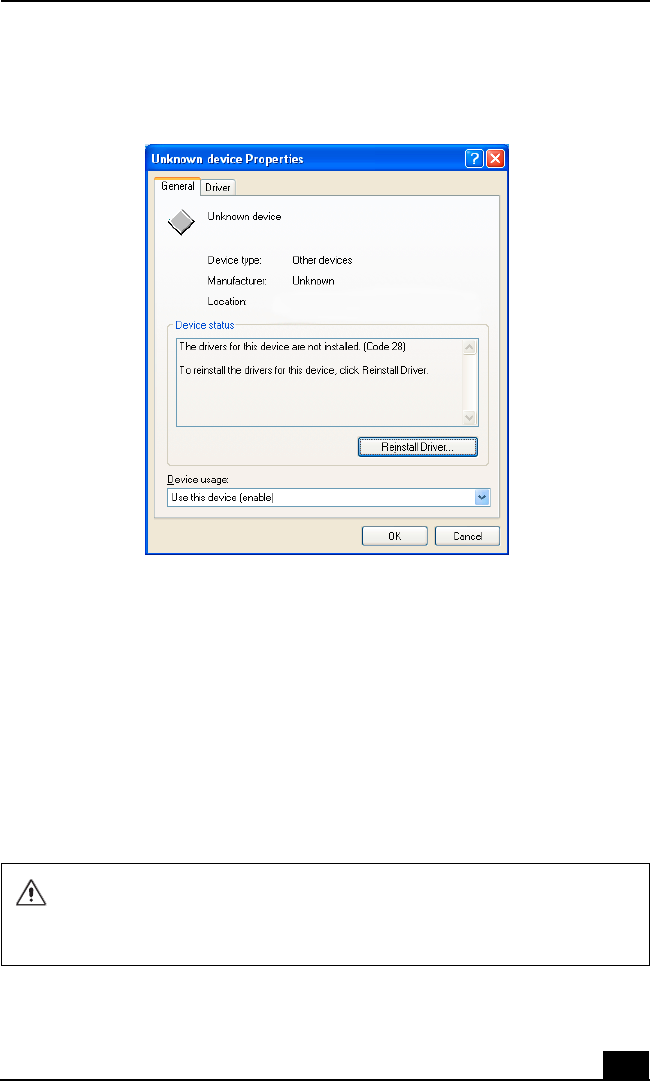
Using Your Recovery CDs
109
8Click Reinstall Driver. The Hardware Update Wizard appears.
9Click next. The wizard searches for the correct driver on your Driver
Recovery CD.
10 When the recovery process is complete, click Finish. Some drivers require
that you restart the computer to complete installation.
To use the System Recovery CD(s)
The System Recovery utility formats your hard disk drive and restores all
original software applications. Your computer is returned to the original factory
settings.
Properties dialog box
The System Recovery process removes all software that you may have
installed since you started using your computer. Reinstall any
applications that were not included with the computer when you
purchased it.
Kingfisher Draft 2

VAIO® Computer Quick Start
110
You can use the System Recovery CD(s) to reinstall the operating system and
software titles that shipped with your computer if they become corrupted or are
erased. You may not need to reinstall the entire contents of your hard drive. If
you experience a problem with your computer, reinstalling an individual device
driver or software title may correct the problem. Use the Application Recovery
CD(s) to reinstall individual applications or use the Driver Recovery CD(s) to
reinstall device drivers.
The System Recovery CD contains a backup copy of all the software originally
installed on your hard disk drive. It can be used only to recover the hard disk of
the computer you purchased.
System Recovery options
❑System Drive Recovery — All data on Drive C is deleted. The factory
default settings and software applications are restored on this drive only.
❑Change Partition Size — All partitions, custom installations, and changes
are removed from the hard disk drive. You can set the partition sizes for both
the Drive C and Drive D. The original, preinstalled operating system and
software applications are restored.
❑Recovery to Original Factory Defaults — All data and partitions are
removed from the hard disk drive. All original factory settings, operating
system, and preinstalled software is restored.
Using the System Recovery CD(s)
Your system may take a few minutes to load necessary files. A blue screen
appears during the downloading process.
1Insert the Sony System Recovery CD in the optical disc drive. The System
Recovery utility starts from the optical disc drive. The first CD must be in
the drive when your turn on the computer.
2Shut down your computer as described in the “Shutting Down Your
Notebook” section of your supplied Quick Start.
3Wait 30 seconds and turn on your computer.
4The VAIO System Recovery Utility dialog box appears. Click Next.
The System Recovery utility does not back up your system’s data. If you
wish to retain your system data, perform a backup to an external media.
Kingfisher Draft 2

Using Your Recovery CDs
111
5At the pop-up prompt, select Yes to begin the system recovery process.
Follow the on-screen instructions.
If your computer does not start from the Recovery CD
1Press the power button and hold it for more than four seconds to turn off the
computer.
2Turn on the computer. When the Sony logo is displayed, press the F2 key.
The BIOS setup menu screen appears.
3Press the arrow keys to select the Exit menu.
4Press the arrow keys to select “Get Default Values” and then press the Enter
key. The message “Load default values for all SETUP items.” appears.
5Check that “Yes” is selected, and press the Enter key.
6Press the arrow keys to select “Save and Exit,” and press the Enter key. The
message “Save configuration changes and exit now?” appears.
7Check that “Yes” is selected, and press the Enter key. The computer restarts
from the Recovery CD.
After recovering your system using the System Recovery CD(s), you may be
prompted to insert your Application Recovery CD(s) after restarting Windows.
Insert the Application Recovery CD to automatically complete recovery of your
system.
✍Your system may include one or more System Recovery CDs. If you have more than
one System Recovery CDs, insert the first CD to run the System Recovery program.
You are prompted to insert the second CD once the information from the first CD has
been installed.
The recovery process takes from 30 to 60 minutes to complete.
Kingfisher Draft 2

VAIO® Computer Quick Start
112
Kingfisher Draft 2

113
Troubleshooting
This section describes how to solve common problems you may encounter
when using your computer. Many problems have simple solutions, so try
these suggestions before you contact Sony Computing Support
(http://www.sony.com/pcsupport). Consult the following sections:
❑Troubleshooting Your Computer
❑Troubleshooting the LCD Screen
❑Troubleshooting the Mouse and Touchpad
❑Troubleshooting Drives, PC Cards, and Peripheral Devices
❑Troubleshooting the Software
❑Troubleshooting i.LINK Devices
❑Troubleshooting the Modem
❑Troubleshooting Audio
❑Troubleshooting Memory Stick Media
❑Troubleshooting Wireless LAN Functions
❑Troubleshooting the Printer
Kingfisher Draft 2

Change text in this variable definition to document title.
114
Troubleshooting Your Computer
My computer does not start.
❑Make sure the computer is plugged into a power source and is turned on.
❑Make sure the power indicator shows the power is on.
❑Make sure the battery packs are inserted properly and are charged.
❑If you are connected to a docking station with a floppy disk drive or an
external floppy disk drive, make sure the floppy disk drive is empty.
❑Make sure the power cord and all cables are connected firmly. See
“Connecting a Power Source” for more information.
❑If the computer is plugged into a power strip or uninterruptible power supply
(UPS), make sure the power strip or UPS is turned on and working.
❑If you are using an external display, make sure it is plugged into a power
source and turned on. Make sure the brightness and contrast controls are
adjusted correctly. See the manual that came with your display for details.
❑Take the battery pack off the computer, unplug the power cord and plug it in
again. Turn on the power.
❑If the power control button does not function, remove the AC adapter and
battery pack. Wait one minute, and reattach them. Press the power button.
❑Condensation may cause the computer to malfunction. If this occurs, do not
use the computer for at least one hour.
❑Unplug the power cord, press the reset button by using a thin, straight object
(such as a paper clip), remove the battery pack, plug it in again and turn on
the power.
My computer starts but a BIOS error appears.
When the internal backup battery is low on power, your system may not start
properly, and the message “Press <F1> to resume, <F2> to setup” may appear at
the bottom of the screen. Follow these steps:
1Press F2. The BIOS Setup menu appears.
2Set the date (month/day/year) next to System Date.
3Press the Down Arrow key to select System Time, and then set the time
(hour: minute: second).
Kingfisher Draft 2
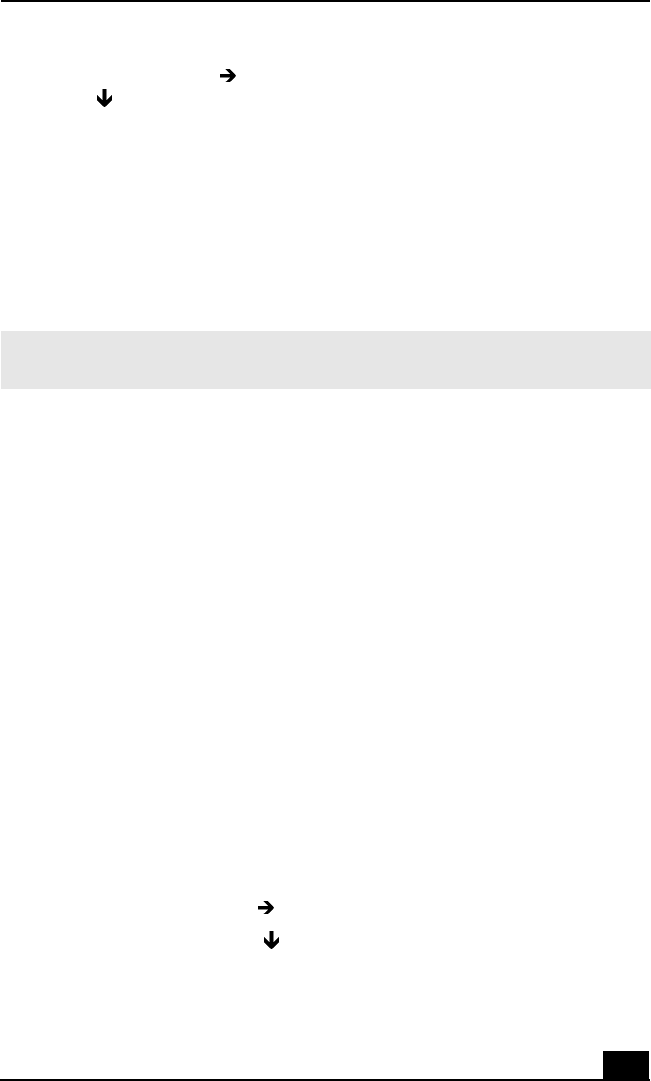
Troubleshooting Your Computer
115
4Press the Right Arrow key to select the Exit tab, and then press the Down
Arrow key to select Get Default Values. The message “Load default
values for all SETUP items” appears.
5Press Enter. The Setup Confirmation window appears.
6Make sure Yes is selected, and press Enter.
7Make sure Exit (Save Changes) is selected, and press Enter. The Setup
Confirmation window appears.
8Make sure Yes is selected, and press Enter. The computer restarts.
My computer starts, but the message “Operating system not
found” appears, and Windows does not start.
❑If you have connected a docking station with a floppy disk drive or an
external floppy disk drive, make sure there is no disk in the floppy disk drive
(non-bootable).
❑If a non-bootable floppy disk is in the drive, follow these steps:
1Turn off the computer, and remove the floppy disk.
2Restart the computer and confirm that the Windows® operating system
starts properly.
❑If Windows still does not start, follow these steps to start the BIOS:
1Remove any floppy disk from the floppy disk drive.
2Turn off the computer.
3Remove any peripheral devices connected to the computer.
4Restart the computer.
5Press F2 when the Sony logo appears. The BIOS setup menu window
appears.
6Press the Right Arrow key to select the Exit menu.
7Press the Down Arrow key to select Get Default Values, and then
press Enter. The message “Load default values for all SETUP items”
appears.
✍If this occurs on a regular basis, contact Sony Computing Support
(http://www.sony.com/pcsupport).
Kingfisher Draft 2

Change text in this variable definition to document title.
116
8Press Enter. The Setup Confirmation window appears.
9Make sure Yes is selected, and press Enter.
10 Make sure Exit (Save Changes) is selected, and press Enter. The Setup
Confirmation window appears.
11 Make sure Yes is selected, and press Enter. The computer restarts.
If your computer continues to display the message “Operating system not found,”
and Windows does not start, use your supplied System Recovery CD(s) to restore
the software titles shipped with your computer. See “To use the System Recovery
CD(s)” for more information.
My computer stops responding or does not shut down.
It is best to turn off your computer using the Turn Off Computer command on the
Windows Start menu. Using other methods, including those listed below, may
result in loss of unsaved data.
❑Click Start on the Windows® taskbar, select Turn Off Computer, and then
click Turn Off.
❑If your computer does not turn off, press Ctrl+Alt+Delete simultaneously
and click Turn Off Computer on the Windows Task Manager dialog box.
❑If your computer still does not turn off, press and hold the power button for
at least four seconds to turn off the power.
❑Unplug the computer from the AC adapter, and remove the battery pack
from your computer.
❑If your computer stops responding while playing a CD or DVD, press
Ctrl+Alt+Delete simultaneously, and click Turn Off Computer on the
Windows Task Manager dialog box.
The System Recovery CD restores your computer to its original state, so
user data and applications will be lost.
✍Pressing the Ctrl+Alt+Delete keys simultaneously or turning off the computer with
the power button may result in data loss in files that are currently open.
Kingfisher Draft 2

Troubleshooting Your Computer
117
The power management does not respond.
Your computer’s operating system may become unstable if a lower power state,
such as Hibernate, is initiated and changed before the computer completely
enters the lower power state.
To restore the computer to its normal operating stability
1Close all open applications.
2Restart the computer by pressing Ctrl+Alt+Delete simultaneously and
clicking Restart on the Windows Task Manager dialog box.
3If this procedure does not work, press and hold the power button for four
seconds or longer to turn off the computer.
The sound of my computer’s fan is too loud.
Use the PowerPanel™ utility to change the Thermal Control Strategy setting to
Quiet. This setting slows down the CPU speed. See PowerPanel Help for more
information.
To reduce fan noise
1Right-click the CPU: Performance Profile icon on the taskbar, and select
Edit/Create Profiles. The AC Power Profile Editor window appears.
2Double-click System to open the file if it isn’t already opened.
3Double-click Thermal Control Strategy - Performance, and select Quiet.
4Restart your computer.
Why does the System Properties dialog box display a slower
CPU speed than advertised?
This is normal. Because your computer’s CPU uses a type of CPU speed
controlling technology, System Properties may display the CPU’s current speed
instead of the maximum advertised speed.
Kingfisher Draft 2

Change text in this variable definition to document title.
118
Troubleshooting the LCD Screen
My LCD screen is blank.
❑Verify the computer is plugged into a power source and is turned on.
❑Verify the power indicator on the computer is on.
❑Verify the battery packs are inserted properly and are charged.
❑The computer may be in LCD (Video) Standby mode. Press any key to
activate the screen.
❑The display mode may be set to external display mode. Press and hold the Fn
key while pressing F7 several times.
My LCD screen continues to show the previous screen.
Press the Windows key and D twice to refresh the screen.
The image on my connected external display is not centered
or sized properly.
Use the controls on your external display to adjust the image. See the manual that
came with your display for more information.
I want to change the video resolution of my display.
1Click Start on the taskbar, and then Control Panel.
2Click Appearance and Themes, and then click the Display icon. The Display
Properties dialog box appears.
3Click the Settings tab.
4Move the Screen resolution slider to change your video resolution.
I want to change the display resolution for AV Out.
1Make sure your computer was started with the AV Out jack plugged in.
2Click Start on the taskbar, and then Control Panel.
3Click Appearance and Themes, and then click the Display icon. The Display
Properties dialog box appears.
Kingfisher Draft 2

Troubleshooting the LCD Screen
119
4Click the Settings tab.
5Move the Screen resolution slider to change your video resolution.
I cannot switch the LCD display to TV and vice versa.
1Ensure that the TV was connected, configured, and powered on correctly
prior to starting the computer. See “Connecting an Audio-Video Device” for
more information.
2Remove the DVD video disc if it is inserted in the optical drive.
3Press Fn+F8 to change the display.
✍You must set the screen resolution to 640 x 480 dots to play a DVD while using the
AV Out jack. See “Connecting an Audio-Video Device” for more information.
Kingfisher Draft 2
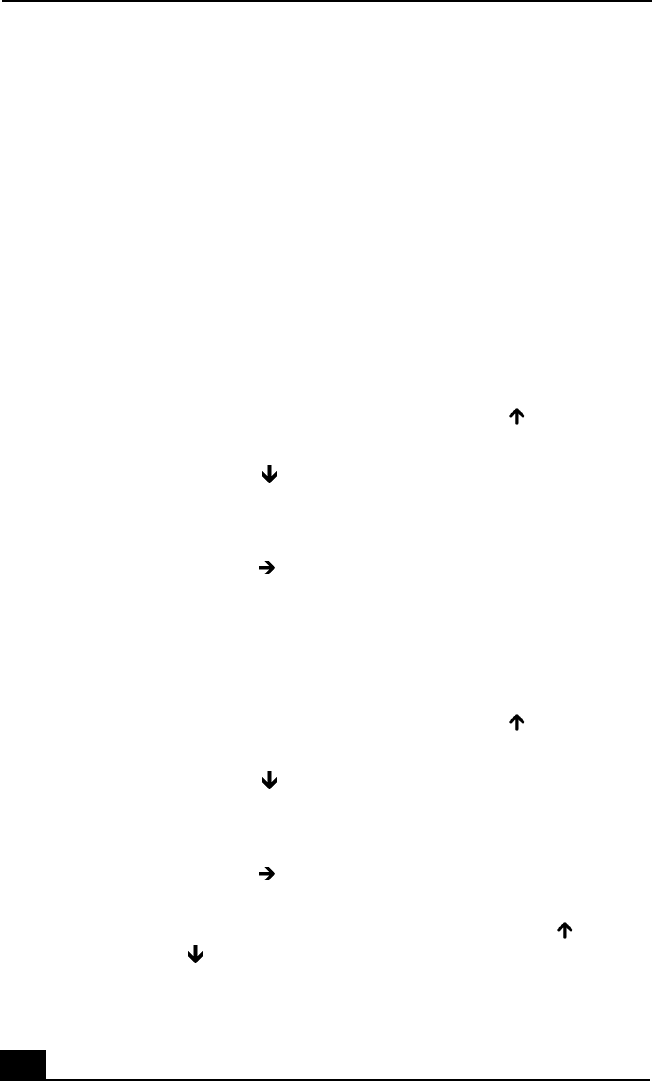
Change text in this variable definition to document title.
120
Troubleshooting the Mouse and Touchpad
My mouse does not work.
❑Make sure the mouse is securely plugged into the USB port. See
“Connecting a USB Device” for more information.
❑If you are still experiencing problems, use your supplied Application
Recovery CD to reinstall the mouse drivers. See “To use the Application
Recovery CD(s)” for more information.
My touchpad does not work properly.
❑You may have disabled the touchpad without connecting a mouse to the
computer. To enable the touchpad:
1Press the Windows key, and then press the Up Arrow key to select
All Programs. Press Enter.
2Press the Down Arrow key to select Sony Notebook Setup, and press
Enter.
3Make sure Sony Notebook Setup is selected, and press Enter.
4Press the Right Arrow key to select the Touchpad tab.
5Press the Tab key to select Enable Touchpad, and press Enter.
❑Restart the computer to activate the touchpad again.
❑If your touchpad is interpreting a single tap as a double-click, adjust the
button assignments. Follow these steps:
1Press the Windows key, and then press the Up Arrow key to select
All Programs. Press Enter.
2Press the Down Arrow key to select Sony Notebook Setup, and press
Enter.
3Make sure Sony Notebook Setup is selected, and press Enter.
4Press the Right Arrow key to select the Touchpad tab, and press
Alt+S simultaneously.
5Make sure the Buttons tab is open, and press the Up Arrow and
Down Arrow keys to change the button assignments.
6Press Enter to save your changes and close the dialog box.
Kingfisher Draft 2

Troubleshooting the Mouse and Touchpad
121
❑If you are still experiencing problems, check that another mouse was not
installed.
❑You may need to use your Application Recovery CD(s) to reinstall the
mouse drivers. See “To use the Application Recovery CD(s)” for more
information.
The pointer does not move when I use the Touchpad or
Mouse.
❑You should restart your computer. Follow these steps:
1Press the Windows key.
2Press U. The Turn off computer window opens.
3Press R to restart the computer.
❑If the computer does not restart,
1Press Ctrl+Alt+Delete simultaneously. The Windows Task Manager
dialog box appears.
2Press Alt to highlight the menu bar, and press the Right Arrow key to
select Shut Down.
3Press Enter.
4Press R to restart the computer.
❑If you still cannot restart your computer, press and hold the power button for
more than four seconds to turn off the computer.
❑If the pointer does not move while playing a disc, press Ctrl+Alt+Delete
simultaneously to stop playback. Restart the computer by pressing Alt+U to
display the Shut Down menu, and press R to restart the computer.
❑If you are still experiencing problems, make sure another mouse was not
installed.
❑You may need to use your supplied Application Recovery CD(s) to reinstall
the touchpad or mouse drivers. See “To use the Application Recovery
CD(s)” for more information.
Kingfisher Draft 2

Change text in this variable definition to document title.
122
Troubleshooting Drives, PC Cards, and
Peripheral Devices
My floppy disk drive icon doesn’t appear even though it is
connected.
❑Make sure the floppy disk drive is properly connected. Wait a few moments
for the computer to recognize the drive.
❑Close all open applications, and make sure there is no disk in the floppy disk
drive. Restart your computer with the connected floppy disk drive.
My floppy disk drive cannot write to a floppy disk.
❑If the floppy disk is write-protected, disable the write-protect feature or use a
floppy disk that is not write-protected.
❑Make sure a formatted floppy disk is properly inserted into the floppy disk
drive.
My optical drive is not playing my CD or DVD properly.
❑Make sure the disc label is facing up.
❑If the disc requires software, make sure the software is installed according to
the manufacturer’s instructions.
❑A dirty or damaged disc may cause the computer to stop responding while it
tries to read the disc. If necessary, restart the computer, remove the disc, and
check the disc for dirt or damage.
❑If you see video but cannot hear audio, do the following:
❑Make sure your optical drive does not have the mute setting enabled.
❑Check the volume setting in the audio mixer.
❑If you are using external speakers, check the volume settings, and then
check the connections between your external speakers and the
computer.
❑Click Start on the taskbar, and then Control Panel, Performance and
Maintenance, and System. Select the Hardware tab, and click Device
Manager. Make sure the correct drivers are properly installed.
❑Do not use adhesive labels to identify the CD. The label may come off while
the disc is in use in the optical drive and cause the drive to malfunction.
Kingfisher Draft 2

Troubleshooting Drives, PC Cards, and Peripheral Devices
123
❑If a region code warning appears when you try to use your optical drive, it
may be that the DVD you are trying to play is incompatible with the optical
drive. Verify the region code listed on the DVD package.
❑Condensation may cause the computer to malfunction. If this occurs, do not
use it for at least one hour.
❑Make sure the digital CD audio is enabled for your optical drive. Follow
these steps:
1Click Start on the taskbar, and then Control Panel, Performance and
Maintenance, and System. The System Properties dialog box appears.
2Select the Hardware tab, and then click Device Manager. The Device
Manager dialog box appears.
3Double-click the listed DVD/CD-ROM drive. The Properties window
opens.
4Click the Properties tab, and then select the “Enable digital CD audio
for this CD-ROM device” check box.
Why does it take longer for the optical disc drive to read some
types of CDs?
The reading speed for a CD-RW is slower than the reading speed for a CD-ROM
or CD-R because these discs are formatted differently.
My optical drive tray does not open.
❑Make sure the computer is turned on.
❑Press the Eject button on the optical drive.
❑If the Eject button does not work, open the tray by inserting a thin, straight
object (such as a paper clip) in the hole to the right of the Eject button.
I cannot use Digital Video (DV) devices. The message “DV
equipment seems to be disconnected or turned off” appears.
❑Make sure the DV device is turned on and the cables are properly connected.
❑If you are using multiple i.LINK®* devices, the combination of the
connected devices may cause unstable operation. Follow these steps:
1Turn off your computer and all connected devices.
Kingfisher Draft 2

Change text in this variable definition to document title.
124
2Disconnect the devices that are not in use.
3Ensure that all other devises are properly connected.
4Restart your computer.
❑Disconnect the i.LINK® cable and connect it again.
My PC Card does not work.
❑Make sure the PC Card is installed properly.
❑Make sure the PC Card is compatible with the Microsoft® Windows®
operating system.
❑Use the Sony Notebook Setup utility to disable devices you are not currently
using.
❑Make sure any necessary drivers were installed properly. See “To use the
Application Recovery CD(s)” for more information.
* i.LINK is a trademark of Sony used only to designate that a product contains an IEEE 1394
connection. The i.LINK connection may vary, depending on the software applications, oper-
ating system, and compatible i.LINK devices. All products with an i.LINK connection may
not communicate with each other. Refer to the documentation that came with your compati-
ble i.LINK device for information on operating conditions and proper connection. Before
connecting compatible i.LINK PC peripherals to your system, such as CD-RW or hard disk
drive, confirm their operating system compatibility and required operating conditions.
Kingfisher Draft 2

Troubleshooting the Software
125
Troubleshooting the Software
My software program stops responding or crashes.
Contact the software publisher or designated provider for technical support. See
“Software Support Information” for contact information.
When I click an application icon, the message “You must
insert the Application CD into your optical drive” appears, and
the software does not start.
❑Some titles require specific files that are located on the Application
Recovery CD. Insert the disc, and try starting the program again.
❑Make sure you place the CD in the tray with the label side facing up.
❑Make sure the optical drive is connected to your computer. See “Using the
Optical Disc Drive” for more information.
The application cannot find a file while a PC Card is inserted.
When inserted into a computer that is connected to the docking station, some PC
Cards may change the drive letters of the disk drives in the docking station. If this
occurs, an application you are using may not be able to find files.
To correct this condition, do one of the following:
❑Remove the PC Card, and restart your computer. Do not insert the PC Card
while using that application.
❑Change the drive letters of the disk drives of the docking station or of the PC
Card. Refer to the Windows® help files or the application manuals to change
the drive letters.
What software do I use for CD-R/CD-RW software functions?
Using the preinstalled SonicStage software’s Record function to create CDs on
your VAIO® computer, if the specific model you purchased is preconfigured
with all of the necessary components for CD-R and CD-RW capability.
Kingfisher Draft 2

Change text in this variable definition to document title.
126
I cannot use the DVgate software.
If your computer is using the Ultimate Battery Life profile for its power saving
mode, you cannot use DVgate™ or Smart Connect software. Please select
another profile. Preferably, connect your computer to AC power when using
these features.
Kingfisher Draft 2

Troubleshooting i.LINK Devices
127
Troubleshooting i.LINK Devices
I cannot establish a connection between two VAIO computers
when using an i.LINK cable.
1Disconnect the i.LINK®* cable from both computers and reconnect it.
2Wait for the computers to respond. If neither computer responds after a few
moments, restart both computers.
* i.LINK is a trademark of Sony used only to designate that a product contains an IEEE 1394
connection. The i.LINK connection may vary, depending on the software applications, oper-
ating system, and compatible i.LINK devices. All products with an i.LINK connection may
not communicate with each other. Refer to the documentation that came with your compati-
ble i.LINK device for information on operating conditions and proper connection. Before
connecting compatible i.LINK PC peripherals to your system, such as CD-RW or hard disk
drive, confirm their operating system compatibility and required operating conditions.
✍The computers may not recognize an i.LINK connection after returning from a
power saving mode (Standby or Hibernate). If that happens, restart both computers
to establish a connection.
Kingfisher Draft 2

Change text in this variable definition to document title.
128
Troubleshooting the Modem
My modem does not work.
❑Make sure the telephone cable is plugged into the cable jack. See “Using a
Telephone Cable” for more information.
❑Make sure the telephone cable is working by plugging the cable into an
ordinary telephone and listening for a dial tone.
❑Make sure the telephone number the program is dialing is correct.
❑Make sure the software you are using is compatible with the computer’s
modem. (All preinstalled Sony programs are compatible.)
❑If you are still experiencing problems, use the supplied Application
Recovery CD(s) to reinstall the modem drivers. See “To use the Application
Recovery CD(s)” for more information.
My modem connection is slow.
Your computer is equipped with a V.90 compatible modem. Many factors may
influence modem connection speed, including telephone line noise or
compatibility with telephone equipment (such as fax machines or other modems).
If you think your modem is not connecting properly to other PC-based modems,
fax machines, or your Internet service provider (ISP), do the following:
❑Ask your telephone company to verify your telephone cable is free of any
line noise.
❑If your problem is fax-related, make sure there are no problems with the fax
machine you are calling and that it is compatible with fax modems.
❑If you are having a problem connecting with your ISP, make sure the ISP is
not experiencing technical problems.
❑If you have a second telephone line available, try connecting the modem to
that line.
Kingfisher Draft 2

Troubleshooting Audio
129
Troubleshooting Audio
My speakers have no sound.
❑If the built-in speakers are turned off, press Fn+F3 or use the center Jog
Dial™ Control to turn on the speakers.
❑If the speaker volume is turned to the minimum, press Fn+F4, and then press
Up Arrow or Right Arrow keys to increase the volume. You can also
use the center Jog Dial Control to adjust the volume.
❑If nothing is displayed when you press Fn+F3 or Fn+F4, follow these steps:
1Right-click the Volume icon on the taskbar, and select Adjust Audio
Properties.
2Select the Audio tab, and click Advanced in the Sound Playback box.
The Advanced Audio Properties dialog box appears.
3Make sure the Speakers tab is open and the correct speaker setup is
selected in the Speaker Setup box.
❑Check the volume controls in the Windows® taskbar.
1Right-click the Volume icon on the taskbar, and select Open Volume
Control. The Volume Control dialog box appears.
2Make sure the mute check boxes are not selected. If they are selected,
click the check box to cancel the selection.
3Close the Volume Control dialog box.
❑Make sure the CD audio enable is turned on
1Click Start on the Windows® taskbar, and then Control Panel.
2Click Performance and Maintenance, and then System. The System
Properties dialog box appears.
3Select the Hardware tab, and then click Device Manager. The Device
Manager dialog box appears, listing your computer hardware devices.
4Double-click DVD/CD-ROM drives.
5Double-click the listed drive name.
6Click the Properties tab.
Kingfisher Draft 2

Change text in this variable definition to document title.
130
7If the “Enable digital CD audio for this CD-ROM device,” check box is
not selected, click it to turn it on.
❑If your computer is powered by batteries, make sure the battery packs are
properly inserted and are charged.
❑If you are using an application that has its own volume control, verify the
volume is turned up.
❑If you connect external speakers:
❑Make sure the speakers are properly connected and the volume is turned
up loud enough to hear sound.
❑If the speakers have a mute button, make sure the button is off.
❑If the speakers are powered by batteries, make sure the batteries are
inserted properly and are charged.
❑If you have connected an audio cable to the Headphone jack, disconnect the
cable.
❑If you are still experiencing problems, use the Application Recovery CD(s)
to reinstall the drivers. See “To use the Application Recovery CD(s)” for
more information.
There is noise distortion while listening to music with USB
speakers or USB headphones.
Use the preinstalled PowerPanel™ software to set the CPU control to
Performance. Follow these steps:
1Right-click the CPU: Performance Profile icon on the bottom right of the
taskbar, and click Edit/Create Profiles. The Profile Editor dialog box
appears.
2In the left portion of the window, click the power management profile you
want to set. Maximum Battery Life is the default selection when your
computer runs on battery power.
3In the right portion of the window, double-click CPU Control. The list of
CPU control options appears.
4Click Performance.
5Click the File menu, and select Save.
6Close the Profile Editor window.
Kingfisher Draft 2

Troubleshooting Audio
131
My microphone does not work.
If you are using an external microphone, make sure the microphone is plugged
into the Microphone jack. See “Connecting an External Microphone” for more
information.
Kingfisher Draft 2

Change text in this variable definition to document title.
132
Troubleshooting Memory Stick Media
I cannot open image files.
❑If the Sony MemoryStick dialog box does not appear when you first insert a
Memory Stick media, you can:
1Click Start, and then My Computer. The My Computer window appears.
2Click the Sony MemoryStick icon. If your images are not stored in a
folder, your images should appear in the Sony MemoryStick window.
Click the Left or Right arrows to view images. If your images are
stored in a folder, open the folder to view your images.
❑The format of your Memory Stick media may not be compatible with the
software you are using to view your image files. When you reformat your
Memory Stick media, you lose the images and data stored on that media.
Copy the data from the Memory Stick media onto the hard disk drive of your
computer to save your images and data. Reformat the Memory Stick media
using Memory Stick Formatter software preinstalled on your computer. See
“Formatting Memory Stick media” for more information.
Memory Stick media does not work. I cannot access the
removable drive.
To locate the Memory Stick media icon in your My Computer folder
1Click the View menu, and select Refresh.
2Wait a few moments for the computer to recognize the Memory Stick media.
3Click the Sony MemoryStick icon.
Kingfisher Draft 2

Troubleshooting Wireless LAN Functions
133
Troubleshooting Wireless LAN Functions*
The computer cannot connect to a Wireless LAN Access
Point.
Connection availability is affected by distance and obstructions. You may need to
move your computer away from obstructions or closer to any access point you
may be using.
❑Make sure the Wireless LAN switch on the computer is in the ON position or
the Wireless LAN PC Card is properly inserted.
❑Make sure power to the access point is on.
❑Make sure the access point is displayed in the “Available networks” window.
1Click Start, and select Control Panel.
2Click Network and Internet Connections, and then Network
Connections.
3Right-click Wireless Network Connection, and select Properties. The
Wireless Network Connection Properties dialog box appears.
4Select the Wireless Networks tab, and check if the access point is
displayed in the Available networks box.
❑Make sure the encryption key is correct.
I cannot access the Internet.
❑Make sure the Wireless LAN switch on the computer is in the ON position or
the Wireless LAN PC Card is properly inserted.
❑Check the access point settings. Refer to the instructions supplied with the
access point.
❑Check if your computer and the access point are connected to one another.
❑Move your computer away from obstructions or closer to any access point
you may be using.
* Wireless LAN functionality is available on selected models only.
Kingfisher Draft 2

Change text in this variable definition to document title.
134
The data transfer speed is slow.
❑The Wireless LAN data transfer speed is affected by distance and
obstructions between devices and access points. Other factors include device
configurations, radio conditions, and software compatibility. To maximize
the data transfer speed, move your computer away from obstructions or
closer to any access point you may be using.
❑If you are using a Wireless LAN Access Point, the device may be
temporarily overloaded depending on the number of other devices
communicating via the access point.
❑If your access point interferes with other access points, change the access
point channel. See your access point instructions for more information.
The communication speed is interrupted or slowed down
when MPEG2 data is transferred.
The typical effective data transfer speed via an access point is 4-5 Mbps when
adhering to the IEEE 802.11b standard. High-rate stream transfers with MPEG2
data may lower this rate.
Data transfers are interrupted.
Data transfer interruptions may occur with large files or use of microwaves and
cordless telephones when connected to an access point.
To avoid data transfer interruptions
❑Move the computer closer to the access point.
❑Make sure the access point connection is intact.
❑Right-click the Wireless Network Connection icon on the taskbar,
and click Status. The Wireless Network Connection Status dialog box
appears.
❑Change the access point channel. See your access point instructions for more
information.
Kingfisher Draft 2

Troubleshooting the Printer
135
Troubleshooting the Printer
I cannot print.
❑Make sure the printer is on, and the printer cable is securely connected to
both the printer and your computer.
❑Make sure the printer is compatible with the Windows® operating system
installed on your computer and that it has the correct printer drivers.
❑Your connected printer may not function after the computer resumes from a
power saving mode.
❑The default setting for the printer port mode is correct for most printers. If
you cannot print, try changing the printer port number.
1Click Start on the Windows taskbar, and then Control Panel.
2Click Performance and Maintenance, and then System. The System
Properties dialog box appears.
3Select the Hardware tab, and click Device Manager. The Device
Manager dialog box appears.
4Double-click Ports (COM&LPT), and then ECP Printer Port (LPT1).
5Select the Port Settings tab, and choose a different LPT Port Number.
To reset the printer connection
1Click Start on the taskbar, and select Control Panel.
2Click Printers and Other Hardware, and then click Printers and Faxes.
3Right-click on the icon of the printer that is not functioning, and select
Properties to open the Properties window.
4Click OK.
Kingfisher Draft 2

Change text in this variable definition to document title.
136
Kingfisher Draft 2

137
Getting Help
Sony provides you with several support resources to answer questions
about your VAIO® computer or the preinstalled software. Refer to these
resources in the order they are listed.
Support Options
If you have questions about your computer or the preinstalled software, refer to
the following sources for answers in the sequence listed below.
1VAIO® Computer User Guide
The online VAIO® Computer User Guide and the printed VAIO®
Computer Quick Start provide you with information on how to maximize
your notebook capabilities and solve common problems. You can also
push the Help button located on the top right corner of your computer to
access VAIO® Help and Support.
2 Software Manuals and Online Help Files
The software preinstalled on your notebook may come with an online
manual. These manuals are stored on the hard disk drive as online Help
files. You can find the Help files from the Help menu under the specific
software application. Some software applications may come with a
printed manual.
3 Operating System Online Support
Your computer comes preinstalled with Microsoft® Windows®. For
operating system support, you can access Microsoft® customer support
at: http://support.microsoft.com/directory/.
Kingfisher Draft 2

VAIO® Computer Quick Start
138
4 VAIO Support Agent
You can find VAIO Support Agent by clicking Start and selecting Help
and Support. Using advanced diagnostic technology, Sony’s VAIO
Support Agent runs scheduled protections of your applications, network
settings, and other important software settings. When your software is
protected, you can use VAIO Support Agent to repair software problems
by restoring your software to any of the previously protected states.
5 Sony Computing Support
This service provides instant access to information on commonly
encountered problems. Enter a description of your problem and the
Knowledge Database searches for the corresponding solutions online.
You can access Sony Computing Support at:
http://www.sony.com/pcsupport.
6 Sony Fax-on-Demand
This service, which requires a fax machine or your fax software, provides
answers to commonly asked questions. You can use this automated
service to request a list of available topics, and select the topics that you
want to receive. To contact the Sony fax-on-demand service, call:
1-888-4-SONY-PC (1-888-476-6972).
7 Sony Customer Support
Software support is available free of charge for 90 days after the original
date of purchase. You can call and speak with a Sony Customer Support
Representative without using your computer by calling:
1-888-4-SONY-PC (1-888-476-6972).
8 Sony Service Center
For the Sony Service Center nearest you, call 1-888-4-SONY-PC
(1-888-476-6972) or find Sony Customer Service on the Web at
http://www.sony.com/pcsupport.
Kingfisher Draft 2

1
Index
A
About This Computer tab 75
AC Profile power setting 78
Access Point, Wireless LAN 71
adding
hardware 53
memory 87
peripherals 53
printers ??–55, 56–??
Alt key 13
Application Recovery CD 107
Applications key 13
audio
connecting 57
connecting external speakers 67
external microphone 68
troubleshooting 129
Audio tab 75
audio-video (AV)
connecting 58
B
Basic/Advanced tab 75
Battery Information toolbar 81
battery pack
Battery Information toolbar 81
power management settings 76
power saving modes 41
battery packs
charge status icons 82
indicator lights 15
brightness
adjusting 16
built-in speakers
See also speakers 16
buttons
Eject 25
C
cameras
digital video recorder 60
canceling commands 13
Caps Lock
indicator light 15
CD/DVD discs
ejecting 26
inserting 25
CD-RW/DVD Combo Drive or DVD-
ROM drive 25
coin-operated telephones 43
computer
connecting to another 65
customizing 73
expanding capabilities of 71
online support 137
setup screen 74
troubleshooting 114, 125
connecting
another computer 65
audio device 57
coin-operated telephones 43
digital video recorder 60
external speakers 67
hard drives 30
i.LINK device 60
Local Area Network (LAN) 44
Kingfisher Draft 2

Change text in this variable definition to document title.
2
microphone 68
monitor 62
multimedia computer display 62
multiple phone lines 43
network 30
party phone lines 43
PBX 43
phone line 43
printer ??–55, 56–??
TV/VCR 58
USB device 54
correction keys 13
Ctrl key 13
cursor-movement keys 13
customizing your computer 73
D
digital video camera 60
display
mode 84
options 64
selecting 64
Driver Recovery CD 108
drives
installing additional hard disk 30
optical 25
troubleshooting 122
DV In/Out 60
DVD-ROM drive tray
troubleshooting 123
E
Eject button 25, 26, 40
ejecting
CD/DVD discs 26
floppy disks 40
weight saver 38
Escape key 13
expanding your notebook capabilities
71
expansion memory configuration 89
external devices
display 64
display, see also monitor 62
speakers 16, 67
external display
connecting 62
F
floppy disk drive
troubleshooting 122
floppy disks
ejecting 40
handling 40
troubleshooting 122
Fn key 13
combination commands 16
function keys 13
G
getting help 137
Guide Mode 23
H
handling
floppy disks 40
hard drives
indicator light 15
installing additional 30
help 137
Hibernate mode 17, 41
I
i.LINK 60
connecting 60
VAIO Action Setup 20
IEEE 1394 60
indicator lights 15
battery 15
Caps Lock 15
hard disk 15
Num Lock 15
Kingfisher Draft 2

3
Scroll Lock 15
indicators 15
Insert key 13
installing
hard drives 30
hardware 53
memory module 92
peripherals 53
J
Jog Dial
using 21
VAIO Action Setup 20
K
keyboard
key combinations 14, 16
using 12
L
LAN
see Local Area Network
Launcher Mode 22
LCD
selecting to display output 64
troubleshooting 118
Local Area Network
connecting 44
M
MagicGate 32
Maximum Battery Life power setting
77
Maximum Performance power setting
77
memory
adding 87
memory module
expansion 89
installing 92
removing 90
Memory Stick
troubleshooting 132
using 32
VAIO Action Setup 20
Memory Stick media 32
displaying contents 33
inserting 33
microphone
connecting 68
troubleshooting 131
modem
troubleshooting 128
monitor
connecting 62
selecting 64
switching among 16
mouse
troubleshooting 120
Mouse Properties 19
multimedia
audio device 57
multimedia computer display 62
multiple phone lines 43
N
navigation keys 13
network
connecting 30
Notebook Setup tabs 75
Num Lock
indicator light 15
O
online support 137
operator keys 13
optical disc drive
closing tray 26
opening tray 25
optical discs
ejecting 26
optical drive
Kingfisher Draft 2

Change text in this variable definition to document title.
4
using 25
output devices
adding ??–55
P
party phone lines 43
PBX 43
PC Card
inserting 30
troubleshooting 122
using 30
Wireless LAN Access Point 71
PDA 71
peripheral devices
troubleshooting 122
Personal Digital Assistant 71
phone
connecting line 43
ports
printer ??–55, 56–??
power 15
power management
settings 76
Power Management Off power setting
77
Power On
Password tab 75
power saving modes 41
Hibernate 17, 41
Normal mode 41
notes 42
Standby 41
power setting
AC Profile 78
Maximum Battery Life 77
Maximum Performance 77
Power Management Off 77
PowerPanel
customizing toolbar 77, 79
Print Screen key 13
printer
connecting ??–55, 56–??
port ??–55, 56–??
troubleshooting 135
Printer tab 75
R
Recovery CDs 107
removing
floppy disks 40
memory module 90
restoring data 107
S
Scroll Lock
indicator light 15
Search window 14
selecting
display 64
LCD 64
monitor 64
setup screen
About This Computer tab 75
Audio tab 75
Basic/Advanced tab 75
displaying 74
Power On Password tab 75
Printer tab 75
Touchpad tab 75
setup tabs 75
Shift key 13
Smart Connect 65
software
changing window design 86
Smart Connect 65
support information 102
troubleshooting 125
Software list 95
Sony Fax-on-Demand 138
Sony Notebook Setup screen 74
Kingfisher Draft 2

5
Sony Service Center 103
speakers
external 67
switching 16
troubleshooting 129
volume 16
Standby mode 41
support
software 102
support, Sony 137
switching
display 16
monitor 16
System Recovery CD 109
T
technical support 137
touchpad 18
troubleshooting 120
Touchpad tab 75
troubleshooting 114
audio 129
drives, PC Cards, and peripherals
122
LCD screen 118
Memory Stick media 132
modem 128
mouse and touchpad 120
printer 135
software 125
TV or a video deck 58
TV or video deck 58
TV/VCR 58
U
USB
connecting 54
mouse 54
port 54
using 18
Jog Dial 21
keyboard 12
Memory Stick 32
optical drive 25
touchpad 18
using PC Card 30
Using the Jog Dial Control 24
V
VAIO
help 14
VAIO Action Setup 20
video camera 60
volume control 16
W
weight saver
removing 38
window design of Sony software 84
Windows
Explorer 14
key 13
key combinations 14
Wireless LAN 46
Wireless LAN Access Point 71
Kingfisher Draft 2


